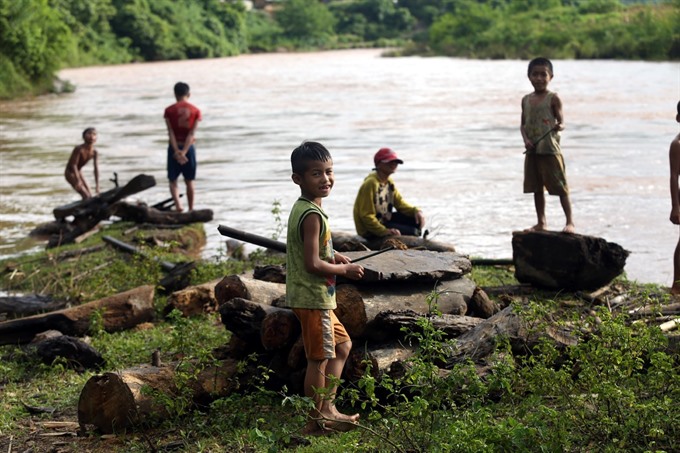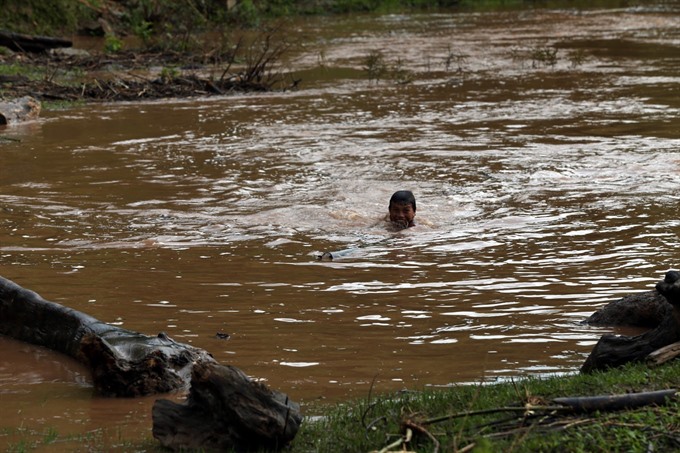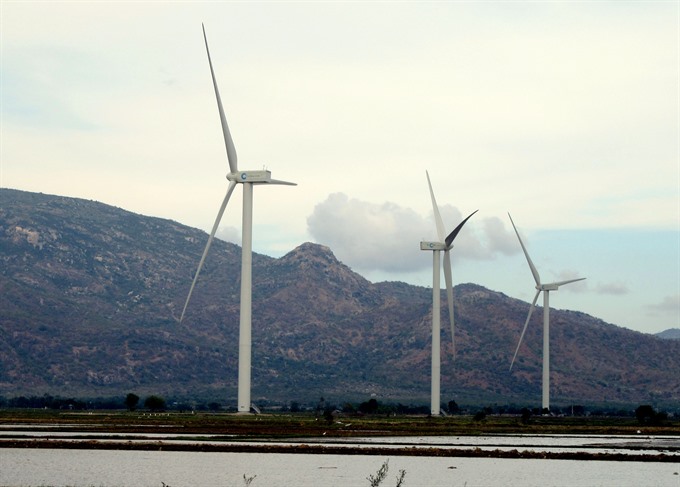Social News 30/7 Eight outstanding works honoured at Vietnam Glory 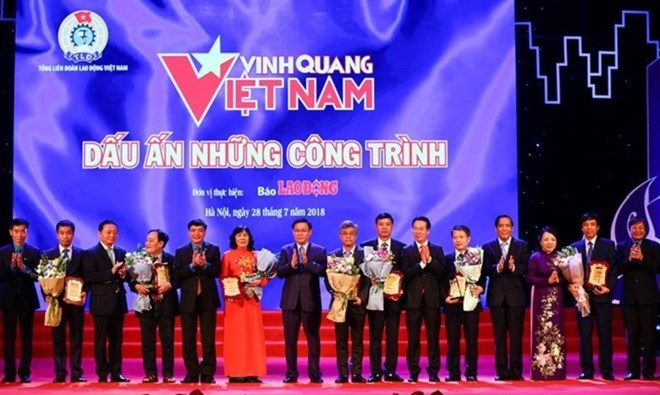 Eight outstanding works of Vietnam honoured at programme entitled “Vietnam Glory” Eight outstanding works of Vietnam were honoured at a programme entitled “Vietnam Glory” held by the Vietnam General Confederation of Labour (VGCL) in Hanoi on July 28. The event is part of the activities to mark the 89th founding anniversary of the Vietnam Trade Union (July 28, 1929-2018) and welcome the 12th Vietnam Trade Union Congress. The outstanding works are Vietnam's telecom satellites (VINASAT-1, VINASAT-2), the North-South 500kV transmission line, the Hoa Binh Hydropower Plant, the Ho Chi Minh Road, selection and development of two news rice varieties of high quality and productivity, OM6976 and OM5451, Vietnam encyclopedia, Vietnam's 1:200,000 geological map and mineral resources map, and the National Expanded Immunisation Programme. Addressing the event, Deputy Prime Minister Vuong Dinh Hue praised the significant contributions made by those who developed the works, and described the eight outstanding works as honest symbols and vivid evidence of the Vietnamese intellectuals’ daring to think, do and contribute to society. He called on Vietnamese intellectuals to continue creating more meaningful works, which would become proud examples of the will and intellect of Vietnamese people. According to VGCL President Bui Van Cuong, the previous 13 versions of the “Vietnam Glory” programme recognised and honoured the collectives and individuals with outstanding achievements in national building and safeguarding, thereby sparking the spirit of patriotism, determination and creative labour for the development of the country, and for the goal of building a strong nation of wealthy people and a democratic, equal and civilised society. From the beginning of 2018, the VGCL proposed the idea of selecting exemplary works which have left bold marks and contributed significantly to the national construction and defence cause from 1975 until now. Vietnam joins Asia cultural festival in Slovakia 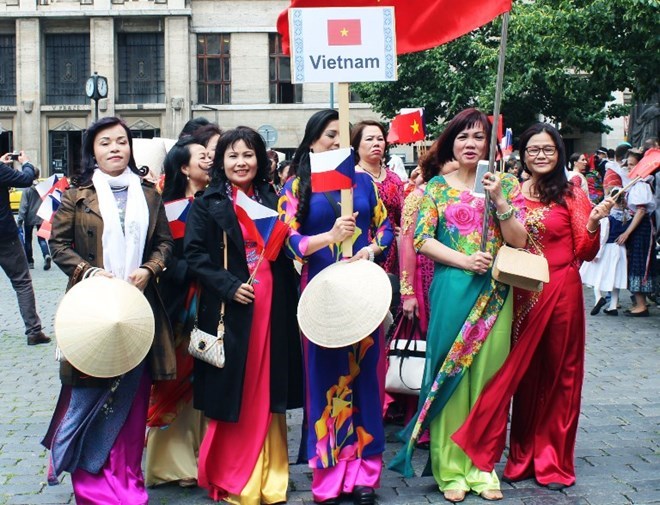 The embassies of Asian countries in Slovakia and the authority of Bratislava held Asia Weekends in the capital city on July 27-28 to promote the diversity of Asian cultures, including Vietnamese culture. Addressing the opening ceremony, Slovakian Deputy Foreign Minister Lukas Parizek said that the event aims to foster the friendship and solidarity among Asian countries and between Slovakia and these nations. This is a chance for Slovakian people to get better understanding of unique and diverse cultures of Asian countries, he said. He expressed his hope that in the coming time, such events will be expanded to strengthen mutual understanding. Meanwhile, Vietnamese Ambassador in Slovakia Duong Trong Minh said that through the event, the Vietnamese Embassy in Slovakia hopes to promote the Vietnamese culture, cuisine and famous natural landscapes to Slovakian people, thus attracting more tourists from the East European country. He held that Vietnamese foods are loved by Slovakian people, noting that the number of Vietnamese restaurants serving traditional dishes of Vietnam such as “pho” (noodle) and “nem” (spring roll) is increasing in Bratislava. During the event, Asian countries such as India, Japan, the Republic of Korea and Indonesia also contributed various art performances. Vietnamese music and traditional costumes were also introduced, impressing visitors. Association of war veterans in Germany established 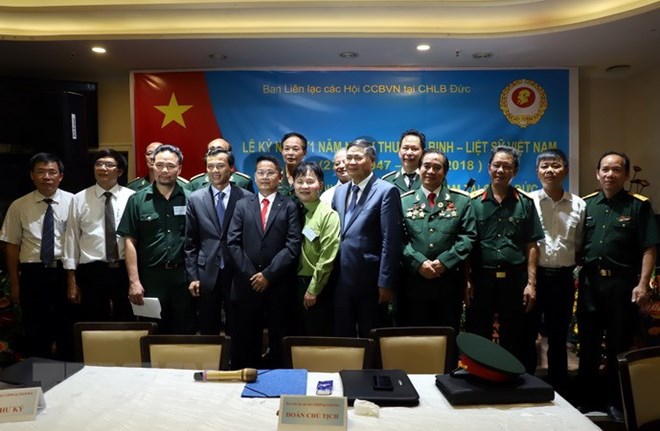 Vietnamese war veterans in Germany celebrate 71st War Invalids and Martyrs' Day (July 27) in Berlin The association of Vietnamese veterans in Germany has made its first public appearance at a recent congress in Berlin on the occasion of the 71st War Invalids and Martyrs’ Day (July 27). The association is expected to embrace links between Vietnamese expatriates in the European country, including former soldiers. Participants at the congress, held on July 28, adopted regulations, plans and orientations of activities for the association’s first tenure in 2018-2020. Nguyen Quang Anh was elected as President of the association. Vice Chairman of the State Committee for Overseas Vietnamese Luong Thanh Nghi said the association represents the will and aspirations as well as legitimate rights and interests of the veterans. The establishment of the association is also to recognise the significant contributions of the veterans in the country’s resistance wars and peacetime, he added. It is hoped to promote solidarity, friendship and cooperation between the people of Vietnam and Germany. Digital technology helps poor people access banking services  Transactions in progress at a VPBank branch (Illustrative image) The application of digital technologies in providing banking services has proven effective, not only bringing better experience to urban customers but also helping banks introduce their services to low-income households. Statistics from the Ministry of Information and Communications show that Vietnam now has 123.91 million mobile subscribers, up 4.3 million compared to that in early this year. This is said to be a good chance for banks to develop mobile banking services, thus expanding their customers’ group, especially poor households and women. Speaking at a recent workshop on mobile banking for the poor and women held in Hanoi, Luu Thi Thao, deputy director of the Vietnam Bank for Social Policies (VBSP)’s Centre for Information and Technology, said the bank has piloted SMS services for its borrowers in all branches nationwide. The service has helped save time and costs for both customers and banks. According to the VBSP, the bank provides the SMS service to its customers in all the 63 cities and provinces nationwide since 2016, helping them save more than 42.8 billion VND (over 1.84 million USD). The service costs the bank 250 VND per SMS, thus reducing their operation costs by 12 times. The service helps households regularly get updates on the loans, such as payment deadlines and term deposits through texts on their mobiles. The VBSP has identified SMS services as one of the effective tools to help poor households get acquainted with digital technologies, help the bank diversify its products and services, and improve its operation efficiency, Thao noted. The bank plans to apply the mobile banking service to 850 loan and savings groups with 30,000 borrowers, she added. With the advantages brought about by mobile phones, many banks in Vietnam have been promoting the development of mobile banking services, making the access to banking services easier for people living in remote areas. Dinh Xuan Ha, Head of the Division of Research and Development of Financial Institutions of the Banking Strategy Institute under the State Bank of Vietnam (SBV), said the digital technology would help banking services become acceptable for low-income customers, thus increasing the number of users. The technological application will also create a momentum to promoting comprehensive finance, he added. Ha Hai An, Deputy Director of the International Cooperation Department under the SBV, said the application of digital technology in providing banking products and services has helped reduce costs and increase utility and convenience for customers. Banks in general and the VBSP in particular have well deployed policy credit programmes to help poor households and policy beneficiaries access preferential capital sources, contributing to promoting sustainable poverty reduction, ensuring social security, and creating strong changes in advantaged and ethnic minority areas. The SBV is building a national comprehensive financial strategy which values digital technologies of banks and credit institutions. The ultimate target is to popularise access and use of financial products and services, especially to poor people. Bodies of two pilots recovered after military aircraft crash  The location where the Su-22U military aircraft crashed on Thursday in Nghệ An Province. Rescue forces on Thursday night recovered the bodies of two pilots whose military aircraft crashed in the central province of Nghệ An’s Dừa Village, according to the High Command of Military Region 4. Their remains were taken to the Funeral Home of Military Region 4, located in Vinh City. On Friday morning, the Ministry of Defence, Air Defence and local authorities held a memorial ceremony for the two airmen. The air force and families of the two pilots will hold a funeral for the pair at the mortuary of the Military Medicine Hospital No 4 in Vinh City, Nghệ An Province on Saturday morning. Their remains will then be taken back to their hometowns in Hà Nội and Thái Bình Province. The authorities, meanwhile, continued their search on Friday morning at the scene for the remaining pieces of the aircraft. They have also found the black box of the aircraft, which will provide crucial data to find out the reason behind the crash. The pilots died when their military aircraft crashed in Nghệ An Province on Thursday afternoon after losing contact during a training session. Workshop underlines importance of collective bargaining 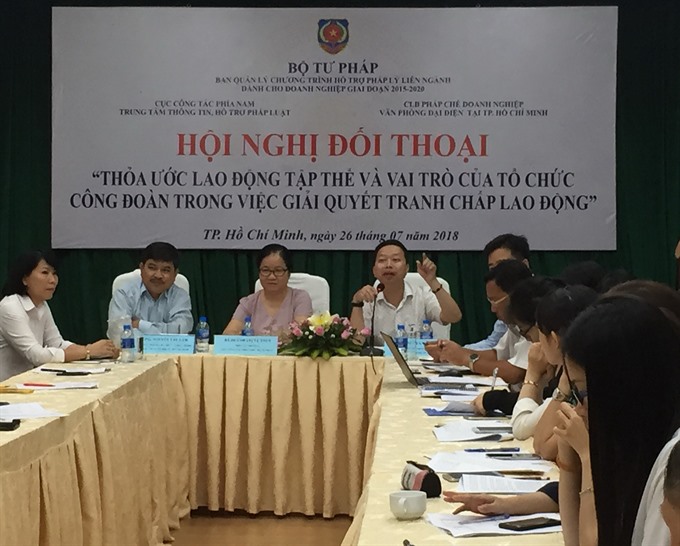 Representatives of trade unions at 70 firms in HCM City and neighbouring provinces participated in a workshop on Thursday (July 26) on collective agreements. In the context of the relentless global integration, trade unions need to modernise their organisation and functions to better represent workers through collective bargaining, labour officials have said. To comply with the requirements of the Comprehensive and Progressive Agreement for Trans-Pacific Partnership (CPTPP) and EU-Việt Nam Free Trade Agreement, and more importantly to fulfill its obligations as an ILO member state, Việt Nam needs to respect and promote the 1998 ILO Declaration, particularly Convention 98 on the right to collective bargaining, Nguyễn Tất Năm, head of labour- wage- social insurance office at HCM City’s Department of Labour, Invalids and Social Affairs, said. Collective bargaining provides the basis for sound labour relations, he told a workshop held on July 26 to guide attendees on the concept. Typical issues on the bargaining agenda include salaries, bonuses, allowances and salary hikes; working hours, overtime and breaks; training; and occupational health and safety, he said. Việt Nam has a fairly comprehensive legal framework for collective bargaining and collective agreements though significant limitations remain, he said. On the employees’ side, trade unions are the only bodies permitted to represent employees’ interests and bargain on their behalf. But trade union leaders are usually managers of those very companies, he added. Trần Văn Trí, a partner at FUJILAW, said labour unions should be independent and free from interference of employers to secure employees’ benefits. However, it is not uncommon to find that trade union leaders are managers or human resource officials, he said. Employees must be educated about their right to participate in the process of collective agreement, which is described in the Labour Code, he said. Between 2012 and 2016, more than 27,800 collective agreements were signed, according to the city’s Department of Labour, Invalids and Social Affairs. The number of firms that have signed collective agreements account for 66 per cent of firms with trade unions. The city is home to more than 15,200 firms that employ more than 1.45 million workers. Nearly 88 per cent of them have trade unions. In HCM City, around 5,000 collective agreements are inked or amended every year at 80 per cent of firms with trade unions. Nguyễn Thành Đô of the HCM City Federation of Labour said employees’ rights and concerns are sometimes not addressed while the process established for resolving problems does not work properly, resulting in the risk of strikes. In the first six months of this year, more than 3,600 employees in the city took part in 14 strikes. Last year, 20,700 employees were involved in 35 strikes, 16 fewer than in the previous year. Violations of the Labour Law and labour agreements, and failure to pay salaries were the major reasons to strikes, Đô said. Representatives of trade unions from 70 firms in HCM City and neighbouring provinces attended the workshop. Campaign seeks to make roads safer for young people The Automobile Association Vietnam is carrying out a campaign in Hà Nội called #3500LIVES featuring training and public awareness initiatives focused on key “golden rules” for road safety to reduce deaths of people aged 15 to 29 in traffic accidents. During the month-long campaign ending on July 31, it has focused on training and communication about using a child safety seat, buckling up, not texting and driving, and wearing a helmet. It provided training in safe motorcycle driving for 200 students at Thủy Lợi University in Hà Nội, spoke about the dangers of using a mobile phone while driving and the importance of helmet use. Two hundred people were also told about the safest way to travel with children in a car and the need to wear a seatbelt. After the training the rate of parents who understood the age at which their children should start using a child seat doubled to 53 per cent, while the rate of those who understood which position in a car is safest for children to sit increased from 46 per cent to 77 per cent. The rate of parents who agreed that using a child seat is safer than letting children ride on passengers’ laps also increased from 59 per cent to 86 per cent. AAV has also put up 12 hoardings to encourage people to follow three golden rules: use a correct child seat and wear the seatbelt when driving a car, wear a helmet when riding a motorcycle, and don’t use a mobile phone while driving. They have been installed at 12 public spaces around the city where there is heavy traffic but clear visibility and easy access for drivers. More than 700,000 commuters are thought to have seen them. Every day 3,500 people are killed on roads around the world. Young people are particularly affected, with road crashes being the number one cause of death of people age from 15 to 29. To combat this alarming trend, the Fédération Internationale de l’Automobile is funding the campaign. HN leads the nation in rural development  Farmers collect eggs at a chicken farm in Ba Vì District in Hà Nội. Hà Nội is the leading country in terms of rural development and is setting an example for the nation with 294 out of 386 districts and communes meeting or exceeding the Government’s new rural development standards. One of the city’s most celebrated achievements was its success in reorganising agricultural assets. The city is now running 154 large rice fields and 101 organic vegetable farms. Reorganising agricultural land into centralised and large production zones is regarded as a critical step in rural development to take advantage of shared infrastructures, machinery and manpower. However, it has proven to be one of the challenging tasks due to the inherent complexity of its nature, which involves a mirage of logistics and community-related issues. In addition, 15 livestock production centres were established or relocated from residential areas. Nearly 4,000 farms have been registered and reported to the city’s authorities with more than a hundred farms employing high-tech solutions. The city is also home to some 12 well-known brands of agricultural products in both domestic and international markets. As the city’s rural areas develop, citizens’ incomes have been steadily rising. The city’s average income has reached US$1,800 with the number of poor households at a record low at less than 2.5 per cent based on a report by the city’s census office last June. “It was a bold and important move, which required a tremendous amount of political will and co-operation between the city and Hà Nội’s residents to complete,” said Minister of Agricultural and Rural Development Nguyễn Xuân Cường. “The city must now focus on developing quality products, building its own brands and improving its policy to encourage and guide businesses to make more investment in agricultural production.” Ngô Thị Thanh Hằng, deputy secretary of the city’s Party Committee, said Hà Nội’s objective for 2018-20 was to continue pushing for faster development of rural areas as well as to restructure its agricultural sector to produce and add even more value to farm products. Hằng stressed the need to further streamline and improve the legal process to support farming communities, especially with the issuance of land right certificates. The city’s natural resources and environment department has been charged with the task of overseeing some 30 districts and communes. Five task forces have been sent to local communities to answer questions, collect inquiries and help local authorities to process paperwork. Obtaining land right certificates, for many farmers, is a major step towards securing financial co-operation from commercial banks to expand their production capacity. The city, however, is aware of numerous obstacles that must be addressed. From 2018-20, Hà Nội will continue to encourage enterprises to make more investments, preferably in high-tech farming practices. Centralised slaughtering houses and food processing centres are priorities and seen as key to improving the quality control process and food safety standards. Poverty eradication remains an objective for the city, especially in remote areas where the poor household ratio is high, such as the districts of Ba Vì (4.8 per cent), Sơn Tây (3.17 per cent) and Phú Xuyên (3.07 per cent). HCM City imposes fines on illegal pharmacies, health clinics The HCM City People’s Committee has imposed fines on many pharmacies and health clinics for their violations of health care regulations. The city’s health inspectors fined a clinic owned by Lê Trần Thảo at 68 No37 Street in District 7 a total of VNĐ100million (US$4,314) for offering medical examinations and treatment without a medical examination licence. A pharmacy store owned by Nguyễn Tuấn Quang at 26 Nơ Trang Long Street in Bình Thạnh District was fined VNĐ46 million (US$1,984) for selling medicines of unknown origin. In addition, the city’s health inspectors fined Tân Hưng General Hospital at 87 Trần Xuân Soạn in District 7 VNĐ100 million for providing medical examinations and treatment beyond what was permitted in its licence. Art workshop features folk singing of southern region  A performance of Hò and lý, folk singing genres of the southern region. — Photo courtesy of the organiser A workshop featuring hò and lý, two folk singing genres originating in the southern region, will open next week in HCM City. The event, Hò-Lý Phương Nam (Folk Singing of the South), will include performances by veteran artists, including singer Tánh Linh and band Sáu Hưng. It will feature talks by cultural researcher Dr. Nguyễn Thị Mỹ Liêm, who has years of experience in the art and has written books and documentaries on traditional culture, lifestyle and arts of the South. The workshop is part of Diễn Xướng Nam Bộ (Folk Singing Genres of the Southern Region), a project to preserve diễn xướng (folk singing and talking) of the South by the Soul Music and Performing Arts Academy’s Soul Live Project. The Soul Live Project is a long-term cultural programme that aims to preserve and expand Vietnamese traditional music and theatre. The project includes a series of performances, talk shows and seminars featuring the history of diễn xướng, including folk songs, dances and plays of various styles created and performed by southern farmers in the 18th and 19th centuries. It has received support from dozens of cultural researchers, music and theatre critics, and veteran performers of the region. The project’s first workshop in April was welcomed warmly by audiences, many of them students at cultural and art school. The second workshop Hò-Lý Phương Nam will begin at 7pm on August 4 at the Soul Live Complex at 216 Pasteur Street in District 3. Heritage preservation requires contemporary relevance: PM  Phong Nha-Kẻ Bàng National Park in the central province of Quảng Bình, inscribed on the World Heritage List in 2003. The Park’s landscape is formed by limestone plateaux and tropical forests. File Photo The first-ever national workshop judging the country’s progress towards protecting cultural heritage sites to achieve sustainable development was held here yesterday, gathering local leaders, cultural experts and researchers. According to statistics of the Ministry of Culture, Sports and Tourism, there are over 40,000 relics examined under the Law of Cultural Heritage, of which 10,000 relic sites have been classified. More than 3,400 relic sites have been recognised as national relic sites and 95 sites as special national relic sites. UNESCO has listed eight sites as a World’s Cultural and Natural Heritage Site. In terms of intangible heritage, the country has more than 61,600 intangible heritages under the Law of Cultural Heritage and Convention on Protecting Intangible Culture Heritage. Eleven of them have been listed on the Representative List of Intangible Cultural Heritage of Humanity. As part of the World’s Memory Programme of UNESCO, Việt Nam has three material heritages recognised as World Documentary Heritage and four as Documentary Heritage in the Asia-Pacific Region. Since 2012, the Prime Minister has recognised 142 national treasures. Concerned agencies have identified obstacles such as the lack of budget for restoration and the rapid development of tourism without proper facilities and legal infrastructure to prevent behaviours leading to serious pollution at heritage sites. At some sites like Tràng An, Phong Nha – Kẻ Bàng, Hạ Long Bay and Bà Đen Mountain, some individuals and agencies have illegally constructed buildings and infrastructure to serve tourists. Addressing the workshop, Prime Minister Nguyễn Xuân Phúc highlighted the heritage sites as natural treasures given to the country or the gifts yielded by generations of hard work by the Vietnamese people. The PM held that concerned agencies should discuss protective measurements to develop heritage in sustainable ways. He recalled President Hồ Chí Minh’s ideas and various measures by the Party, Vietnamese legal system and the Constitution intended to protect historical sites, cultural and artistic heritages and beautiful landscapes of the country. The PM stressed the need to treat heritage sites and cultural practices as vibrant and contemporarily relevant. In order to develop intangible heritages, it is necessary to praise artists and consider them as national treasures, the PM said. He also suggested working for people’s benefits in harmony with preservation and development, in order to preserve heritages and develop tourism at the same time. “The culture sector’s mission is reviving the above-mentioned heritages to make them attractive to people,” he said. “Especially, we should train quality human resources to carry out this mission.” The PM said there have been some positive results. For example the number of international tourists has increased sharply in recent years. Last year, eight cultural and natural sites in the country received 16 million visitors and seven million were from overseas. The proceeds from entrance tickets and direct service fees were over VNĐ2,500 billion (US$107.6 million). 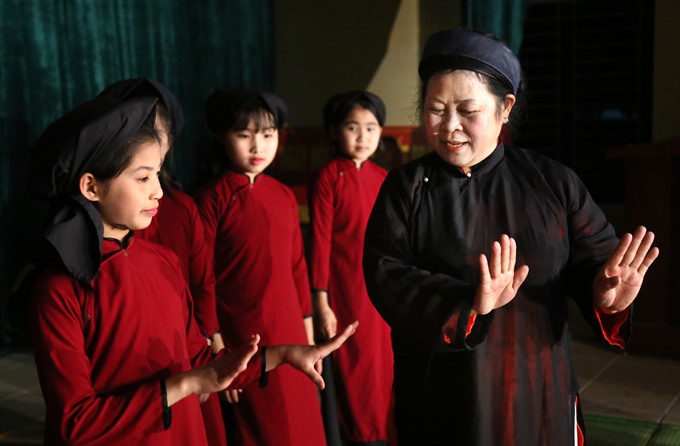 The PM held that the relationship between preservation and development to assure the rights of residents at heritage sites has been dealt with poorly. He recalled his recent visit to Yên Bái Province, where he asked local leaders: Why are the locals who made these stunning beautiful terraced rice fields so poor, while the terraced rice fields in Mù Cang Chải have been designated a national landscape? He pointed out that many heritage sites have been modernised and deprived of their unique features. Policies supporting folk artists have been implemented slowly. The role of the people in preserving and developing heritages’ values has still been limited. The PM stressed some basic policies for preserving heritages and developing sustainably. First, the task is not the State’s responsibility only. It is the cause of the whole community. The State creates the legal foundation and policies for people to play key roles in preserving and handing down the heritage through generations. Heritages should be developed from families, villages, schools and society. The PM highlighted the need to promote integration and international exchanges in preservation and managing heritages. The PM asked concerned agencies to complete a legal documents system and administrative procedures dealing with heritages in the next few years. At the same workshop, Michael Croft, representative and head of UNESCO’s Hà Nội office suggested five key recommendations for World Heritage management moving forward. The first recommendation is to situate World Heritage within a sustainable development framework. “Much more needs to be done to engage stakeholders outside of the sector to realise the broader economic and political importance of heritage protection and contribute effectively to it,” he said. The second recommendation is unifying and empowering the heritage authorities at both central level and local level. He also suggested strengthening the role of technical advisory bodies. Besides, reviewing and regulating the public private partnerships in World Heritage sites is necessary, he said. “An important step has been made with the policy prioritising financing for re-investment in conservation, newly regulated by Decree 109 in 2017,” he said. “The enforcement of this policy in practice at the local level is therefore highly important. It is also recommended to specify the categories of conservation budget expenses and put in place a regular reporting system between the local and central level.” First dance and music camp ends in Hanoi 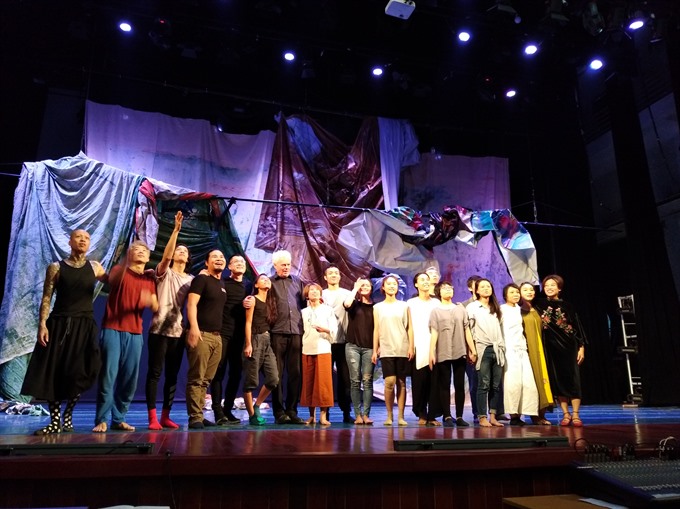 Vietnamese artists and the camp’s art directors German Heiner Goebbels (seventh from left) and Vietnamese Trần Ly Ly (first from right) pose after the show. — Photo VNOB Seventeen Vietnamese musicians and dancers put on a show at the Việt Nam Dance School yesterday after completing the Dance & Music Summer Camp. The 2-hour show included performances by eight choreographers and dancers and nine musicians and composers who were selected to participate in the camp from July 16 to 27. "Don’t expect a perfect performance," said German director Heiner Goebbels — one of the camp’s art directors, at the closing ceremony. "We have just one week to work together and for the artists to reflect the relationship between music, light, the stage and their movements." Alongside Goebbels, Trần Ly Ly - director of Việt Nam National Opera and Ballet (VNOB) is another art director of the camp. Goebbels belongs is well versed in the contemporary music and theatre scene. His compositions for ensembles and big orchestras are currently performed worldwide as well as several of his music theatre works and staged concerts. Goebbels worked for nearly 20 years as a professor at the Institute for Applied Theatre Studies of the Justus Liebig University in Giessen and was president of the Theatre Academy Hessen for twelve years. He was the artistic director of the Ruhrtriennale International Festival of the Arts. Director Ly is one of the leading choreographers working in contemporary dance in Việt Nam. After graduating from the Việt Nam Dance College in 1996 with honours she studied and worked as a dancer and choreographer abroad in Australia and France. She became popular with contemporary dances such as One Day; Zen and Burning Man’s Figure, which sparked a big debate on contemporary dance in Việt Nam. For the first time, the camp was co-organised by Hanoi Goethe Institute, VNOB and Việt Nam Dance School in Hà Nội from July 16 to 27. The camp was initiated last year by Goethe Institute’s director Wilfried Eckstein after the institute had successfully held a dance festival for Asian and European dancers for seven consecutive years. Friendship association fosters Vietnam - Russia relations 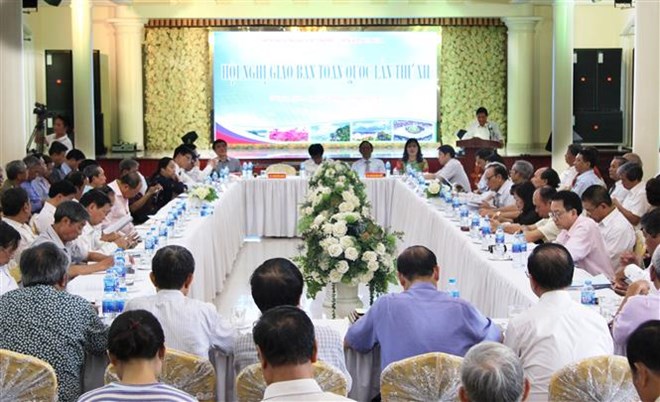 At the meeting of the Vietnam-Russia Friendship Association held on July 28 The Vietnam-Russia Friendship Association has held many activities in various fields since the start of this year and become a bridge for cooperation in economy-trade, culture-education and science-technology between the nations, said its President Tran Binh Minh. Minh made the statement at the association’s meeting which took place in the north province of Lang Son on July 28. The association’s portal was launched in February, promptly proving information and updates on significant events and foreign activities of Vietnam and Russia. The Vietnam-Russia Friendship Association’s activities have also enhanced people-to-people exchanges, contributing to the Vietnam-Russia traditional friendship. In the coming time, the association is set to arrange visits of Russian delegations to Vietnam while stepping up communication work. On the occasion, the association presented awards to 38 winners of a writing contest on memories in Russia and the Vietnam-Russia friendship, which was held to celebrate 100 years of the Russian October Revolution. Ho Chi Minh City eyes to form innovation district 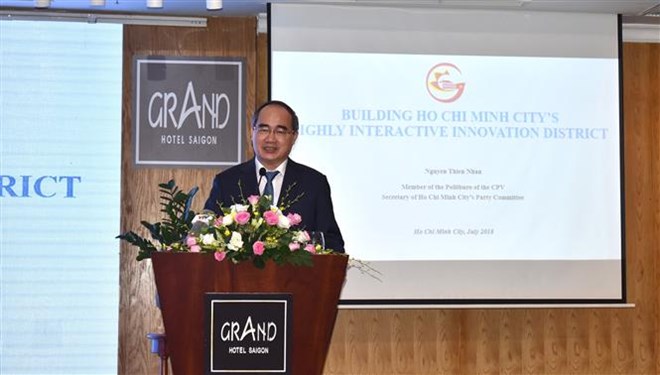 Secretary of the Ho Chi Minh City Party Committee Nguyen Thien Nhan speaks at the international seminar “Vision for Innovation District in Ho Chi Minh City” on July 28 Ho Chi Minh City plans to combine its Districts 2 and 9, and Thu Duc district into a highly interactive innovation district. The information was made by Secretary of the municipal Party Committee Nguyen Thien Nhan at an international seminar themed “Vision for Innovation District in Ho Chi Minh City” on July 28. According to Nhan, Thu Duc district will focus on research and innovation, while District 2, with its Thu Thiem new urban area, will play a role as an international financial centre, and District 9 will be a research and development centre, with the highlight of its Hi-tech Park. The innovation district will concentrate on research, human resources training and technology transfer, and contain of a service centre, a hi-tech manufacturing area and a space for culture and entertainment, he added. The leader also revealed that within 2018, the city will organise a contest for international consulting units to build a vision as well as specific measures, and then make a master plan for the innovation district. Ousmane Dione, Country Director of the World Bank in Vietnam, suggested Ho Chi Minh City consider the entire ecosystem of the innovation district in terms of planning, policies, design, infrastructure and organisation, not focusing only on technology. Meanwhile, a representative from the municipal Department of Science and Technology proposed the city carry out policies to attract and support investors as well as experts and scientists, and intensify connectivity between the innovation district and other centres in the city. Ho Chi Minh City is the largest economic hub of Vietnam and has a high-quality labour force, with its labour productivity posting 2.7fold higher than the country’s average. The city set a target of building an innovation district in line with the fourth industrial revolution in order to create an interaction between the fields of research, human resources training, and technology application, and to support such surrounding provinces as Dong Nai and Binh Duong to make a driving force for economic development in the southern region. VNN |
Article 1
↧
↧
Article 0
Wider investments needed for agriculture to flourishPrime Minister Nguyen Xuan Phuc pointed to conclusions and direct the implementation of important policies and measures to resolve difficulties in agricultural investment promotion at a national conference in the Central Highlands province of Lam Dong on July 30.  The conference attracted the participation of Deputy Prime Ministers Vuong Dinh Hue and Trinh Dinh Dung, Secretary of Ho Chi Minh City’s Party Committee Nguyen Thien Nhan and more than 600 delegates, including leaders of ministries, sectors, localities, businesses, and domestic and foreign development partners. The event is seen as an opportune occasion to evaluate what has been done and what has yet to be done in order to find a solution for encouraging businesses to invest in agriculture. In his opening address, Deputy PM Trinh Dinh Dung emphasized the due attention given by the Party and State to agricultural and rural development, as shown by the 10th Party Central Committee’s Resolution No. 26 in 2008 which asserted the important role and strategic position of agriculture, rural development, and farmers. The Government has also issued a number of major agricultural investment policies as stipulated in the Resolution. Since the beginning of his term, the Government leader has chaired a host of conferences of its kind such as a “Building Vietnam's Agriculture and Industry” conference in 2016, a conference discussing solutions for sustainable development of the rice industry in the Mekong River Delta region in 2017, a conference on the development of Vietnam’s shrimp industry in 2017, a “Market Development for Fruit and Vegetables, a Solutions for the Development of Logistics Systems for Agriculture and Rural Areas” forum in 2017, and the first-ever dialogue with Vietnamese farmers in 2018. The issuance of many specific policies has showed the dedicated focus of the Government and Prime Minister and served to actualise Party and State guidelines on enhancing agricultural and rural development.  The delegates highlighted the important role played by businesses in agricultural and rural development, thereby helping to restructure high value goods production and generate employment and incomes, facilitate engagement in the global value chain. It is estimated that around 49,600 businesses nationwide are invested in agriculture, making up 8% of all companies in the country, and creating more than 4.5 million jobs, accounting for 32.5% of the total workforce of all businesses throughout the nation. However, these achievements are still below the agricultural sector’s potential and capabilities as a result of unsustainable development, weak competitiveness, slowly renovated production organization, small and scattered production, and its low productivity, quality and added value, which failed to meet the requirements for the production of commodities. According to some participants, there should be agricultural investment promotion policies. Businesses must be the key force, while farmers must take the initiative with high technological adaptation. It is necessary to establish chains of connection from production to consumption, and improve the infrastructure for agricultural development. The conference is part of a string of other recently held events such as a national conference on promoting ASEAN Single Window (ASW), National Single Window (NSW) and trade facilitation, a conference on logistics and export promotion and related meetings on the Industrial Revolution 4.0. VOV |
↧
Article 1
BUSINESS NEWS IN BRIEF 30/7 Conference promotes investment, tourism in Laos’ Sekong province Authorities of Laos’ Sekong province organised an investment and tourism promotion conference in Tam Ky city of the Vietnamese central province of Quang Nam on July 26. At the event, a representative from the Lao province briefed participants on the locality’s socio-economic development and investment attraction achievements. Two years into the implementation of the 2016-2020 economic development plan, the province continues to enjoy remarkable economic growth, with gross regional domestic product (GRDP) reaching 9.17 percent and per capita income at 12.64 million LAK (1,580 USD). Investment promotion and attraction has also produced positive results. Notably, in the field of energy, there are currently 44 projects with a combined capital of over 1.2 billion USD. The province is calling for investments to 41 other projects, including 13 hydropower, two thermal power, one wind power, and two solar power projects. Participating Vietnamese enterprises were also introduced to Sekong’s advantages, potential, and preferential policies as well as its fields of priority such as tourism, transport, mining, trade, and industry. Quang Nam province pledged to soon propose that the two Governments approve the upgrade of the Nam Giang-Dak Ta Ook border gate to international level in order to create a breakthrough in tourism development and investment cooperation, bringing the East-West economic corridor crossing the two localities into full play. Vietnam becomes biggest trade partner of China in ASEAN Vietnam has surpassed Malaysia to become the biggest trade partner of China in ASEAN, Hu Suojin, Trade Counsellor of the Chinese Embassy in Vietnam, said at a press conference in Hanoi on July 26. According to the diplomat, trade between Vietnam and China was estimated at around 66 billion USD in the first half of 2018, with the average monthly total for bilateral trade during the period breaking records to exceed 10 billion USD. In June alone, China’s trade value with Vietnam reached 11.2 billion USD, higher than the figure with Malaysia, at 9.3 billion USD. China-Vietnam trade grew 28.8 percent from the same period last year, compared to the 15.5 percent annual growth of China-Malaysia trade. The year-on-year growth rates of Chinese exports to Vietnam and of Vietnamese exports to China were at 23.5 percent and 37.4 percent, respectively. In February, China surpassed the US to become the biggest export market of Vietnam. In terms of investment, Hu said the inflow of Chinese investment into Vietnam is growing in line with the country’s overseas investment growth. In 2017, China’s foreign direct investment (FDI) in Vietnam exceeded 2.1 billion USD, the highest level to date. Since the beginning of 2018, China has invested 330 million USD in 163 new projects in Vietnam, ranking 6th among international investors in the Southeast Asian country. Chinese contractors have also undertaken projects in Vietnam for about 6 billion USD per year on average. In the first half of the year, the figure was 2.4 billion USD. Vietnam Entertainment Fund makes debut  The Vietnam Entertainment Fund (VEF), which aims to increase value through medium- and long-term investments in the entertainment sector, made its debut in Ho Chi Minh City on July 26. This type of open-ended fund operates under the holding form, meaning that the company will hold shares of other firms. The VEF, established under the consultation of VinaCapital Fund Management, will operate to maximise profits for investors by increasing the capital value and dividend yield from initial investments, such as with intellectual property assets of films and fixed assets. Regarding the portfolio, representatives from the VEF said that the fund will diversify its operation fields to reduce risks and ensure investment objectives. At the same time, with its flexible investment form, appropriate financial capacity, transparent information, and safety for investors, the VEF expects to attract the attention of businesses and investors. The fund sets a minimum income plan of 8 percent per year and a maximum of 10.5 percent annum for the 2018-2019 period, and a minimum revenue of 10.5 percent for 2020-2022. Other financial benefits for investors include the right to buy preferred stocks at the time of issuance, as well as stock value expecting to climb at least five times higher than the initial investment value after three years. Shares in the VEF are hoped to be offered at the initial public offering (IPO) five years after its establishment. Currently, the attractive profit opportunity in Vietnam’s entertainment industry is attributed to its average growth reaching 25 percent per year, with the average revenue of the film industry alone reaching 2.3 trillion VND (99.2 million USD) per year. Trade office advises firms to keep away from reported Morocco firm The Trade Office of the Vietnamese Embassy in Morocco has warned domestic firms not to take any transaction with Ste Top Arabic Sarl A.U, a Moroccan company that has been reported by many foreign firms. The company, which also holds a representative office in Spain under the name of Macrotex Trading Solutions, holds the tax code of 5612886 and is addressed at QU Bouchouaf Immb A 1 Etage, in the Moroccan city of Nador. Its office, which is located in a small city in the northern mountainous region of Morocco, closes frequently, while the phone number it sent to its partners can hardly be reached. The Trade Office said that the company often contacts exporters in other countries, including Vietnam, either directly or through a third party in order to seek suppliers of agricultural products such as packed fruits, cashew nuts, coffee, pepper, and spices. Many exporters have fallen into failed dealings with the firm. After signing a contract and reaching an agreement in payment methods, exporters then sent goods which the Moroccan firm then ignored, leaving exporters with high storage fees and forcing them to reduce the prices of their goods. The exporters were then faced with an awkward situation and suffered from losses. So far, several foreign companies and one Vietnamese firm have fallen into such troubles in the same way. As such, the Vietnamese Embassy in Morocco’s Trade Office advised enterprises to be careful and keep away from Ste Top Arabic Sarl A.U to avoid losses. It also reminds businesses to research information of all firms carefully before partnering with them, while also being cautious in contract negotiations to reduce risks in the promising markets of Morocco and others. RoK seafood firms seek opportunities in Vietnam A business-to-business (B2B) meeting was organised by the Vietnam Chamber of Commerce and Industry and K-Fish Trade Support Centre in HCM City, providing opportunities for 12 firms from the Republic of Korea (RoK) and 50 local seafood companies to seek and foster partnerships. The RoK firms said they are looking to export raw and processed seafood to Vietnam and import raw seafood from the Southeast Asian nation for processing. Bae Byeong-Cheol, chief representative of K-fish, said: “RoK seafood is plentiful in terms of variety, and because of the difference in climate and location, the RoK can supply a great deal of high-quality products unavailable in Vietnam”. “We are striving to help more Vietnamese enjoy RoK seafood,” he added. Consumers in both countries have shown their favour and would like to try more of each other’s seafood products, he said. Le Thi Nguyet of the Van Kim Commercial Joint Stock Company said RoK seafood products are very safe and of very high quality, but are usually more expensive than products from Southeast Asian countries, which could deter many Vietnamese from consuming them. Bae said several RoK companies are facing difficulties in exporting raw seafood to Vietnam because of the lengthy customs and other formalities involved, and would like to see the process streamlined. Vietnamese seafood exports to the RoK reached 390.7 million USD in the first six months of this year, accounting for 9.8 percent of the total seafood export turnover of the country, the General Department of Vietnam Customs reported. In recent years, K-Fish Trade Support Centre has regularly organised events to promote exchange and trade links between the two countries’ enterprises, making it easy for RoK firms to introduce traditional processed products to Vietnamese consumers. The two countries aim to lift their two-way trade to 100 billion USD by 2020. The RoK is now the biggest foreign investor in Vietnam, and also one of its most important trade partners. HCM City’s imports from China soar Ho Chi Minh City’s 2018 spending on Chinese imports has exceeded 8.1 billion USD to date, an increase of more than 2.4 billion USD from the same period last year. According to the municipal customs department, the import of computers-electrical equipment and components and of machines and spare parts made up the lion’s share of the sum, exceeding 2.5 billion USD and 1.1 billion USD. The respective figures recorded for 2017 were more than 1.2 billion USD and more than 858 million USD. During the period, the city also purchased Chinese steel products worth some 719 million USD and cloth worth 708 million USD. Initial estimations of the General Department of Vietnam Customs showed the import value of the entire country amounted to more than 110 billion USD. China continued to be one of the biggest suppliers of Vietnam, with its goods accounting for nearly 29 percent or about 30 billion USD of total import value. Ca Mau strives to speed up ODA projects The Mekong Delta province of Ca Mau has sought measures to hasten the progress of projects using official development assistance (ODA) capital in the locality. Currently, the locality is hosting 23 ODA projects worth nearly 4.5 trillion VND (193.5 million USD), with 3.2 trillion VND (137.6 million USD) coming from ODA. So far, 17 projects are operational. Disbursement as of January 31, 2017 exceeded 2.76 trillion VND (118.68 million USD). The projects have helped improve rural infrastructure and the quality of the local education and health care sectors. However, some projects are lagging behind schedule due to site clearance and capital difficulties. Secretary of the provincial Party Committee Duong Thanh Binh proposed that central ministries and sectors define responsibilities in the implementation of projects relating to climate change prevention and adaption. Meanwhile, he suggested the allocation of capital for the construction of a bypass around in Ca Mau city and the expansion of Ca Mau general hospital to 1,200 beds, while adding some projects to the medium-term investment plan, including the upgrade of National Highway 63 crossing Ca Mau city and a project to protect coastal area and restore mangrove forest in Kien Giang and Ca Mau. Binh added that Ca Mau provided more than 851 billion USD (36.59 million USD) as corresponding capital for ODA projects in 2011-2016. Major groups to invest in Can Tho city Several major domestic and foreign groups will be committing to projects in the Mekong Delta city of Can Tho after signing memoranda of understanding on investment next month. A number of large-scale projects will be constructed, including the FPT University and Vinmec General Hospital complex with investment capitals of 1.17 trillion VND (50.6 million USD) and over 2 trillion VND (86.6 million USD), respectively, according to Chairman of the municipal People’s Committee Vo Thanh Thong. Local authorities are due to grant investment licenses to other large-scale projects, including a complex made up of villas, a golf course, and reception area in Con Au islet in Cai Rang district. Furthermore, businesses from the Republic of Korea and Japan have also been exploring investment opportunities in Vietnam’s Mekong Delta city. According to the municipal People’s Committee, industrial and processing parks in Can Tho attracted an additional three projects during the first six months of 2018 with a combined registered investment of 4.17 million USD, as well as three existing projects with increased capital of 4.91 million USD and two reclaimed projects worth over 3 million USD. In summary, industrial parks count for 233 valid projects with a total registered capital of over 1.6 billion USD. The capital disbursement was estimated at over 1 billion USD. From January to June, businesses grossed 776.59 million USD in revenue, representing a year-on-year rise of 3 percent and fulfilling 53 percent of the target set for the year. In the six-month period, Can Tho granted an investment licence to one project worth 20,000 USD, allowed another existing project to raise its capital by 30.6 million USD, and suspended the operation of two projects worth 500,000 USD. To date, the city has run 76 FDI projects worth 687.4 million USD. The capital disbursement has reached 477.8 million USD. According to economists, foreign investment attraction in Can Tho has yet to truly reflect its position as a centre of development in the Mekong Delta region due to poor infrastructure connectivity between the city and other localities nationwide. The lack of high-quality labour forces and slow development of the support industry are also barriers to drawing foreign investment, they said. To address these shortcomings, Can Tho has been increasing trade and investment promotion activities both at home and abroad, as well as clearing land at industrial and processing parks to enable businesses to make further investments into the city. Relevant agencies have been working to simplify administrative procedures to create a favourable mechanism for investors. Local authorities also meet with enterprises on a monthly basis to promptly address any difficulties that has arisen and help them promote business production. Can Tho will call for 124 trillion VND (5.4 billion USD) in investment to finance 54 projects at an investment promotion conference to be held on August 9-10, with Prime Minister Nguyen Xuan Phuc being expected to attend the event along with 550 domestic and foreign delegates. Of the said projects, 44 are in the form of direct investment with an estimated value of over 112.9 trillion VND (4.89 billion USD). Among them, 22 have found investors who are already prepared to spend 82 trillion VND (3.55 billion USD). It will introduce its strengths and investment policies during the conference under the theme of “Sharing Potential for Mutual Development” on August 10. Discussions will focus on services, high-tech agriculture, and information technology. Some investment projects are hoped to be awarded licences at the event and ground-breaking ceremonies for key projects will be held. The Mekong Delta city is seeking investment to enable it to become a service and high-tech agriculture centre, as well as an information technology hub. Phu Yen’s spending on off-shore fishing increases six-fold The south central province of Phu Yen planned to spend more than 61 billion VND (2.65 million USD) on supporting offshore fishing this year, six times higher than the figure for 2017. The sum has been channeled into building seven new steel and composite ships and supporting the purchase of insurance for the bodies of 1,336 vessels with capacity of 90 CV and above. It has also been used to open training courses on fishing techniques and seafood preservation for 418 sailors. Nguyen Tri Phuong, Vice Director of the provincial Department of Agriculture and Rural Development, said the fund was created following the Government’s Decree 17 issued on February 2 this year. The Decree amends and supplements Decree 67 dated July 7, 2014 on fishery development policies targeting fishermen. Decree 67, which took effect in August 2014, stipulates policies in investment, credit, insurance and tax incentives in support of fishermen and ship owners, who wish to build new fishing boats, upgrade their existing boats and buy fishing and marine equipment, among others. To date, Phu Yen authorities have approved 290 billion VND (12.63 million USD) in loan for eligible ship owners in line with Decree 67. As a result, fishermen have built and put into use 19 new ships. Since the beginning of 2018, the province has licensed 80 fishing vessels to operate, most of them have the capacity of 160 CV and higher. Between now and 2020, the Government will provide Phu Yen with 85 billion VND (3.7 million USD) to build an area in Tuy Hoa city for fishing ships to dock during storms. National Single Window mechanism benefits enterprises 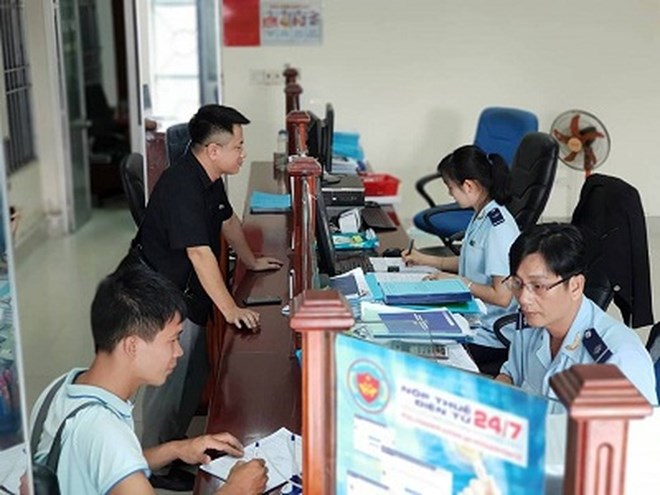 The National Single Window (NSW) customs mechanism has made significant contributions to administrative reform in Vietnam since it was officially launched in November 2014, notably creating more favourable conditions for enterprises. The Customs Department under the Ministry of Finance said on July 23 that a total of 53 administrative procedures in 11 ministries and sectors have to date connected to the NSW mechanism. As of July 15, 1.34 million dossiers from 22,800 businesses were handled through this mechanism. Through the NSW, enterprises do not need to directly work with each State agency to complete administrative procedures, thus helping reduce time and costs, and shorten the duration for customs clearance of goods. The mechanism has contributed to building an open and transparent administrative sector, improving competitiveness of businesses and the economy, and increasing the efficiency of State management. Besides benefitting enterprises, the implementation of the NSW mechanism has also brought a lot of benefits to State management agencies as they get familiar with conducting administrative procedures without paperwork, and have more experience in simplifying and modernising administrative procedures. It has prepared Vietnam well for negotiations of bilateral and multilateral agreements on the mutual recognition of technical standards, and e-licenses and e-certificates in order to simplify administrative procedures in importing countries, thus shortening customs clearance and facilitating the export of Vietnamese products. According to a World Bank report, in 2017, Vietnam was able to slash 3 hours for customs procedures for exported goods from 58 to 55 hours and 6 hours for imported goods from 62 to 56 hours. Meanwhile, the cost of direct customs clearance at the border gate for a consignment dropped down by 19 USD. It is estimated that with more than 11 million customs declarations in 2017, the enterprises were able to save over 200 million USD while saving more than 16 million hours from storing the exported items in warehouses and more than 34 million hours from storing imported goods in warehouses. However, Nguyen Cong Binh, deputy head of the Vietnam Customs, said that the number of procedures connected to the NSW – 53 out of 251 – is still modest compared to the target set. To speed up the implementation of the NSW and the ASEAN Single Window (ASW) customs mechanisms, the department said that it is necessary to continue completing legal foundations and reforming administrative procedures to create a sufficient legal framework for the use and exchange of e-dossiers. Binh emphasised the importance of implementing an information technology system to serve the implementation of the NSW mechanism as well as building a supervision and assessment mechanism within the business community on the implementation of tasks by ministries and sectors. In 2018, the Finance Ministry will coordinate with ministries and sectors in completing and submitting an action plan for the approval of the Government and Prime Minister. The plan looks to boost the NSW and ASW customs mechanisms and reform specialised inspections over imports and exports for 2018-2020. According to Deputy Finance Minister Vu Thi Mai, by the end of this year, an additional 143 administrative procedures will be carried out through the mechanism, raising the total to 196, equivalent to 78 percent of the 251 procedures expected to be implemented by 2020. Quang Nam successful in restructuring agricultural sector The central province of Quang Nam has made impressive progress in agricultural restructuring, raising production value by 4.5 percent each year in 2008-2017. At talks with a working group from the Ministry of Science and Technology led by Minister Chu Ngoc Anh on July 23, Vice Director of the provincial Department of Agriculture Le Muoi reported that the province’s economic structure has changed, with a lower percentage of agriculture in gross regional domestic products to 11.6 percent in 2017 from 25.84 percent in 2008, and higher ratio of forestry-fisheries sector. After 10 years of implementing the 10th Party Central Committee’s resolution on agriculture, farmers and rural areas, the locality’s agricultural production value has increased from 36.06 million VND per hectare in 2008 to about 80 million VND per hectare in 2018. Nearly 4,000 hectares of rice farm with low production have been switched to other plants with higher value. At the same time, total cattle meat production increased from 49,297 tonnes in 2008 to 56,885 tonnes in 2017. The production value of the breeding sector rose to 2.15 trillion VND in 2017 compared to 1.6 trillion VND in 2008. Meanwhile, Quang Nam has planted more than 10,000 hectares of forest each year, raising forest coverage by 1.38 percent per year to 56.9 percent in 2017. In the aquatic sector, the province’s offshore catch reached nearly 45 percent of total aquatic output, up 15 percent over 2008. The increase of fishing vessels by six times to 758 in 2017 brings the province closer to its target of 60 percent in offshore catching in total aquatic output in 2020. Aquatic farming also surged 70 percent from 2008, with production in 2017 reaching nearly 400 million VND per hectare. The province has 57 industrial clusters which host 258 projects worth 13.2 trillion VND and create jobs for 57,049 people. In the past 10 years, progress in technology research, transfer and application activities as well as human resources training have significantly helped the modernisation of agricultural sector and industrialisation of rural areas. Many science-technology advances have been applied widely, enhancing value farm produce and contributing to transforming agricultural economic structure. At the working session, Minister Chu Ngoc Anh lauded the achievements of Quang Nam over the past 10 years, noting that the success has improved living conditions for locals. However, he pointed out that although the number of enterprises investing in agriculture and rural areas in Quang Nam expanded 4.5 times to 1,558 firms in 2018, the figure still only accounted for 23.5 percent of total businesses operating in the locality. He suggested that the province apply production connectivity models, while encouraging the engagement of businesses via preferential policies. Bright signs in Vietnam - Czech Republic trade Bright signs have been seen in two-way trade between Vietnam and the Czech Republic, as the two countries’ import-export turnover in the first five months of this year reached nearly 464.5 million USD, up 15.6 percent from the same period last year. Vietnam mostly exported to the Czech Republic seafood, farm produce, food, tea, coffee, rubber, chemicals, electronics, and footwear, the Vietnam Trade Office in the Czech Republic cited sources from the Czech Statistical Office. Products seeing highest revenue included electronics with over 140 million USD, and footwear products with 110.6 million USD. Exports of rubber, chemicals, leather products, garment materials, knitwear, boilers and mechanical products, engine vehicles, and wood furniture also fetched from 10 million USD - 31 million USD. Meanwhile, Vietnam imported from the European nation electronics, mechanical equipment, plastic products, military equipment, seeds, pharmaceuticals, medicinal plants, and industrial tree varieties. In 2017, two-way trade between the two countries exceeded 1 billion USD for the first time to 1.02 billion USD, a rise of 12 percent over the previous year. However, trade turnover remained modest compared to the economic potential and real demand of both markets. Currently, the Czech Republic is keen on fostering cooperation with Vietnam in areas of environmental protection, mining technology, construction technology, chemicals, telecommunications, radar, industrial and agricultural machineries, biotechnology and nanotechnology. Conference highlights financial inclusion for income balance Financial development with a focus on financial inclusion for people of all incomes will be the key for stable economic development, Vice Rector of HCM City Open University Nguyen Minh Ha said at Vietnam’s Business & Economics Research Conference that ends on July 24. Vietnam is witnessing a strong economic growth within the Asia Pacific region, Ha said, adding that it is committed to undertaking economic reforms to integrate into the regional economy. “Financial development with a particular focus on financial inclusion (or access to finance by the poor) will be key,” he said. When it comes to economic reform and restructuring, the issues of inequality become very important for consideration by policymakers, he added. Dr Vo Hong Duc, head of business and economics research group at HCM City Open University, told Vietnam News that during financial development, people who can take advantage of opportunities can become rich, and those who fail to grasp those opportunities remain poor, leading to an income gap. While it is important to develop the economy, life for everyone needs to be better, he said. Policymakers should issue social policies that reduce income inequality and allow everyone to get access to the benefits of economic development, he added. Although the Government has tried to reduce inequality, there are still many things to do, according to Duc. Income inequality remains high, especially between urban and rural areas. According to Mark Loo of the Concordia University of Edmonton in Canada fintechs could promote financial inclusion in an era of digital transformation. Many people in ASEAN still live in marginalized areas that have difficulty in accessing banking facilities. Fintechs manage a broad range of financial services to sustain livelihoods, build assets and manage risks. They offer opportunities to enhance financial inclusion as more people can access digital banking with increasing internet penetration. Ha Thi Thieu Dao, dean of the International Economics Faculty at Banking University in HCM City, said: “Microfinance programmes being carried out throughout the country could take an important role in reducing inequality and increasing access to capital sources for low-income people.” Institutes which offer these programmes provide loans or receive people’s savings, Dao said, adding that they also provide services which help empower women. Microfinance programmes can also remove the need for low-income consumers to use “black credit” loans on the black market, she said. Researchers at the Dublin Institute of Technology and the University of Limerick in Ireland said that microfinance had made significant contributions in developing countries such as Bangladesh, India, and Malaysia. In developing countries, microfinance has become a useful tool for poverty reduction and enhancement of economic growth and development strategies. Dao suggested that the Government should create a more detailed legal framework for microfinance institutions to operate. Vietnam’s Business & Economics Research Conference was held on July 22-24 by HCM City Open University. Academics, researchers, practitioners and policymakers discussed ongoing research on a wide range of theoretical and empirical issues related to sustainability of economic development in emerging markets, especially for Vietnam. Gas-power-fertiliser complex – major contributor to Ca Mau province More than 2 trillion VND (86.2 million USD), or 40-50 percent of the budget of the southernmost province of Ca Mau, is contributed by the Ca Mau Gas-Power-Fertiliser Complex each year, a recent meeting heard. The Ca Mau Gas-Power-Fertiliser Complex, inaugurated in October 2012, is jointly operated by the PetroVietnam Gas JSC (PV Gas), the PetroVietnam Power Corporation, and the PetroVietnam Ca Mau Fertiliser JSC. It is comprised of three projects covering more than 200ha in the Khanh An commune of U Minh district. The first project is the PM3-Ca Mau gas pipeline carrying gas from the PM3-CAA gas well (in the overlapping area between Vietnam and Malaysia in the Gulf of Thailand) and Block 46-Cai Nuoc (off the coast of Vietnam) to the complex to produce electricity and fertiliser. The other projects are the Ca Mau No. 1 and 2 gas power plants with a combined capacity of 1,500MW, and the Ca Mau fertiliser plant with the designed output of 800,000 tonnes per year. A report at the meeting, which reviewed the coordination in operating the complex, said that the PM3-Ca Mau pipeline, put into use by PV Gas in 2007, has supplied about 2 billion cubic metres of gas each year. The two gas power plants have generated over 7 percent of the electricity output nationwide. Meanwhile, 40 percent of total urea output in Vietnam is produced by the fertiliser factory of the complex. A gas processing plant has also been unveiled in the complex this year. In the first six months of 2018, it manufactured nearly 79,000 tonnes of liquefied petroleum gas and over 3,600 tonnes of condensate, up 42 percent and 15 percent from the planned figures, respectively. At the meeting, participants pointed out problems and solutions to ensure smoother operation at the Ca Mau Gas-Power-Fertiliser Complex. Dinh Van Son from the member council of PetroVietnam (Vietnam National Oil and Gas Group), said amid the changing global economy, good coordination among parties in operating the Ca Mau Gas-Power-Fertiliser Complex will help the group successfully fulfil the tasks assigned by the Party, State, and Government. Guaranteed bonds mobilise 150 billion VND The Vietnam Bank for Social Policies (VBSP) raised 150 billion VND (6.5 million USD) at the latest auction of Government-guaranteed bonds on the Hanoi Stock Exchange (HNX) held on July 23. The amount was mobilised from five-year bonds with an annual interest rate of 4.1 percent, which was 0.05 percent higher than that of the most-recent auction on July 16. The auction had planned to sell 2 trillion VND (86.63 million USD) worth of bonds with five-year, 10-year, and 15-year maturity. However, there were no successful bids for the 10-year and 15-year bonds. Since the start of 2018, the VBSP mobilised 350 billion VND (15.17 million USD) worth of guaranteed bonds through auctions on the HNX. Government-guaranteed bonds are bonds issued by authorised entities to mobilise capital for investment projects as appointed by the Prime Minister. According to the HNX, the State Treasury of Vietnam raised about 4.4 trillion VND (more than 190.7 million USD) in the last Government bond (G-bond) auction of June. The amount brought the total funds collected from G-bond auctions in the first half of 2018 to nearly 74.6 trillion VND (3.23 billion USD). The National Financial Supervisory Commission has predicted that the G-bond market in 2018 will see modest changes from last year thanks to the economic growth of more than 6.7 percent and inflation of below 4 percent. It expects the value of G-bonds issued this year to reach 180 trillion VND (7.92 billion USD). Last year, Vietnam sold some 159.9 trillion VND, or 7.03 billion USD, worth of G-bonds with average maturity of 13.52 years and annual interest averaging 6.07 percent, down 0.2 percentage points against 2016. The interest rates of G-bonds have been on the rise lately, after a long period of decline throughout 2017 and the first four months of 2018. Central localities need to boost administrative reform to increase competitiveness index Local authorities in the central coastal and Central Highlands areas should remove post-licensing obstacles and improve inspection activities to boost their provincial competitiveness index (PCI), an official has said. According to Chairman of the Vietnam Chamber of Commerce and Industry (VCCI) Vu Tien Loc, a survey – carried out to compile the Vietnam Provincial Competitiveness Index (PCI) 2017 report – showed that 7 percent of enterprises in the Central Highlands had to wait for over three months after being licensed to have all paperwork for their official operation completed, while the average figure for other regions was between 2 and 3 percent. There were 14 percent of firms in the central coastal region reported experiencing overlapped inspection content, while 18 percent said the inspection created a breeding ground for improper activity by some of the inspectors. The figures for the Central Highlands were 15 and 24 percent, respectively – the highest nationwide. Loc said efforts to cut informal fees are necessary, as 62 percent of the enterprises surveyed in the central coastal region and 65 percent of their peers in in Central Highlands said they faced difficulties caused by administrative personnel. The two regions’ sub-indices on transparency and informal fees were ranked fifthand sixth respectively, and the lowest among those regions involved in the PCI 2017 report. He suggested that strengthening the connection among provinces and cities in the central coastal region, particularly in investment attraction and business climate improvement, is an important move. Dau Anh Tuan, Director of the VCCI’s Legal Department and a member of the PCI survey team, said companies in the two regions demand a fairer business climate. A total of 48 percent of them pointed to the fact that local authorities often prioritise tackling foreign businesses’ obstacles over those of domestic businesses. Of Central Highlands firms, 79 percent agreed that most local business resources are owned by companies which had established a close relationship with the authorities. Tuan highlighted that transparent, professional, and trustable administrative procedures are a pivotal factor needed for these localities to increase their annual number of newly established enterprises. Despite several shortcomings, both regions recorded positive PCI increases, with the central coastal region scoring 63.09 points and the Central Highlands 60.05 points. Their respective points for 2016 were 59.8 and 56.92. The PCI Report is an annual joint project between the VCCI and the US Agency for International Development (USAID). It has been produced annually since 2005 to assess the ease of doing business, economic governance, and administrative reform efforts by the provinces and cities in Vietnam in order to promote the development of the private sector. The 2017 PCI Report was the 13th iteration and was based on responses from 12,000 enterprises, including more than 10,200 domestic private enterprises from 63 cities and provinces and nearly 1,800 foreign invested enterprises in 21 provinces in the country. It revealed optimism among private and foreign business communities and helps to raise their economic prospects. Fifty-two percent of PCI 2017 respondents in the domestic survey said they planned to broaden the size of their operations over the next two years, the highest level since 2011, while the number of firms planning on scaling down or closing their business was extremely low at 8 percent. Sabeco cuts projected profit by a fifth The Saigon Beer-Alcohol-Beverage Corporation (Sabeco) is targeting a lower post-tax profit in 2018 due to the increase of production costs and stronger competitiveness in the industry. Its management board said at the company’s annual shareholder meeting recently that it had cut its projected post-tax profit by 19 percent year on year to 4 trillion VND (178 million USD) in 2018. Its total revenue is forecast at 36 trillion VND in 2018, up 2.4 percent from 2017, and a 35 percent dividend payout, level to the previous year. In 2017, the company recorded 35 trillion VND in total revenue and 4.95 trillion VND in post-tax profit. The 2017 figures increased by 11.2 percent and 9.6 percent year on year, respectively. This was the first annual shareholder meeting after the Thai beer firm ThaiBev via its Vietnamese legal entity had spent around 5 billion VND to purchase 53 percent of capital in Sabeco at the end of last year. Sabeco’s management board said the domestic market was going to be tough in 2018 as competition among brewers in Vietnam rises. Meanwhile, production cost was estimated to grow as input material prices were expected to increase due to bad weather conditions and seasonal changes. In addition, alcohol and beer products have been affected by a 5 percent increase in special consumption tax from the beginning of this year. The new rates for alcohol products range from 35 percent to 65 percent and the rate for beer products is 65 percent. However, there are also advantages for Sabeco and the beer industry in 2018. According to studies of international organisations, Vietnam is among rapidly developing economies with increasing per capita income, fast urbanisation and young population that accounts for 60 percent of the country’s total. According to Sabeco’s management board, those will be the factors that are benefiting the local industry to grow strongly in coming years. At the moment, Vietnam ranks among top 10 countries with the largest beer production in the world, top among ASEAN countries with the highest consumption and ranks third in Asia in terms of per capita consumption with around 43 litres a year. With an annual growth rate of 5 percent, Vietnam’s beer market will attract more and more foreign brewers from overseas, Sabeco said. Sabeco debuted on the HCM Stock Exchange with code SAB on December 6, 2016 at 128,280 VND (5.7 USD) per share. Its share price rose to the highest of 334,460 VND per share on November 29, 2017 but has fallen 40 percent since then to end last week at 200,000 VND per share. Eco-shrimp farming – model for sustainable aquaculture development Eco-shrimp farming, which has been spreading in the Mekong Delta localities in recent years, is touted as a model for sustainable aquaculture development thanks to its strengths in environmental protection, low costs, and high profit. Eco farming refers to the practice of raising shrimps in rice fields or mangrove forests at low density. Compared to industrial shrimp cultivation, farmers do not have to pay that much on feeds, waste water treatment system, and medicine to treat diseases. Eco farming also requires less labour. Meanwhile, shrimps raised under this model are sold at higher price than industrial shrimps. According to Dinh Xuan Lap, Vice Director of the International Collaboration Centre for Aquaculture and Fisheries Sustainability, eco-shrimp farming model created jobs for more than 700,000 labourers in the Mekong Delta. Chairman of the Bac Lieu province People’s Committee Duong Thanh Trung said that as of May, 2018, the province housed more than 120,000 hectares of water surface used for eco shrimp farming, and improved extensive shrimp farming. He said the province will promote the application of advanced technologies in eco-shrimp cultivation, adding that the model allows local famers easily control diseases, prevent pollution in the farming areas, and ensuring the living environment for both the shrimps and farmers. However, to ensure the sustainable expansion of eco-shrimp farming, there should be close connection between production and marketing processes, experts said. Chairman of Minh Phu Group Le Van Quang said that Vietnamese eco-shrimps have been granted certifications by prestigious orgasisations, and have been shipped to more than 160 countries across the five continents. Minister of Agriculture and Rural Development Nguyen Xuan Cuong stated that localities have to draw up strict shrimp farming process so as to enhance competitive capacity for Vietnamese shrimps. Workshop on Vietnam’s investment opportunities held in Malaysia A workshop to introduce investment opportunities in Vietnam was held on in Kuala Lumpur on July 26, drawing the participation of more than 100 representatives from firms in Malaysia. Themed “Promising investment spotlight: Why Vietnam now”, the event organised by the Vietnam – Singapore Indutrial Park joint company (VSIP) and the Trade Office at the Vietnamese Embassy in Malaysia, focused on Vietnam’s advantages and potential as well as the country’s business climate improvements and tax incentives. Opening the event, Vietnamese Trade Counsellor Pham Quoc Anh emphasised Vietnam’s efforts in improving investment climate, thereby drawing numerous foreign investors, including those from Malaysia. Malaysia is the eighth biggest foreign investors in Vietnam. As of June, Malaysia invested over 12 billion USD in 577 projects in Vietnam Malaysia is also the second largest trade partner of Vietnam in ASEAN after Thailand. In the first six months of this year, bilateral trade reached more than 5.8 billion USD. up 21 percent the same period last year. Trade Counsellor Pham Quoc Anh described the figures as a basis for the two countries to continue promoting the bilateral ties in various areas, including investment. John Campell from Savills emphasised Vietnam’s advantages such as competitive land rent prices and maritime transport charges, big population and geographic location. He highlighted that Vietnam signed many free trade agreements including those with the European Union and the Republic of Korea and the Comprehensive and Progressive Agreement for Trans-Pacific Partnership (CPTPP). At the event, representatives of VISP and KPMG Malaysia also pointed out other attractive aspects in Vietnam’s investment environment like tax incentives. VNN |
↧
Article 0
New urban development plan for Ha Long City The authorities in Quang Ninh Province are working on a new urban development plan for Ha Long City.
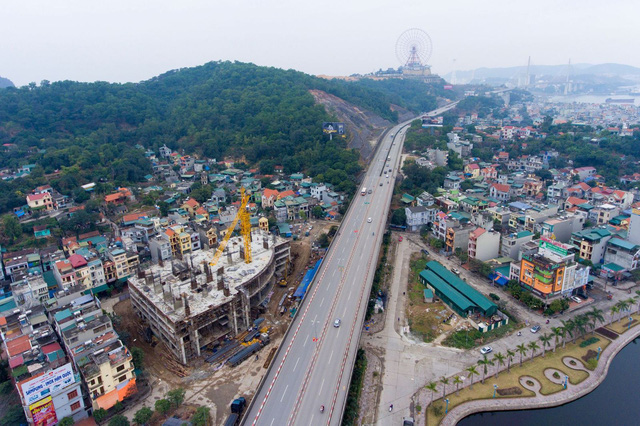 illustrative image Ha Long City's general planning to 2030 with a view to 2050 was approved in 2013. After five years, it has seen significant socio-economic development, urbanisation and services. The Hai Phong-Ha Long-Van Don-Mong Cai Highway project, Ha Long Ocean Park, provincial library and new stadium project have helped to realise the goal to make Ha Long a national tourism centre. At such a rapid rate, the old plan has proved no longer suitable with the new zoning or population. It also has many shortcomings which cannot maximise the advantages of Ha Long or ensure sustainable development. According to the provincial authorities, strategic investors have proposed measures to ease congestion, develop infrastructure, control high-rise buildings and environmental pollution. Ha Long is divided into 20 wards on nearly 277km2. In 2017, Ha Long's population was 384,000. The provincial authorities aim to develop the city to meet the estimated population of 570,000 in 2030 and 720,000 in 2040. The demand for land is about 110-130m2 per person. The area of green space per capita is 10 to 15m2. They are also considering proposals to build pedestrian tunnels under Cua Luc Bay, a coastal road from Ha Long to Cam Pha and the Hanoi-Haiphong-Ha Long-Mong Cai railway. The Ministry of Construction has approved the proposal to adjust Ha Long's general planning. Quang Ninh Province People's Committee must report to the prime minister about any partial adjustments on the general. dtinews.vn |
↧
Article 2
VND4.1bn tax arrears bill for man profiting from online business Nguyen Nam Binh, vice head of HCM City Department of Taxation, said on August 1 that they had collected VND4.1bn (USD164,000) in tax arrears and fines from a local man that earned VND41bn from Facebook and Google ads.
illustrative image The man is a programmer whose game has been viewed and downloaded on Facebook, Google and YouTube. He earned over VND41bn (USD1.6m) from ads in 2016 and 2017 but didn't make any declarations or pay taxes. He promised to VND3bn in tax arrears and a VND1.1bn (USD44,000) administrative fine. The tax arrears were detected when the Department of Taxation ordered banks to check on incomes from Google, Facebook and YouTube that haven't deduced taxes. Binh said they would continue checking other cases of huge online incomes. Another individual in HCM City also earned VND30bn online but hasn't paid taxes. The Department of Taxation said he was no longer living at the HCM City address so the case was transferred to the Department of Taxation in Quang Nam where the individual originally came from. Binh said the Law on Tax Administration required all businesspeople to pay tax. He went on to say that both Facebook, Google, YouTube as well as local individuals and firms that use the services hadn't fully complied with the tax regulations. The authorities will zero in on Facebook accounts that are the most active and have large incomes. Those who earn less than VND100m (USD4,400) a year online must pay a business licence tax. Those with over VND100m of annual incomes must pay additional VAT and personal income tax. According to the Department of Taxation, Facebook, Google and YouTube incomes at four banks are in the range of VND500bn (USD20m). Last year, the Taxation Department has collected VND9.1bn (USD400,100) in tax arrears from a Facebook account that sells cosmetics online. nguoilaodong, dtinews.vn |
↧
↧
Article 1
Growth drivers need to be upheld: PM HÀ NỘI – Driving forces for Viet Nam’s economic growth need to be maintained not only in 2018, but beyond, Prime Minister Nguyễn Xuân Phúc said at a Government meeting yesterday.
Driving forces for Viet Nam’s economic growth need to be maintained not only in 2018, but beyond, Prime Minister Nguyễn Xuân Phúc said at a Government meeting yesterday. — VNA/VNS Thống Nhất “We should continue working to create market confidence and win trust of enterprises so as to branch out business and production”, he stressed. Regarding the country’s socio-economic development, PM Phúc noted that four macroeconomic targets have been ensured, including sound growth of gross domestic production (GDP), price stability, reduction of unemployment rate and net export turnover. The nation’s unemployment index fell 2.2 per cent for the first time. Thanks to institutional reform, the Government’s direction and benefits from global integration, the economy grew in the second quarter. High-tech application has improved labour productivity, he said, adding that Viet Nam’s logistics index moved five steps to be in the top three among ASEAN members, just behind Thailand and Singapore. However, he pointed out some short-term risks that the economy may encounter, namely impacts of the US-China trade war, trade deficit, reversing foreign direct investment flow, reducing remittances and trade protectionism. “Our foreign currency reserve is now at US$63 billion, but it cannot ensure that the economy is able to control the exchange rate amid impacts of global financial market”, he said, requesting flexible management of the exchange rate. PM Phúc agreed not to change financial policy in the fiscal year 2018, comprising gasoline tax, VAT and prices of commodities and public services. He ordered tight control of education and health care service prices to prevent inflation soaring. He asked ministries to tighten fiscal discipline, complete budget collection plans and accelerate disbursement of public investment in line with plans. Additionally, he urged the finalisation of public investment law and construction of key infrastructure works, especially in the transport sector. Besides export markets, local firms should pay attention to the nearly 100 million strong domestic market by improving service quality and food hygiene and safety, he noted. Regarding slow equitisation in some State-owned companies, PM Phúc called for inspections in relevant localities. Ministries and agencies must complete the draft decree on amending and supplementing business conditions, he said, recommending cutting the number of commodities that must go through specialied inspections by half. Agricultural reform must be promoted, encouraging firms and co-operatives to land more investment in the sector to generate incomes for farmers. This should be made in companion with market reorganisation in processing and manufacturing for sustainable development for post 2020. As economic growth is closely attached to local livelihoods and environment, the Government leader stressed environmental protection and social order and safety. He lauded the police forces for busting a large-scale drug trafficking ring in Sơn La Province and other serious cases. He ordered the Ministry of Agriculture and Rural Development and relevant ministries and agencies to devise specific programmes in response to natural disasters. Mentioning critical losses in terms of officials following wrongdoings in the Ministry of Public Security and the Ministry of Information and Communications, PM Phúc called on Cabinet members to set the example in implementing the Resolution adopted at the 4th plenum of the 12th Communist Party of Việt Nam Central Committee on enhancing Party building and rectification, and preventing and curbing ideological, ethical and lifestyle degradation as well as the manifestation of “self-evolution” and “self-transformation” inside the Party. Việt Nam witnesses robust socio-economic development in 7 months Việt Nam recorded robust socio-economic development in the first seven months of the year, with a stable macro-economy and good control over inflation in the context of the escalating US-China trade war, said Minister-Chairman of the Government Office, Mai Tiến Dũng. Speaking at a press conference after a regular government meeting yesterday, Dũng said the consumer price index (CPI) in July dropped by 0.09 per cent from the previous month after increasing for three consecutive months. The average CPI in the seven-month period went up 3.45 per cent, which was lower than the 3.91 per cent recorded in the same period last year, he said. The industry sector was the key driving force behind the nation’s economic growth. The industrial production index in July shot up 14.3 per cent compared to the same month in 2017, which was its highest expansion since February. The agricultural sector also posted impressive results, with aquatic output surging 5.7 per cent. The stock market made a remarkable recovery when the VN-Index on the Hồ Chí Minh Stock Exchange reached 934.08 points on July 24, and the total capitalisation value of the stock market rose 8.3 per cent from the end of 2017. During the January-July period, Việt Nam enjoyed a trade surplus of US$3.1 billion, equivalent to 2.3 per cent of export revenue. Regarding foreign direct investment (FDI), Dũng pointed out the sound growth in foreign capital. Foreign firms registered to invest nearly US$23 billion in Việt Nam while FDI disbursement was estimated at more than $9.8 billion, an on-year surge of 8.8 per cent. Positive signs were also seen in the private sector. Nearly 75,800 new enterprises were established nationwide in the first seven months of the year with total registered capital of VNĐ771 trillion ($33.34 billion), an on-year rise of 3.9 per cent in the number of firms and a 11.6-per cent rise in terms of capital. Meanwhile, 18,696 companies resumed operations, up 6.5 per cent from the same period last year. International organisations recognised Việt Nam’s economic reform efforts, and gave optimistic outlooks for the nation’s economic growth. Of them, the Asian Development Bank (ADB) forecast that the Vietnamese economy will expand 7.1 per cent this year, while Standard Chartered predicted economic growth of 7 per cent and inflation of around 4 per cent. In the United Nations’ sustainable development goal (SDG) index, Việt Nam moved up 11 places to rank 57th out of 156 countries and territories, and third in ASEAN, just behind Singapore and Malaysia. Regarding the Global Innovative Index 2018 (GII Index 2018), Việt Nam rose two positions to 45th among 124 countries and territories, and 4th in ASEAN after Singapore, Malaysia, and Thailand. The latest report from the World Bank (WB) indicated that Việt Nam’s Logistics Performance Index had moved it 25 places to 39th place among 160 surveyed countries. Dũng also pointed out shortcomings in the socio-economic situation, including complicated weather developments, price hike pressures on the macro-economy, barriers facing local firms looking to expand, and slow equitisation of state-owned enterprises. He said that at the Government meeting, Prime Minister Nguyễn Xuân Phúc ordered relevant sides to work on solutions to effectively address these issues. VNS |
↧
Article 0
Government News 2/8 Swiss National Day celebrated in HCM City 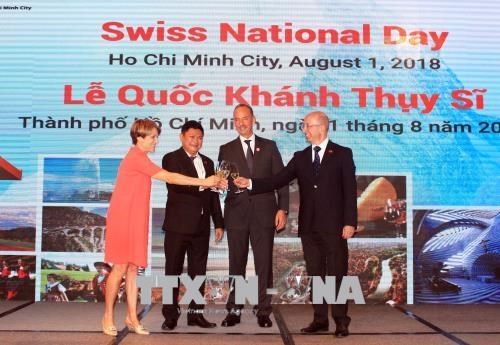 At the celebration for Swiss National Day The Consulate General of Switzerland in Ho Chi Minh City on August 1 organised a reception to mark the 727th anniversary of Swiss National Day (August 1). On behalf of the municipal authority, Vice Chairman of the People’s Committee Huynh Cach Mang extended congratulations to the European country, stressing that Switzerland is one of the very first western nations to set up diplomatic ties with Vietnam. The bilateral relations have enjoyed sound developments, particularly in trade and investment collaboration, he said, adding that both sides enjoy huge potential for further cooperation. He underlined that Switzerland is an important investor in Ho Chi Minh City, with 72 projects valued at 604 million USD, saying that direct flights connecting Ho Chi Minh City and Zurich, which is scheduled to commence in the end of this year, will bolster delegation exchange, tourism, and trade between the two sides. Mang affirmed that the city always welcomes and creates favourable conditions for Swiss businesses and people to study, set up and carry out cooperative programmes in various sectors, contributing to developing the bilateral ties in a deep and effective manner. Swiss Consul General Othmar Hardegger, for his part, took the occasion to recall the significance of Swiss National Day which helped turn country from a poor nation to a prosperous one. He expressed his delights at the rosy development in the relations with Vietnam over the past 47 years since the establishment of bilaterlal diplomatic ties. In the recent past, high-level visits have created foundation to bolster cooperation in economy, investment, trade, aviation, education and training, and people diplomacy. The diplomat thanked relevant authorities of the Vietnamese city for supporting Swiss citizens, businesses, and the Consulate General in increasing Switzerland’s presence in Vietnam. He said that it will enhance the bilateral ties and bring benefits to both nations.-VNA Vietnam-Singapore diplomatic ties anniversary marked in HCM City 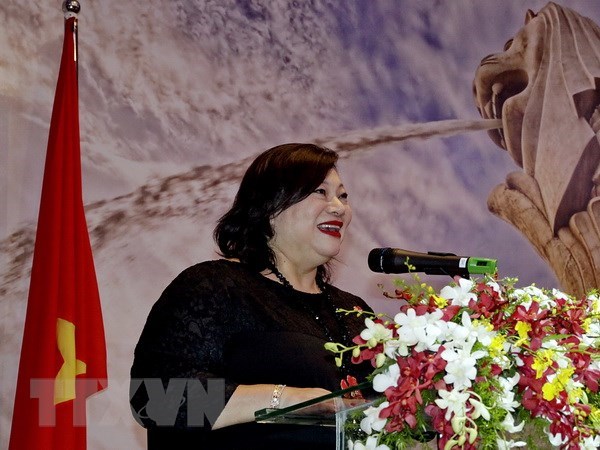 Singaporean Consul General in Ho Chi Minh City Leow Siu Lin The People’s Committee of Ho Chi Minh City held a ceremony on August 1 to celebrate the 45th anniversary of Vietnam-Singapore diplomatic ties. Addressing the event, Vice Chairman of the municipal People’s Committee Huynh Cach Mang highlighted the continuous growth over the past 45 years of the two countries’ relations in all fields, especially after the ties were lifted to a strategic partnership level in September 2013. Ho Chi Minh City is proud to contribute to the fine relations through the active implementation of cooperative programmes with Singapore in various fields, Mang said. According to him, economic cooperation has been a bright spot in Ho Chi Minh City’s ties with Singapore which is the largest investor and second biggest trade partner of the city. Cooperative programmes in education, and socio-culture have been carried out effectively, thus helping nurture the bilateral solidarity and friendship. He affirmed that Ho Chi Minh City wants to further develop the relationship, particularly in trade, investment, education, culture, science and technology so as to consolidate the Vietnam-Singapore Strategic Partnership, for solidarity, friendship and interests of the two peoples and for peace, stability, and development in the region and the world. Singaporean Consul General in Ho Chi Minh City Leow Siu Lin expressed her delight at Singapore’s top position among foreign investors in the city with over 1,100 projects totalling 10.5 billion USD, mainly in real estate and infrastructure. The country wants to expand its collaboration with the largest economic hub of Vietnam to new areas such as smart technology, she said, adding that its experienced and competent businesses can cooperate with the city in developing and applying smart technologies in urban planning. She took the occasion to thank municipal authorities and offices for their support and collaboration, especially through the organisation of activities to mark the 45th anniversary of bilateral diplomatic ties such as a painting contest for students, and a Singapore food festival. She showed her belief that the relations between Singapore and Ho Chi Minh City will continued its progress towards a new height. Labour productivity key to Vietnam - Japan Initiative  Japanese Ambassador to Vietnam Kunio Umeda told the meeting Enhancing Vietnam’s labour productivity is the priority of the Vietnam – Japan Joint Initiative that aims to improve Vietnam’s investment environment, a Japanese diplomat has said. “Vietnam’s labour productivity remains low in Southeast Asia,” Japanese Ambassador to Vietnam Kunio Umeda told the meeting to launch the seventh phase of the initiative in Hanoi on July 31. Vietnam needs measures to improve its labour productivity as it is key to sustainable development and international competitiveness. The Vietnam-Japan Joint Initiative was launched in April 2003 as part of joint efforts by the two governments to improve Vietnam’s investment climate and expand Japanese investment in the country. Over the past six phases, more than 470 action plans have been carried out. The seventh phase, scheduled from August 2018 to the end of 2019, aims to cover 10 items, including some left by the previous phase and new contents. Nine have been agreed by Vietnamese and Japanese agencies involved in the phase during the meeting. According to the Japanese Ambassador, the contents of the seventh phase reflect the development of Vietnam’s economy. He expressed his hope the initiative will bring positive outcomes as they aim to improve the living standards of Vietnamese people while enhancing the nation’s international competitiveness. For his part, Minister of the Planning and Investment Nguyen Chi Dung praised efforts made by Vietnamese ministries and agencies and Japanese working groups to reach consensus on the action plan for the seventh phase. The Minister suggested the Vietnam – Japan Joint Initiative carry out the phase with a new approach and implementation method suitable with global integration. Dung also highlighted the significant achievements in growing Vietnam – Japan ties, particularly in 2018, when the two nations mark the 45th anniversary of their relations. “With the signing of the Comprehensive and Progressive Agreement for Trans-Pacific Partnership (CPTPP), Vietnam is becoming an attractive destination for businesses, particularly those from Japan,” Dung said. During the meeting, the Japanese side made 65 policy recommendations, focusing on regulations on investment in Vietnam for foreign investors as prescribed in the Investment Law, the Law on Enterprises, the Land Law and other laws. The recommendations also cover the reform of State enterprises and the stock market, the intensification of industrialisation with international competitiveness, labour and wages, and the legal framework on the public-private partnership (PPP) model. The two sides agreed on three meetings, slated for late 2018, mid 2019 and late 2019 to review the implementation of its seventh phase. Party leader lauds information-education sector  CPVCC General Secretary Nguyen Phu Trong speaks at the working session General Secretary of the Communist Party of Vietnam Central Committee (CPVCC) Nguyen Phu Trong lauded achievements made by the CPVCC’s Commission for Information and Education during a working session with its key officials in Hanoi on August 1. The session took place on the occasion of the 88th anniversary of Traditional Day of information-education sector. The Party chief said as a think-tank of the CPVCC, the Politburo and Secretariat, the commission plays an important role in Party building in terms of politics and ideology, dissemination of Party viewpoints and guidelines, press and publishing, culture and education. After the 12th National Party Congress and amidst rapid and complicated developments in the region and the world, the commission and information-education sector have always closely followed the Party’s guidelines, working agendas of the CPVCC, Politburo and Secretariat, scored positive achievements and made important contributions to the country’s common success, he said. Agreeing with the commission’s report detailing its seven achievements, seven shortcomings and nine key tasks for the near future, the leader said the first task of the commission and the sector is building the Party in terms of politics and ideology, including Marxism-Leninism and Ho Chi Minh Thought, adding that theoretical research, education and dissemination are basic and important issues that decide on orientation to political thought. According to him, though the press has developed rapidly with rich and effective contents, communications via words of mouth remain tardy while management in news on the Internet is limited. Moreover, the fight against wrongful and distorted allegations by hostile forces is yet to rally a collective power. He said the fight against corruption, wastefulness and negative behaviors aims to continue staying on the path towards the goal of wealthy people, strong country, and democratic, fair and civilised society. To that end, the Party must comprise the most outstanding, consistent and intellectual individuals, thus deserving a leader of the revolution and servant of the people. He said information dissemination, building unity in Party and public consensus is a great responsibility of ideological work, meaning that it is necessary to grasp public thoughts and aspirations to offer timely explanations. The Party General Secretary lauded the commission for establishing steering boards to step up the fight against wrongful and reactionary opinions by hostile forces, especially amidst the fourth industrial revolution with different flows of thought and information on the Internet, contributing to firmly safeguarding revolutionary guidelines, stance and nature of the Party. The commission needs to train a contingent of officials to meet demand in the current situation, who are qualified, consistent and absolutely loyal to the Party, he said. Party committees and authorities at all levels were also urged to join the effort. Speaking at the event, head of the commission Vo Van Thuong said the commission suggested the Politburo issue the Directive No.05-CT/TW on stepping up the campaign on studying and following thoughts, morality and lifestyle of Ho Chi Minh and documents guiding the implementation of the Directive during the tenure of the 12th National Party Congress. The commission has also improved the quality of reports submitted to the Politburo and Secretariat, the efficiency of political ideology and paid attention to educating Party history in sectors and localities, towards gradually realising the Resolution of the 12th National Party Congress and other resolutions of the congresses of Party organisations at all levels. Positive progresses have been seen in political orientations to press and publishing activities, culture and arts, thus bringing Party guidelines and policies, and State laws into life. Localities have paid heed to the preservation and development of traditional cultural values, traditional festivals in tandem with tourism attraction and socio-economic development. Over the past years, Party and State guidelines and policies have also been disseminated abroad so that international friends and overseas Vietnamese communities could better understand about Vietnam. It directed ministries and agencies to monitor the implementation of resolutions and directives regarding education-training, science-technology, environment, health care, population and social welfare. Information-education units from the grassroots to central level have oriented public opinions on issues of public concern, fought acts that took advantage of abusing democracy, human rights and religion to divide the nation and incite riots. VNN |
↧
Article 2
BUSINESS NEWS IN BRIEF 2/8 Can Tho invites investors to investment promotion conference The Mekong Delta city of Can Tho will hold an investment promotion conference on August 10, inviting investors for 54 projects worth nearly 124 trillion VND (5.44 billion USD). At a press conference on the conference on August 1, Chairman of the municipal People’s Committee Vo Thanh Thong said investors have already expressed interest in 44 out of the 54 projects on offer, and some are ready to start work immediately on 22 projects. He added that some projects attracted two or more investors, so the city will set criteria to select the best among them. Among the 54 projects, 21 are in real estate, 9 in culture-sports and tourism, 9 in agricultural and industrial infrastructure, 8 in transport, 4 in logistics and power, 2 in cultural-sport and health care infrastructure and 1 in information technology. Prime Minister Nguyen Xuan Phuc is expected to deliver a keynote speech and chair the conference, which will include three discussions on a logistics service centre, hi-tech agriculture and the development of science-technology. Chairman Thong said the city wants to use the event to introduce to investors its potential and favourable conditions along with opportunities in the context of the new specific mechanism for the city already approved by the National Assembly Standing Committee. Can Tho also hopes to invite investors to other projects and fields besides those announced at the conference, he said. At the conference’s closing session, the city will honour 11 companies which have made contributions to Can Tho’s development, and present investment licences and decisions approving investment proposal to 10 investors. On the occasion, the municipal People’s Committee will sign cooperative deals with around 20 foreign and domestic corporations. PVN signs trade agreements on gas field exploitation Viet Nam National Oil and Gas Group (PetroVietnam) on July 31 signed a number of trade agreements on exploiting the Sao Vang - Dai Nguyet project. The agreements included gas sales purchase agreement; an agreement on connection and services; and gas sales agreement of the Sao Vang - Dai Nguyet gas project, blocks 05-1B and 05-1C. The stakeholder participation in the Petroleum Sharing Contract (PSC) includes Idemitsu Kosan Co Ltd with 43.08 per cent and the operator; Teikoku Oil (Con Son) Co Ltd, 36.92 per cent; and PetroVietnam, 20 per cent. Speaking at the signing ceremony, PVN’s general director Nguyen Vu Truong Son said the signing of trade agreements to exploit oil and gas fields is very significant. The production of oil and gas from Sao Vang - Dai Nguyet field will contribute to the supply of gas for the country’s economic development, especially the socio-economic development of the southeast region. Sao Vang - Dai Nguyet gas field is located in Nam Con Son Basin, approximately 300km south-east offshore Vung Tau City at about 110-130m water depth. The success of the Sao Vang - Dai Nguyet gas project will compensate for the shortage of gas as the other gas fields have reduced production; and play an important part in securing the country’s energy, Son emphasised. Prior to this, on August 4, 2016, the Prime Minister issued Decision No 1550/QD-TTg approving petroleum reserves of Sao Vang - Dai Nguyet field, as the basis for the development of the field. On March 7, 2017, the Ministry of Industry and Trade issued Decision No.706/QD-BCT approving the outline development plan. Nine months later, the Prime Minister issued Decision No 1996/QD-TTg approving the field development plan. Accordingly, Sao Vang - Dai Nguyet field is expected to start exploiting the first oil and gas line for trade in the third quarter of 2020 with an estimated output of 1.5 billion cu.m of gas per year and 2.8 million barrels of crude oil and condensate per year. Dong Nai’s export surplus half of country’s total Dong Nai’s export surplus in the first seven months of the year was US$1.6 billion, which made up half of the country’s total. Dong Nai is among the country’s top five exporting cities and provinces, with a consistently high export surplus, according to the province’s Department of Industry and Trade. The province has around 50 products with high export turnover, including textiles and garments, footwear, wooden products, and steel, exported to around 170 countries and territories. The products are highly regarded by foreign businesses. According to the Statistics Office of Dong Nai, it exported around $9.2 billion worth of goods in the first seven months, 14 per cent higher year-on-year and its highest in four years. Eighty per cent of Dong Nai’s export turnover is from foreign-direct invested companies in the province. According to the General Statistics Office (GSO), Viet Nam gained a trade surplus of $3.1 billion in the first seven months of this year. This is because its total export value during the first seven months rose 15.3 per cent year-on-year to $133.7 billion. Of which, the domestic economic sector’s export value increased 18.7 per cent to $39.3 billion over the same period of last year while that of foreign invested enterprises had a growth of 14 per cent to $94.7 billion, accounting for 70.8 per cent of the total export value. Meanwhile, the nation saw slower growth in imports with the total import value in the first seven months of this year rising 10.2 per cent to $130.6 billion against the same period of last year. The import value rose 12.7 per cent to $54.2 billion for the domestic economic sector and 8.5 per cent to $76.5 billion for the foreign invested enterprises. However, GSO experts said from May to July, the nation had trade deficit in each month. The trade deficit was $500 million in May, $100 million in June and $300 million in July. Viet Nam had large trade deficit with China and South Korea. In the first seven months of this year, the trade deficit was at $16.3 billion with China, up 1.6 per cent year-on-year, and at $16.3 billion with South Korea, which was down 13 per cent. The GSO reported major export products continued to achieve strong increases, in particular telephone and parts with a growth of 15.8 per cent to $26.1 billion; textile and garment, up 16.2 per cent to $16.5 billion; and electronic products, computer and parts, up 14.8 per cent to $15.7 billion. They also included footwear, up 8.9 per cent to $9.1 billion; machine, equipment and parts, up 27.1 per cent to $9 billion; wood and wooden products, up 13.4 per cent to $4.8 billion; and transport means and parts, up 15.2 per cent to $6.4 billion. The nation saw growth in export value for some agro and seafood products (up 8.1 per cent to $4.7 billion), vegetables and fruits (up 14.6 per cent to $2.3 billion), and rice (up 31.5 per cent to $2 billion). However, reduction in the global export prices drove export value down for some farming products of Viet Nam, such as coffee (down 4.5 per cent to $2.2 billion), and rubber (down 9.7 per cent to $1 billion). Crude oil export dropped in both volume and value by 46.4 per cent and 25.3 per cent to $1.3 billion, respectively. Economic growth reduces dependence on bank loans Though credit growth has declined recently, Viet Nam’s GDP has continued to rise in the past one and a half years thanks to the improvement of credit quality and the contribution of foreign direct investment (FDI) firms. A few years ago, Viet Nam’s economic growth was mainly based on capital and labour due to modest total factor productivity (TFP). This meant that the nation’s high GDP growth required high investment, and loans had a domino effect on the country’s growth. There was time when credit growth was even used to estimate the country’s economic growth. For example, bank loans often increased by 1.5 times or two times over GDP growth. However, dependence has reduced significantly recently and credit is no longer the decisive factor for the country’s economic growth. According to the National Financial Supervisory Commission, GDP in the first half of 2018 grew at 7.08 per cent against the same period last year, the highest rate in eight years, while credit growth in the period expanded only about 6.5 per cent, much lower than the same period last year of 8.7 per cent. The same trend was also seen last year when credit grew at only 18.17 per cent, lower than the increase of 18.71 per cent in 2016, while GDP growth was 6.81 per cent, higher than the growth of the years from 2011 to 2016. Experts attributed the positive change to the improvement of credit quality. According to the State Bank of Viet Nam (SBV), credit structure in the first six months of 2018 focused mainly on manufacturing (up 7.7 per cent), agriculture (up 7.2 per cent), small- and medium-sized enterprises (up over 3 per cent). Meanwhile, credit for risky areas such as securities and real estate industries was small. Credit flowed mainly to manufacturing sectors to contribute to GDP growth rather than focusing on speculative sectors like real estate or stock markets as years ago. Besides, the dependence of GDP growth on credit has been declining due to the contribution of the FDI sector to the economy. In the first six months of 2018, the industrial sector was the best performer with an increase of 9.28 per cent, of which processing and manufacturing had a growth rate of up to 13.02 per cent, the highest rate in seven years. Meanwhile, most FDI firms didn’t borrow or borrow overseas loans, hence, though production and business grew, the country’s credit growth was not directly affected. SCG announces 20 per cent surge in sales 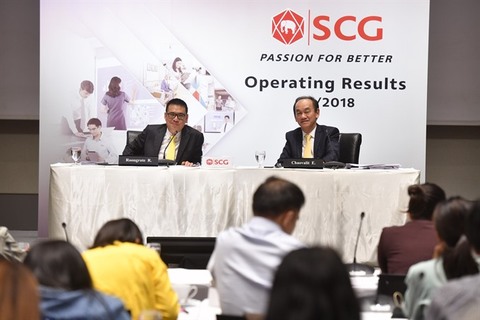 Thai company SCG has reported a jump in first half revenues to $639 million. SCG Vietnam has reported revenues of US$639 million in the first half of this year, a 20 per cent year-on-year jump. In the second quarter, revenues had risen by an even more impressive 28 per cent to $371 million, the Thai company said. SCG has a presence around Southeast Asia, with its three core businesses being cement and building materials, chemicals and packaging. It has more than 200 companies in its group and approximately 57,000 employees. It came to Viet Nam in 1992 as a trading business and has gradually diversified into cement, building materials, petrochemicals, and packaging. It recently bought Vietnam Oil and Gas Group (Petro Vietnam)’s 29 per cent stake in Long Son Petrochemicals, in which it holds the remaining 71 per cent, and is scheduled to sign a $3.2 billion loan deal with local and international financial institutions in August. The project’s engineering, procurement, and construction phase will start this quarter, and it is scheduled to go on stream by the first quarter of 2023. VinFast to open offices in Europe, Asia VinFast Trading and Production Limited Liability Company, a member of the property developer Vingroup, has just finished procedures to open an office in Frankfurt, Germany. According to VinFast, the business registration office of Frankfurt has issued a certificate of establishment of VinFast GmbH (Limited Liability Company) operating in the field of purchasing, selling, distributing and performing commercial transactions (including but not limited to import and export) on spare parts, components and materials for the automotive and related services industries. After cooperation with a number of German partners such as BMW, Siemens, Bosch, Durr AG, Schuler AG, Eisenmann, FFT and EBZ, the establishment of VinFast GmbH in Frankfurt reaffirms VinFast’s commitment to producing world class and high quality vehicles. In addition to Germany, VinFast is also completing final procedures to establish subsidiaries in Shanghai, China and the Republic of Korea. VinFast’s establishment of subsidiaries in major automobile manufacturing and consumption centres in Europe and Asia is the next step to enter the world’s automotive market, expressing the global vision of the Vietnamese car brand. Technically, this step will allow VinFast to easily access the most modern automotive manufacturing technologies and leading suppliers through partners in these countries. In terms of product research and development, establishing a presence in Germany, the Republic of Korea and China will create favourable conditions for VinFast to keep up with the latest trends in the global automobile industry. As regards to the market, VinFast’s offices will play a significant role in understanding consumer tastes in different regions of both continents, to export VinFast cars outside of the country. Registered capital of new firms up 11.6 percent Nearly 75,800 new enterprises were established nationwide in the first seven months of the year, with a total registered capital of 771 trillion VND (33.34 billion USD), a year-on-year rise of 3.9 percent in the number of firms, and a 11.6-percent rise in terms of capital, according to the General Statistics Office (GSO) of Vietnam. At the same time, more than 1,460 trillion VND (62.78 billion USD) was injected into operating firms, raising the total registered capital pumped into the economy to over 2,231 trillion VND (95.83 billion USD). The office said of the newly-established firms, 25,700 are in the wholesale and retail, and automobile and motorbike maintenance and repair industries, accounting for 33.9 percent of the total. This was followed by the construction sector with 10,000 firms (13.3 percent of the total), and processing and manufacturing with 9,400 companies (12.4 percent of the total). There are 5,700 firms operating in science-technology, consultancy, design, advertisement and others (7.6 percent). Regions nationwide witnessed an increase in the number of newly-established firms, with the Red River Delta host to 22,600 new companies (up 1.2 percent year-on-year), the midland and northern mountainous regions with 3,200 firms (2.8 percent), the north central and central coastal regions with 10,700 firms (7.4 percent), southeast regions with 32,100 firms (5 percent), and the Mekong Delta region with 5,400 firms (4.4 percent). The total number of workers at new companies was 623,000, down 13.5 percent against last year’s January-July period. During the reviewed period, 18,696 companies resumed their operations, up 6.5 percent from the same time last year. In addition, the number of businesses that ceased operations rose by 38.4 percent to 59,910 enterprises. Meanwhile, there were 7,714 firms who completed dissolving procedures, up 16.7 percent year on year. Most of them were operating in wholesale and retail, automobile and motorbike repairing industries (3,000 firms), processing and manufacturing (1,100 firms), and construction (792 firms). According to GSO General Director Nguyen Bich Lam, a flexible monetary policy, with a focus on prioritised sectors for small- and medium-sized enterprises (SMEs) and export firms, is a must in order to improve the operating efficiency of firms. In addition, the Government should continue to create a favourable business climate for companies, paying due attention to developing the processing and manufacturing sectors, supportive industry, and production of consumption goods, he added. Agro-forestry-fishery exports hit 22.2 billion USD in first seven months The export turnover of agro-forestry-fishery products in July was estimated at 2.85 billion USD, bringing the total value in the first seven months of 2018 to 22.2 billion USD, a year-on-year rise of 7.8 percent. According to the Processing and Market Development Authority (AgroTrade) under the Ministry of Agriculture and Rural Development, Vietnam exported 11.6 billion USD worth of farm produce from January to July, up 3.6 percent against the same period last year. Markets seeing strong export growth included Indonesia in rice, coffee, and rubber; Russia in coffee and cashew nuts; Germany in tea, cashew nuts, pepper, and rubber; Malaysia in rice, tea, wood, vegetables and fruit; the Philippines in rice and coffee; Saudi Arabia in tea; Iraq and Hong Kong in rice; the US in tea, cashew nuts, and pepper; India in rubber and pepper; and Thailand in vegetables and fruit, and aquatic products. Rice remained one of the biggest hard currency earners. Vietnam earned 1.96 billion USD from selling 3.87 million tonnes of rice abroad, up 29.2 percent in value and 12.2 percent in volume. China continued to be the largest rice importer of Vietnam with 26.8 percent of the market share. In the seven-month period, Vietnam earned 2.3 billion USD from exporting fruits and vegetables, mainly to China, up 12.6 percent. The country exported 1.16 million tonnes of coffee worth 2.22 billion USD, up 10.8 percent in volume but down 5.7 percent in value. Germany and the US remained the two biggest consumers of Vietnamese coffee. Vietnam sold 153,000 tonnes of pepper worth 517 million USD to overseas markets during the January-July period, up 3.7 percent in volume but down 36.1 percent in value. As many as 696,000 tonnes of rubber were exported in the period, bringing home 997 million USD, up 9.9 percent in volume and down 10.7 percent in value. Vietnam posts trade surplus of US$3.1 billion in first seven months Vietnam registered a trade surplus of US$3.1 billion in the first seven months of 2018, according to the General Statistics Office (GSO). Exports during the period were estimated at US$133.69 billion, up 15.3% annually, while imports were valued at US$130.63 billion, up 12.7% over the same period of 2017. The first seven months of 2018 saw domestic enterprises record a trade deficit of US$15.1 billion, while the foreign-invested sector, including crude oil revenues, ran a surplus of US$18.2 billion. Foreign enterprises remained the main export driver of the Vietnamese economy, accounting for 70.8% of the country’s total export revenues during the January-July period. A breakdown of the export markets shows that the US was the largest buyer of Vietnamese goods with US$25.5 billion, up 8.9%, followed by the EU and China, with their imports from Vietnam worth US$24.2 billion and US$19.5 billion respectively. Exports to the ASEAN market also recorded strong growth at 16.2% to US$14.2 billion, while exports to the Republic of Korea surged by 32% to reach US$10.2 billion. On the other side, China remained the largest source of Vietnam’s imports with US$35.8 billion. The Republic of Korea came second with US$26.5 billion and ASEAN third with US$18.1 billion. Medical expo next month in HCMC The 18th International Medical, Hospital & Pharmaceutical Exhibition (Vietnam Medi Pharm Expo) slated to take place in HCM City from August 2 to 4 promises to showcase new products and technologies. This year the expo has attracted 350 companies from 20 countries and territories, 20 per cent more than last year. The major exhibitors will be from India, South Korea, Malaysia, Japan, China, Iran, Ukraine, Russia, the US, Italy, Germany, and Singapore. They will display consumables; equipment for laboratories, dentistry, ophthalmology measurement and testing, endoscopy, operating rooms, and homes; pharmaceutical machinery; and drugs and food supplements. At the event, the Private Medical Practice Group of HCM City, the Family Physicians Association of HCM City and the Diabetes and Endocrinology Association of HCM City will organise seminars on diabetes. The expo, to be held at the Sai Gon Exhibition & Convention Centre in District 7 by the Viet Nam National Trade Fair and Advertising JSC (Vinexad) and the HCM City Medical Equipment Association. Provinces to host farm produce fairs A fair showcasing products of communes as well as hi-tech farm produce in the northern midland and mountainous region will be held this month in the northern province of Thai Nguyen. The ‘One commune one product (OCOP)’ fair aims to honour Viet Nam’s high-quality agro-forestry-fisheries products which are well-known in domestic and foreign markets, organisers said a press conference in Ha Noi on Tuesday. Nguyen Quoc Huy, Deputy Director of Thai Nguyen Department of Industry and Trade, described the forthcoming event as a good chance for cities and provinces in the region to advertise their potential and strengths in agriculture and green tourism. The fair, organised annually by Thai Nguyen province since 2016, will also offer a venue for businesses, farms and processors to exchange experience and set up partnerships, he said. The event will run from August 31 to September 6. Also at the press conference, the People’s Committee of Binh Dinh Province announced that it will host a fair displaying farm produce, seafood and timber goods from the south central coastal region from August 1-6. The upcoming event will contribute to promoting trade, as well as supporting and boosting agricultural production in a comprehensive, modern and sustainable manner, said Dao Van Ho, Director of the Trade Promotion Centre for Agriculture under the Ministry of Agriculture and Rural Development (MARD). In particular, advanced technologies in agricultural production, aquaculture and offshore fishing, preservation, processing and environmental treatment will be showcased, he added. Statistics from MARD revealed that the national export value of agriculture, forestry and seafood products in the first half this year marked an increase of 12 per cent over the same period last year, reaching US$19.4 billion. Of this, the export value rose by 9.7 per cent for agricultural products to reach $10.3 billion, by 10.5 per cent for seafood products to $3.94 billion and by 12.7 per cent for main forestry products to $4.33 billion compared to the same period last year. Cloud software provider Nutanix enters Vietnamese market US-based cloud computing company, Nutanix, is now present in Viet Nam to support business growth with its leading hyper-converged infrastructure solutions, including 100 per cent software-based and multi-cloud management technologies. Hyper-converged infrastructure streamlines the deployment, management and scaling of datacentre resources by combining server and storage resources with intelligent software. Separate servers, storage networks and storage arrays can be replaced with a single hyper-converged solution. The Nutanix Enterprise Cloud OS enables enterprises to simplify infrastructure for a better focus on delivering business values and innovation. Integrated data protection, non-disruptive upgrades and self-healing systems ensure predictable performance, reliable disaster recovery and efficient operations at lower cost. Some of the world’s most advanced datacentres rely on Nutanix Enterprise Cloud OS software to power their applications and services. In Viet Nam, tens of leading enterprises across different industries have chosen Nutanix. According to Gartner, an advisory firm, hyper-converged integrated systems will be the fastest-growing segment of the integrated systems market, reaching almost US$5 billion, which is 24 per cent of the market, by 2019. PVTex, APH sign contract to process yarn The Petrovietnam Petrochemical and Textile Fiber Joint-Stock Company (PVTex) with An Phat Holdings JSC (APH) and An Son Textile Fiber JSC on Tuesday signed a contract to process drawn textured yarn (DTY) made by Dinh Vu polyester fibre plant. This signing event was held to launch the DTY spinning lines for the filament factory at the Dinh Vu polyester fibre plant. The goal is to have all of these lines operating by the end of the fourth quarter. PVTex and APH signed a memorandum of co-operation on producing and trading Dinh Vu polyester fibre on April 27. This is one of 12 loss-making projects under the Ministry of Industry and Trade. The operation of the DTY spinning line resumed in April this year. After three months, the production lines are now operating well and have produced more than 500 tonnes of commercial DTY, which has been selling well. Ford Ranger remains best-selling pickup in Asia Pacific Pickup truck Ford Ranger has continued its success in the Asia Pacific in 2018 with sales increasing in the first six months by almost 9 per cent year-on-year to 69,103 units, Ford said. For the third year in a row Ranger was the best-selling vehicle overall in New Zealand, and remained the best-selling pickup truck in Taiwan and Viet Nam, the US company reported. It also continued with impressive share gains in Thailand’s pickup dominated industry, the company added. In Viet Nam, Ranger led the pickup truck segment for a fifth consecutive year with nearly 50 per cent of the market. Ford said it would roll out the new Ranger in markets across the Asia Pacific during the second half of the year. The company recently kicked off production of the first-ever Ranger Raptor at its Ford Thailand plant for export across the region. The vehicle will be sold beginning in August in Thailand and later this year in other markets. HCM City Computer Association, TAITRA ink deal The Taiwan External Trade Development Council (TAITRA) and HCM City Computer Association ( HCA) has signed a memorandum of understanding to foster trade and economic co-operation. Under the MOU, the two sides will exchange trade, market and economic information on goods and services and pursue partnership possibilities. As part of the agreement, they will notify and assist each other in trade exhibitions, fairs and similar events promoting products of both sides, and promote visits of trade and industrial missions between the two parties. In addition, they will organise meetings and seminars on both sides to inform business communities about investment, joint ventures and advantageous trade opportunities, and undertake together market studies on sectors of interest of both sides. HCA and members of HCA have been invited to send delegations to future editions of COMPUTEX, an international information technology show. The two parties agreed to hold joint meetings when necessary during the course of implementing the MoU and review achievements related to their cooperation once a year. SSC warns securities firms on cryptocurrency The State Securities Commission has recommended that public companies, securities companies and fund managers as well as securities investment funds not carry out issuance, trading and brokerage activities related to virtual currency. This is the second announcement by the market watchdog regarding Bitcoin and other cryptocurrencies since the first one on January 29 this year. The announcement is in line with the Prime Minister’s direction in April on strengthening the management of Bitcoin and similar forms of cryptocurrency in the country. In the prior notice, SSC warned investors and companies of potential risks related to cryptocurrency trading after an increasing number of companies are doing business in financial technology services (fintech) or raising capital through initial coin offerings (ICO), crowdfunding, peer-to-peer lending or blockchain, which are new products and technologies that have not been legally regulated. The SSC advised investors to be cautious when investing in new products to limit possible losses. For companies, while awaiting a legal framework for these products, the watchdog requested securities firms not participate in issuing, advising and trading virtual money and other financial technology products and comply with anti-money laundering laws. Also regarding the management of cryptocurrency transactions, in mid-July, the State Bank of Viet Nam said that it agreed with the proposal of the Ministry of Industry and Trade to suspend the import of cryptocurrency mining machines. Vietjet ranked among best listed companies Vietjet Aviation Joint Stock Company (HOSE code: VJC) has been honored by Forbes Magazine as one of Viet Nam’s 50 best listed companies in 2018. With revenue of over VND42.3 trillion (US$1.86 billion) in 2017, and market capitalisation of VND88.9 trillion ($3.9 billion), Vietjet was listed by Forbes for the second year in a row. The 50 companies honored by Forbes this year were evaluated for industry categories, rated on the basis of compound annual growth rate, profit, return on equity, earnings per share growth for the period of 2013–17, branding, quality of corporate management, source of profit and the prospect of sustainable development. According to Forbes’ statistics, the 50 best listed companies accounted for 70.8 per cent of total market capitalisation on the HCM and Ha Noi stock exchanges. After officially listing in February 2017, Vietjet quickly attracted investors’ attention thanks to impressive business results and joined the VN30 index in its first year on the stock exchange. In 2018, the company forecasts VND50.97 trillion in revenue and over VND5.8 trillion in profit, increases of 20.5 per cent and 10 per cent respectively compared to those of 2017. Vietjet has been one of the highest dividend payers in the market with 60 per cent in 2017, and is expected to pay dividend at a rate of 50 per cent in 2018. At the recent Farnborough Airshow 2018 in the UK, Vietjet signed order contracts for 100 Boeing 737MAX and 50 Airbus A321 increasing the total backlog of orders for Boeing to 200 aircraft and 171 for Airbus to serve its plans of expansion and alliance strategies in the region and the world. Vingroup to list 554 million more shares The HCM Stock Exchange has approved the additional listing of nearly 554 million shares, worth VND5.54 trillion (US$241 million), of private conglomerate Vingroup (VIC). At the current market price of VND106,000 per share, the company is valued at VND338.3 trillion ($14.7 billion) and is the largest company on the stock market. — Photo investnet.global These shares were from the issue in June to pay dividends for 2017’s business result. The total number of Vingroup shares will increase to 3.19 billion units after the decision. At the current market price of VND106,000 per share, the company is valued at VND338.3 trillion ($14.7 billion) and is the largest company on the stock market. The second biggest company is its real estate arm, Vinhomes (VHM), with market value of over VND284 trillion ($12.3 billion). The new shares are expected to start trading in early August. VIC share value climbed over 37 per cent since the beginning of this year. The company has yet to release its second-quarter earnings. It posted an after-tax profit of over VND1 trillion in the first three months of this year, a growth of 70 per cent against the same period last year. New co-working space opens in HCM City A new co-working space called Youth Five – Y5 Office opened on 135 Hai Ba Trung Street in HCM City’s District 1 on Tuesday. The space is located in the Business Startup Support Centre (BSSC), which has been a destination for the startup community in the city for six years. Covering an area of 500 sq.m, it includes 12 office studios which will be rented by startups and newly established businesses, and other common rooms and spaces for workshops and events. Truong Ly Hoang Phi, director of BSSC, said the space not only offers studio rentals at an affordable price, but is also a place for business meet-ups and a platform for entrepreneurs and experts to exchange ideas. At least half of the studios have been rented. As the number of studios is limited, the management team is using certain criteria to select startups that can lease a studio. The startups must have at least one co-founder under 35-years-old, and must address social issues or help foster a start-up ecosystem. Due to demand for affordable studios and space for startups, Phi said she was looking for funds from the private sector to set up similar co-working spaces in the city. The new co-working space is under the management of BSSC. Since its establishment in 2011, the BSSC has supported 4,000 businesses, provided training to 15,000 young entrepreneurs, and funded 1,000 projects with a total investment of VND100 billion (US$4.34 million). New property brand Alpha King launches Alpha King, a foreign-owned property developer and consultancy, officially launched in HCM City on Wednesday nearly two years after first coming to the country. It is owned by a foreign fund whose shareholders are from Shanghai, Hong Kong and Australia. But the company declined to name the fund or its size. It said it would focus on HCM City with developments in many segments like office space, luxury apartments and commercial space. It will also provide architecture and technical consultancy and assets management services. It is currently developing at least two projects in HCM City, Alpha Town and Alpha City. Alpha Town is a 72,000sq.m A-grade office building with 35 floors on Tran Hung Dao Street in District 1. Alpha City is a mixed-use development with a shopping mall and luxury apartments also in District 1. It will have two buildings, 49 floors, 40 for condos and eight floors for the mall. The two projects will be launched in the market in September. Jimmy Chan, CEO of Alpha King, laid out the company’s vision: “We believe we can redefine luxury living in Sai Gon and lay the foundation for a world class city. “Our mission is to constantly challenge ourselves to push boundaries, create unique landmark developments that last for generations. What we build is more than some high-rise buildings or shopping centres. “We want to introduce new lifestyle possibilities to different generations and elevate the quality of Vietnamese real estate projects to meet international standards.” The company said it uses cutting-edge technology in its projects such as BIM and smart living solutions to provide the best quality of light, water and air, and ensure fire safety systems meet international standards with its evacuation room having fire-proof walls and staircase designed perfectly for emergency exit in case of a fire. Consumption of E5 RON92 bio-fuel up 31.18% in H1 In the first half of 2018, total domestic petrol consumption in Vietnam reached about 4.43 million cubic metres, of which consumption of E5 RON92 reached about 1.78 million cubic metres, accounting for 40.18 per cent, a year-on-year increase of 31.18 per cent. Consumption of RON95 gasoline reached about 2.65 million cubic metres, accounting for about 59.82 per cent of total consumption, according to statistics from the Ministry of Industry and Trade (MoIT). The growth in the consumption of E5 RON92 gasoline in the reviewed period is due to its deployment for mass commercial operations nationwide, said Nguyen Loc An, deputy head of MoIT’s Domestic Market Department. In the reviewed period, the supply of petroleum has always met the demands of production and business, as well as personal consumption. There were no shortages of gasoline in any situation and national energy security was ensured. Retail prices of petroleum products are generally determined by wholesale traders and petrol distributors, however, the retail prices are not higher than the base price of petrol and oil announced by the MoIT and Ministry of Finance. Dong Thap seeks HCM City expertise to build agricultural supply chains HCM City will help Dong Thap build high-quality supply chains for agricultural products to improve their quality, officials told a conference held by the province People’s Committee on July 26. Nguyen Ngoc Hoa, deputy director of the city’s Department of Industry and Trade, said building supply chains with clear sources of origins and connecting manufacturers, distributors and customers are crucial to ensuring food safety and building customer trust. HCM City distribution networks will provide market information to manufacturers in the province so that they can tweak their production plans, and only buy high-quality products with clear origins from them. The city would also assist with branding and promotion, Hoa said. Nguyen Thanh Hung, deputy chairman of the Dong Thap People’s Committee, said since more and more high-quality foreign goods are entering the market and the demand for food safety is constantly on the rise, technology 4.0 has to be adopted in supply chains and by local manufacturers to be able to compete. Dr Dang Kim Son, director of the Ha Noi-based Institute of Policy and Strategy for Agriculture and Rural Development, said Dong Thap should improve its rice farming models and apply stricter quality standards for the rice supply chain. Nguyen Van Cong, director of the province Department of Agriculture and Rural Development, said five main local product groups -- rice, mango, flowers, duck, and shark catfish – are being developed, but after four years of facilitating their supply chains, only duck eggs and catfish meet international standards. The creation of high-quality supply chains still faces hurdles such as traders and distributors buying from unclear sources or unskilled co-operative groups, businesses and farmers, he said. Hùng said the province aims to create more high-quality agricultural areas for the province’s major produce and help businesses, farmers and co-operatives improve product quality and ensure food safety to set up supply chains and satisfy HCM City’s demand for high-quality goods. Hoa said HCM City is from where goods are shipped to other provinces or overseas. Real estate firms with social insurance debts named Many real estate companies in HCM City have failed to pay social insurance premiums for their employees in the first half of this year, according to HCM City Social Insurance. The companies were included on a list of 834 enterprises that have failed to pay social insurance premiums for their employees by June 30, 2018 that the agency recently published. There were a number of reasons for the prolonged debts of those enterprises, including difficulties in production and business, meaning the companies were unable to afford the premiums. They included Hoang Quan Group with a social insurance debt of VND6.6 billion; Khang Thong Group with VND4.4 billion; and No8 Investment and Construction Joint Stock Company with VND6.7 billion. Other real estate firms with social insurance debts were Cotec Investment and Land House Development JSC; Thai Son Viet Nam Building and Trade JSC; Tan Vu Minh Co, Ltd; Phu Khang Gia JSC; Phu Hung Construction and Trading Investment Co, Ltd; Thang Long Real Estate Trading Floor JSC; Nha Vui Architecture and Construction JSC; and Saigon Real Estate Development JSC, reported the Phap luat Thanh pho HCM (HCM City Law) newspaper online. Recently, Viet Nam Social Insurance has focused on directing social insurance in provinces and cities to strengthen specialised inspections on enterprises with large outstanding social insurance and health insurance debts. Then, it would transfer any cases in which an enterprise has deliberately delayed paying the debt to the investigating police agency. Ports to handle 200m tonnes of cargo by 2020 Viet Nam’s seaports are expected to handle more than 200 million tonnes of cargo by 2020, equivalent to 19.5 million tonnes TEUs (20-foot equivalent units) of freight containers, according to Transport Development and Strategy Institute. The amount would increase to 406-467 million tonnes (35.3 to 40.6 million TEU) by 2030. Statistics from the Viet Nam Maritime Administration (VMA) also show that over the past 20 years, the total amount of goods transported through the country’s seaports rose 30 times, from 3.4 million tonnes (532,000 TEUs) in 1995 to 165.7 million tonnes (14.3 million TEUs) in 2017. The first half of this year saw an amount of 8.7 million TEUs (20-foot equivalent units) of freight containers, up 28 per cent against the same period last year, and fulfilling 57 per cent of the target set for 2018. However, the institute said container transportation in the north has not met expectations. For example, container transport by road accounted for 72 per cent, railway 27 per cent and seaway less than 1 per cent, meaning that transport costs were still high. The institute added that transport by river was also limited. Meanwhile, the Viet Nam Logistics Association said container transport in the south had higher effectiveness as up to 35-40 per cent of goods were shipped to HCM City’s main seaports by sea. The association said authorities should study and develop an inland container depot (IDC) network and modern logistics centres to improve logistics quality, creating favourable conditions for container transport. Vietnam, Israel seek cooperation in cyber security Representatives of Vietnamese and Israeli businesses shared their experiences in cyber security at a workshop in Ho Chi Minh City on July 30. In Vietnam, around 27 percent of recent cyber attacks targeted the country’s key sectors, namely telecommunications and banking. Vietnam is also among those countries worldwide suffering from a high number of attacks on industrial infrastructure, with over 735,000 computers infected with malicious codes during the first five months of 2018, heard the workshop. According to Ngo Vi Dong, Vice President of the Vietnam Information Security Association, information security and safety in Vietnam has been improved, however, potential risks remain, especially for small-and medium-sized enterprises. Yaniv Tessel, head of the Economic and Trade Mission at the Israeli Embassy in Vietnam, said businesses, particularly larger ones, need to be ahead of the game with cyber security and information safety. Participating Israeli firms are ready to cooperate with Vietnam in cyber security activities, he said. Israel is the world’s second largest exporter of cyber security technologies, following the US. The country now has 300 companies operating in the field of cyber security. Ruth Shoham, Executive Director of the Capacity Building Division at the Israel National Cyber Directorate, said Israel and Israeli businesses have paid close attention to cyber security development. At the workshop, Vietnamese and Israel’s leading IT firms – namely CyberArk, Beyond Security, Claroty, Cyberbit, Ericom, and Skybox Security – sought ways to cooperate in this sphere for the time to come. VNN |
↧
Article 1
Minister accepts responsibility for national exam’s score manipulationHanoi – Minister of Education and Training Phung Xuan Nha has accepted responsibility for the recent score manipulation in the national high school examination in some provinces, pledging to seriously deal with those violations.  Minister of Education and Training Phung Xuan Nha (Photo: VNA) At the Government’s monthly meeting on August 1, he reported on the national exam held in late June, saying that the violations in northern Ha Giang and Son La provinces were very severe. His ministry has reported this issue to the Government leaders and is working closely with the Ministry of Public Security to handle the wrongdoings and involved persons in a strict and timely manner. Nha added those violations should not be cited as the reason for rejecting all test results or proposing the national exam be terminated. The ministry has reviewed the exam organisation and realised some shortcomings, he said, noting that it will continue to overhaul technical issues to ensure that all steps in the future examinations will be monitored strictly and conducted objectively and transparently. The official said reforming examinations and methods for assessing education outcomes is a breakthrough to help improve education-training quality. Since the high school graduation and university entrance tests were combined into one in 2015, the national exam has been improved, ensuring objective results and reducing pressure on students and society. At the meeting, Prime Minister Nguyen Xuan Phuc spoke highly of Minister Nha’s acceptance of responsibility, asking the ministry to continue absorbing opinions to better the exam organisation in the time to come. The last examination was taken by 5,400 students in Ha Giang. Of the 11 students with the highest scores nationwide, the province contributed three. Regarding the physics test, 65 students scored nine or higher. The abnormal result caused many to question the results, as the province does not typically perform so well. Inspections revealed that 330 multiple-choice tests of 114 students in Ha Giang were adjusted up by more than one point each. Meanwhile, Son La had more than 10,300 students sitting for the national exam this year with the average score of 4.21, the lowest in the country. The rate of students in Son La achieving nine points or more in maths and physics, however, outnumbered that of other localities that traditionally perform better. Several persons have been arrested for involving in the score skewing in the two provinces. VNA |
↧
↧
Article 0
Vietnam jumps 25 levels in WB’s logistics performance indexHanoi - Vietnam’s position in the Logistics Performance Index (LPI) in 2018 rose 25 levels compared to two years ago, jumping to the 39th among 160 surveyed countries, according to the latest report from the World Bank (WB).  Illustrative image (Source: VNA) This is the best result of Vietnam since 2007 when the WB announced the ranking for the first time. Representatives from the Ministry of Transport attributed the result to the improvement of the two indicators of “Logistics Competence” (up 29 levels) and “Tracking and Tracing” (up 41 levels). The report states that among the lower-middle income countries, large economies such as India and Indonesia, as well as emerging economies such as Vietnam and Côte d'Ivoire, stand out as top performers by showing a significant jump to a higher rank. The top five logistics performers this year are Germany, Sweden, Belgium, Austria and Japan. Among Vietnam’s neighboring countries, Thailand is still ahead, ranking 32nd. The LPI is the world’s logistics performance index released by the WB every two years. It is a unique benchmarking tool, providing the same measure for more than 160 countries. It measures performance on trade logistics within a country based on six indicators, namely the efficiency of customs and border management clearance; the quality of trade and transport-related infrastructure; the ease of arranging international shipments with competitive price; the competence and quality of logistics services; the ability to track and trace consignments; and the frequency with which shipments reach consignees within the scheduled or expected delivery time. The LPI is a crucial part of global efforts to better understand logistics performance in the context of increasingly complex supply chains. Thanks to the ranking, enterprises can get insight into logistics systems of each country, thus calculating the efficiency for their investment and business In 2016, Vietnam ranked 64th out of the 160 countries in the World Bank’s Logistics Performance Index and fourth in ASEAN after Singapore, Thailand and Malaysia. Vietnamese firms mainly provide domestic logistics services such as transport service, airport, seaport and warehouse services and cargo handlng services. Few firms provide international logistics services through acting as agents for foreign enterprises. VNA |
↧
Article 3
Điện Biên children risk lives fishing for wood ĐIỆN BIÊN - Children living near Nậm Mức stream in Búng Giắt Village in the northern mountainous province of Điện Biên are risking their lives collecting wood from the swiftly-flowing floodwaters.
Children risk their lives collecting wood after heavy flooding. - VNA/VNS Photo A Vietnam News Agency reporter observed a group of ten children (the oldest of about 13) took advantage of high water to jump into the stream and catch wood floating by. Torrential rain over recent weeks has caused landslides and increased water levels in streams and rivers of northern mountainous provinces. One of the children told the reporter that each time it rains heavily, children around the area head to the stream and collect wood to sell. If they are not quick enough to grab the wood, others will take it. So each time they see a promising log or branch, they swim as hard as they can in the flood water to grab hold of it. Lò Văn Dôm, a local from the Mường Mươn Commune of Mường Chà District said that parents have warned children about the risk involved but the children have so far ignored their pleas. In spite of efforts by local authorities to remind residents about the risk of wading into floodwaters, many families are still not aware of protecting themselves and their children. Last year the province recorded several deaths caused by catching wood and fish in dangerous flood water currents.
VNS |
↧
Article 2
BUSINESS NEWS IN BRIEF 6/8 HNX sells 15.77 trillion VND worth of bonds in July The Hanoi Stock Exchange (HNX) sold 15.77 trillion VND (677.4 million USD) worth of bonds during 33 auctions held in July, down 6.9 percent from June. Of the amount, the State Treasury raised 15.42 trillion VND and the Bank for Social Policies raised 350 billion VND. The interest rates of successfully bid 5-year bonds ranged from 3.45– 4.1 percent per annum, while those for 7-year bonds were from 3.85-3.9 percent per annum. Ten-year bonds fetched annual interest rates of 4.4-4.8 percent, and 15-year bonds fetched 4.7-4.78 percent per annum. The annual interest rate for successfully bid 20-year bonds was 5.22 percent, and that for 30-year bonds was 5.42 percent. In general, the interest rates showed increases for bonds of all terms compared to those sold in June. On the secondary G-bond market, the total volume of G-bonds sold by the outright method exceeded 554.6 million, worth more than 62.4 trillion VND, down 42.3 percent month-on-month. Meanwhile, trading volume through repurchase agreements (repos) reached over 902 billion bonds valued at more than 92.5 trillion VND, up 39.7 percent from June. Foreign investors made outright purchases of more than 2.18 trillion VND and outright sales of over 6.42 trillion VND. They did not conduct any repo transaction during July. Vietnam exports timber products to 120 countries, territories Vietnam has exported timber products directly to 120 countries and territories instead of having to go through a transit market like China’s Taiwan, Singapore and the Republic of Korea (RoK) to export to the third country. The US, China, Japan and the RoK are the four largest importers of Vietnam’s timber goods, accounting for 78.5 percent of the country’s total export value of those products. Other markets with strong growth are Malaysia, France and Australia. Wood and timber products ran a trade surplus of 3.52 billion USD in the period, with imports of those products standing at 1.24 billion USD, a slight increase of 0.4 percent compared to the same period last year. According to the Vietnam Administration of Forestry under the Ministry of Agriculture and Rural Development, main forestry products in January-July were estimated to earn the country over 5 billion USD, fulfilling nearly 56 percent of the yearly target and making up 22.6 percent of the total export turnover of the agriculture sector. The forestry sector recorded a trade surplus of 3.77 billion USD in the reviewed period. The export value of main forestry products continued to maintain a year-on-year average growth of over 14 percent. The export turnover of wood and timber products is expected to increase in the remaining months of this year in line with consumption habits. In addition, Vietnam and the European Union (EU) are completing legal procedures to approve the signing of the voluntary partnership agreement (VPA) on Forest Law Enforcement, Governance and Trade (FLEGT). By mid-July 2018, the European Commission (EC) approved the content of the agreement and agreed to submit it to the EU Council of Ministers for official signing. The Vietnamese Ministry of Agriculture and Rural Development has submitted the document to the Government for signing. Vietnamese steel exporters warned of possible 25% tax As the EC has issued a regulation to apply temporary safeguard measures, imposing quotas on 23 of 28 types of imported steel products, those steel firms whose steel exports exceed the allowed quota will have to pay an additional 25% tax. Three of Vietnam’s 23 steel products---non-alloy and other alloy cold-rolled sheets, metallic coated sheets and stainless cold-rolled sheets and strips---are subject to export quotas, while 20 other types of products shipped to the European Union are temporarily exempted from the quota regime, meaning they are not subject to the 25% tariff. However, Vietnam will face protectionist charges after February 3, 2019, if the country’s steel exports exceed quotas by 3% following the EC’s temporary protective measures. The Trade Defense Department will announce the quantity of steel bound for the European Union so that Vietnam’s steel enterprises and the relevant agencies can control and limit exports appropriately to avoid additional duties. Vietnam’s tea exports fall 6.9 percent in revenue 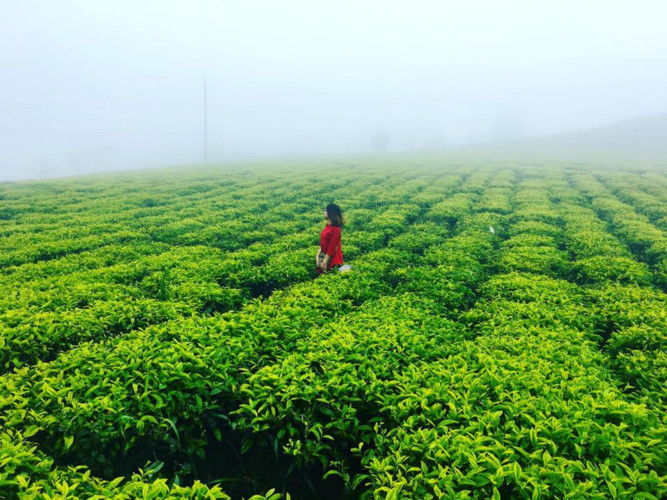 Vietnam’s tea exports as of mid-July dropped 11 percent year on year in volume to 61,530 tonnes, and 6.9 percent in value to 99.94 million USD, according to statistics from the General Department of Vietnam Customs. Pakistan was the largest consumption market of Vietnamese tea as it bought 13,400 tonnes worth 29.94 million USD, up 10.8 percent in quantity and 22.3 percent in value compared to the same time last year. Exports to the US, Saudi Arabia, Malaysia, Germany and the Philippines also rose. Notably, Vietnamese tea export growth in the US was higher than that of other exporters like China, Argentina, Japan, India and Canada. Vietnamese tea only occupied 2 percent in the US’s total tea imports, up from the market share of 1.6 percent recorded last year. A fall in tea exports in recent times has put pressure on the tea industry to enhance product quality amid rapid international integration and fierce competition. To increase Vietnamese tea value, producers and exporters must work to develop a value chain and pay attention to food hygiene and safety, said a representative from the Ministry of Agriculture and Rural Development’s Processing and Market Development Authority. Financial leasing significant to mobilise capital Financial leasing is an effective solution to solving medium- and long-term capital shortages for local businesses, head a conference held by the BIDV-SuMi TRUST Leasing (BSL) in Ho Chi Minh City on August 1. Financial leasing is an alternative way of financing whereby a licensed leasing firm purchases an asset on behalf of its customer in return for an agreed series of payments, which usually include interest. This kind of credit has become popular globally, with total revenue of up to US$1 trillion per year. In Japan, the annual figure is some US$50 billion. However, revenue from financial leasing in Vietnam was just VND8.6 trillion (US$369.8 million) by the end of the second quarter in 2018. According to Can Van Luc, Chief Economist of the Joint Stock Bank for Investment and Development of Vietnam (BIDV), there will be huge demand for machines, equipment and vehicles in the next two years as stable growth has been forecast for the Vietnamese economy, with GDP growth expected to exceed 6.5% during the period. With banks limiting short-term capital for medium- and long-term loans, and small and medium enterprises short of mortgageable assets, financial leasing is an important solution helping local firms overcome capital barriers, Luc said. BSL general director Nguyen Thieu Son said financial leasing mobilises resources for sustainable development. It also settles problems of money balance, capital restructuring and effective use of capital. Vietnam’s financial and banking sector has been developing rapidly, with 91 commercial banks, 27 financial and financial leasing firms and 1,100 credit institutions. Financial leasing has grown in stature as a channel to inject capital for local companies. Fujita Takeshi, BSL deputy general director, gave a bright outlook for the Vietnamese financial leasing market, due to expected overall economic growth. The BLS has designed financial leasing models to serve demands of companies, contributing to the development of businesses and the financial market, he added. It is a joint venture between the BIDV and Sumitomoto Mitsui Trust Bank, the first financial leasing joint venture between a Vietnamese bank and a foreign financial institution in Vietnam. With a chartered capital of VND900 billion (US$38.7 million), the venture is expected to attract more than 3,200 Japanese firms operating in Vietnam that have been using financial leasing services and other locally-based firms. Gas decree leads to confusion 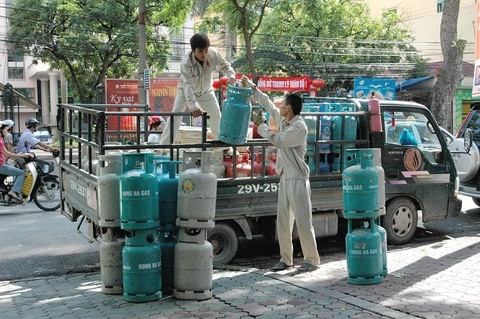 Both authorities and gas traders are facing difficulties in implementing Decree 87/2018 on gas trading, which took effect on July 31, heard at a conference held in Ha Noi on Tuesday. Nguyen Van Long, a representative from Hai Phong’s Department of Industry and Trade said according to the decree, gas businesses have to provide documents proving they meet requirements for fire prevention and fighting. However, based on the Fire Prevention and Fighting Law, the document that fully satisfies the requirements stipulates many conditions such as signs, regulations on responsibilities for fire prevention and fighting, electric systems, lightning protection, electric appliances, fire and heat sources to ensure fire safety. In addition, the law also stipulates that gas traders must apply for fire prevention tests as well as have a water supply and transport systems for the work. “According to the regulations, the Departments of Industry and Trade do not know which fire prevention regulations to follow, and this also makes it difficult for enterprises,” Long said. He proposed the Ministry of Industry and Trade (MoIT) give specific guidance. Departments of Industry and Trade and businesses should not have to search for different regulations themselves. “Do not let the companies ‘grope’ with the rules that we give,” he said. He added that the ministry which drafted the decree should have specific guidance on licencing of gas stations. A representative from Ha Noi’s Department of Industry and Trade wondered who will take responsibility for fires after licensing as the department is not required to visit businesses for evaluation. Answering the questions, Nguyen Huu Dung, Head of Industrial Safety Office under the ministry’s Department of Safety Technical and Industrial Environment said gas traders are required to implement fire prevention and fighting conditions themselves. Departments of Industry and Trade take responsibility for supervision and after-checkups. Nguyen Anh Son, director of MoIT’s Legal Department said gas businesses would not be granted licences if they do not meet conditions in reality despite having enough documents. “Decree 87 aims to simplify administrative procedures, removing business conditions and changing from before-check to after-check. Businesses will get fined or have their licenses revoked if violations are found,” Son said. A gas trader at the event also wondered if the decree requires gas production, distribution and retail businesses to record type of gas storage tank, serial number, customer name, address and delivery day. He said the work could take time and cost a lot of money as the number of gas storage tanks circulating was up to several millions. Gas firms would need big resources to manage information on gas storage tanks. “Gas traders are mainly household businesses and small-and-medium sized enterprises which do not have enough people to implement the regulation. Currently, the country has about 15,000 gas shops with only one to two labourers each. They would need an additional one or two people to do that, causing waste to businesses,” he added. Plastic products exports up 20% Exports of plastic products were worth US$1.43 billion in the first half of the year, a year-on-year increase of 20 per cent, according to the General Department of Vietnam Customs. They were shipped to many markets, with Japan being the largest, accounting for $312.5 million worth, 15.7 per cent up. Shipments to the US were worth $223.7 million, while the other major buyers were the Netherlands ($75.9 million) and South Korea ($75.3 million). Exports to many markets, including India, Hong Kong, Turkey, China, Ukraine, Russia, and Bangladesh, are rising. Shipments to India rose by over 159.4 per cent to $17.6 million. Exports to Hong Kong were up 158.8 per cent to $29 million. But exports to certain markets such as the Philippines (down by 31.3 per cent), Laos (26.3 per cent) and UAE (26.2 per cent) declined. According to the Viet Nam Plastics Association, the industry is one of those to achieve steady growth of 14-15 per cent a year with its export growing by 12-14 per cent annually. The industry still has a lot of room to grow because the per capita consumption of plastic products in Viet Nam remains low at 41kg per year, while it is 48.5kg in Asia and 69.7kg globally. Companies have increased investment in technology and plants and are tying up with foreign partners to improve their competitiveness. HCM City to host int’l food, beverage, packing expos A total of 550 enterprises from 20 nations and territories will take part in the 22nd International Exhibition on Food and Beverage and the 22nd International Exhibition on Food Processing, Packing Technology and Equipment (VietFood & Beverage – ProPack) to be held in Ho Chi Minh City from August 8-11. The participating businesses will showcase their products in 600 pavilions, including seven national ones of India, Poland, the Republic of Korea, Thailand, China and Vietnam. Nguyen Khac Luan, General Director of the Vietnam National Trade Fair & Advertising Joint Stock Company (Vinexad), said that more than half of 93 million Vietnamese people are aged under 30 and have improved income compared with the past. Therefore, the habit of buying convenience food is getting more popular, thus making Vietnam become a consumption market for food and beverage of considerable potential in the region, Luan said. Nguyen Ngoc An, deputy head of the Food and Foodstuff Association of Ho Chi Minh City, said the association continues to coordinate with Vinexad in organising the two exhibitions to create a prestigious venue for both domestic and foreign enterprises to introduce their products, boost trade and seek partners. With the trade value generated over the past more than 20 years, the exhibitions has drawn much attention from domestic and foreign enterprises, he added. A survey in 2017 showed that 80 percent of the exhibitors felt satisfied with the exhibition events, with 70 percent affirming to continue their participation in the next ones. Positive economic index in July Vietnam’s socio-economic performance in July continued to see positive developments with equal growth in all the three sectors, namely macro economy, industrial production and services. According to the General Statistic Office, the index of industrial production (IIP) in the month rose 14.3 percent, the highest level since February this year. In the first seven months of this year, the country’s IIP recorded the highest rise of 10.9 percent since 2012. The processing and manufacturing industry posted the strongest growth of 13.1 percent. Despite a year-on-year decline of 1.7 percent to 19.5 billion USD in July export turnover, that in the seven months rose 15.3 percent to 133.7 billion USD. The total retail sales of goods and services in July saw the highest growth of 13.3 percent since 2014. The newly-registered and increased foreign direct investment (FDI) in January-July period reached 18.15 billion USD, down 3.5 percent against the same period last year. However, the disbursement was estimated at 9.85 billion USD, a year-on-year increase of 8.8 percent. The number of newly-established firms in July decreased 7.8 percent against the previous month and 3.5 percent over the same month last year to 11,262 enterprises. In the seven months, the country saw 75,793 new businesses, up 3.9 percent compared to the same period last year, but lower than the six-month growth of this year (5.3 percent). The consumer price index (CPI) in July declined by 0.09 percent against June after three consecutive months of increase (April 0.08 percent, May 0.55 percent, and June 0.61 percent). Economists said Vietnam’s economy will encounter a number of challenges in the remaining months of this year; hence, the country should adopt a number of measures to realise the growth target of 6.7 percent in 2018. According to the Ministry of Industry and Trade, from now to the year’s end, there are still many unpredictable factors in the global economic environment, including the rising trade protectionism that will increase the risk of global trade war. In this context, a flexible adjustment of exchange rates could help Vietnam boost exports if the country is able to maintain macroeconomic stability, experts suggested. To ensure the economic growth target in 2018, Deputy Minister of Industry and Trade Cao Quoc Hung said his ministry will continue watching of the market, create an equally competitive environment, and protect the interests of domestic production industries, especially steel, automobile, fertilizer, and chemicals sectors, in association with reforming the economic structure and improving competitive edge. To keep the inflation rate below 4 percent as planned, the ministry will further work with relevant ministries, departments and localities to monitor the developments of goods supply and demand, as well as domestic prices. At a recent meeting of the National Financial and Monetary Policy Advisory Council, participants suggested managing effectively monetary and fiscal policies to bring inflation under control and keeping a close watch on the developments of raising interest rates of the US Federal Reserve (Fed) as well as issues arising in the China-US trade conflict. Sacombank adopts credit risk measurement model Sacombank has begun installing a Credit Risk Model, which will help measure the risk of business portfolios for formulating business strategies, managing credit portfolios and portfolio limits, and classifying assets based on risk levels. It will also help the bank evaluate lending limits based on risk analysis of customer segments and product portfolio, develop new products, assess the level of expected risks and losses to determine the level of retained capital needed to ensure safe operation, and improve and optimise the process of lending. Through this and a project to complete the risk management database framework launched on July 25, Sacombank is accelerating the process of completing the Standardised Approach and adopting the Internal Rating Based Approach proposed under the Basel II capital adequacy rules for banks. Phạm Văn Phong, the bank’s permanent deputy chairman, said: “Implementing Basel II not only aims to meet the requirement of the State Bank of Vietnam, but also, more importantly, to perfect the management system of Sacombank. “So we will focus the maximum resources to accomplish this goal.” The credit risk model is being installed with consultancy from PricewaterhouseCoopers (PwC) and deployed by CMC Saigon System Integration Co.,Ltd. Novaland reports 29 per cent sales growth Housing developer Novaland Group has reported revenues of nearly VNĐ4.3 trillion ($188.5 million) in the first half of this year, a 29 per cent increase year-on-year. Profit after tax was VNĐ723 billion ($31.2 million). NVL said the revenues were mostly from Lakeview City, Rivergate Residence, The Tresor Residence, Golden Mansion, Wilton Tower, Kingston Residence, and Lucky Palace. They would remain the mainstay in the second half too, it said. In the period the company had mobilised $310 million from a bond issue. NVL, established in 1992, has developed 40 housing projects so far, most of them in HCM City. Toyota launches next generation models Toyota Motor Vietnam (TMV) on Wednesday officially introduced its new generation Vios and Yaris 2018. The new generation Vios provides customers, especially families and young people, with a variety of exterior choices with the addition of Red 3R3, while the new generation Yaris is impressive with a whole new appearance in three dynamic colors: Yellow 6W2, Red 3R3 and Orange 3R8. The models with quality design and advanced convenience and safety features will be officially on sale across TMV’s dealer network nationwide from now with three new kinds of Vios with prices ranging from VND531million to VND569 and 606 million while the Yaris is priced at VND650 million. Officially launched in August 2003 as a strategic CKD model, Vios has continuously consolidated its leading position in the compact-mid segment and persistently maintained its position as the number one top selling model in the market with total sales of more than 114,000 units as of July 2018, while Yaris has sold more than 12,000 units as of December last year. Plastic products exports up 20 percent Exports of plastic products were worth 1.43 billion USD in the first half of the year, a year-on-year increase of 20 percent, according to the General Department of Vietnam Customs. They were shipped to many markets, with Japan being the largest, with 312.5 million USD, 15.7 percent up. Shipments to the US were worth 223.7 million USD, while the other major buyers were the Netherlands (75.9 million USD) and the Republic of Korea ($75.3 million USD). Exports to many markets, including India, Hong Kong, Turkey, China, Ukraine, Russia, and Bangladesh, are rising. Shipments to India rose by over 159.4 percent to 17.6 million USD. Exports to Hong Kong were up 158.8 percent to 29 million USD. But exports to certain markets such as the Philippines (down by 31.3 percent), Laos (26.3 percent) and UAE (26.2 percent) declined. According to the Vietnam Plastics Association, the industry is one of those to achieve steady growth of 14-15 percent a year with its export growing by 12-14 percent annually. The industry still has a lot of room to grow because the per capita consumption of plastic products in Vietnam remains low at 41kg per year, while it is 48.5kg in Asia and 69.7kg globally. Companies have increased investment in technology and plants and are tying up with foreign partners to improve their competitiveness. Demand for rental office continues to rise Vietnam’s rental offices exceeded other countries in 2017. The end of 2017 marked a transformation of the condominium market from robust growth to more sustainable growth with high profit. The positive trend still maintained in the first six months of 2018 and economists said leasing office market would grow more. One of the reasons is that limited supply. According to CBRE Vietnam, the current trend suggests inadequate supply of grade A buildings. Specifically, in the first quarter of 2018, grade A buildings was just 382,763 square meter and 813,362 square meter for grade B buildings in Ho Chi Minh City yet in the next quarter, no new building for leasing will be inaugurated. It is forecast that from now to end of 2018, just two grade B buildings will be operative in HCMC but not much space for leasing because investors will use it as their office. There was no new supply in Ho Chi Minh City’s office market in the second quarter of the year, according to CBRE’s Q2 Quarterly Report; accordingly, rent price skyrocketed in past time. For instance, in the first quarter, it were $39.71 per square meter per month for grade A building and $22.35 per square meter per month for grade B building. With such price, there has been an increase of 3.5 percent q-o-q and an increase of 7.4 percent y-o-y. for grade A building. While in the second quarter, grade A rent price increased by 7 percent against the previous quarter and 17 percent compared to the same last year because new buildings are soon filled out and new supply is quite rare. According to CBRE, in first six months of 2018, no supply of grade A and B buildings. It is expected that in last months of the year, buildings with 125,000 square meters will be supplied bringing up the rental office area to 1.4 million square meter. Though total new supply showed a decrease, good product configuration helps the market to maintain good absorption. According to James Lang LaSalle (JLL) Vietnam report, average occupancy rate of office buildings in the HCMC achieved greater than 95 percent occupancy. This showed an extremely high demand in the market for both Grade A and Grade B office submarkets. Especially, net absorption in grade B building is thanks to giant rent area in newly buildings with 9,000 square meter filled out by local firms, foreign companies and Non-government organizations. Economists valued that demand for rent building will maintain high, more companies are seeking big and high quality leasing area; consequently, rent will go up by 2 percent annually and all buildings will be filled out. Marketing research companies’ statistic, more buildings were built in 2014-2016 and 2017 is considered as the year to absorb all supply. 2018 will be the year for transformation of boom in 2019 and 2020. Research companies predicted building supply will boom resulting in new circle in two next years. Investors will carry out new projects when all buildings were absorbed. Dang Phuong Hang, Managing Director of CBRE, expects that Grade A rental will maintain its increasing trend because of limited available supply from now until late 2019 or early 2020. Vacancy rates will also decrease slower because of Grade A’s higher rentals. Grade B is expected to see more stable and healthy performance because of its small but more constant supply from now until 2019. The market from 2018 - 2020 will still be a landlord’s market. HCMC wants more enterprises to access city’s stimulus program HCM City would continue improving admin procedures, investment environment, creating favorable condition, having preferential policies, helping enterprises develop effective production & business. HCMC wants more enterprises to access city’s stimulus program Chairman of the HCMC People’s Committee Nguyen Thanh Phong asked the departments of Investment & Planning and Industry & Trade in coordination with relevant agencies to re-check the city’s stimulus program; report to the city to make suitable adjustments with aiming at creating favorable condition for more enterprises to access the program. Chairman Phong concluded it in an announcement of the result of the meeting between the city leaders with HCMC Mechanical-Electrical enterprises. As per the announcement, the city plans to re-check land fund to increase land for the industry on hi-tech applications, limiting the industries to use many laborers. In addition, the city would form some industrial parks for innovative start-ups. Therefore, mechanical-electrical enterprises should propose plan for itself upcoming industrial park. HCMC will support enterprises in promoting their products to 50 consumption markets cross over the world which the city has signed cooperation agreements. However, enterprises should also seek actively other potential markets. On the other hand, the city would continue improving admin procedures, investment environment, creating favorable condition, having preferential policies, helping enterprises develop effective production and business. Besides, the city suggested mechanical-electrical enterprises to link together for its sustainable development. Steel exporters warned of the risk of exceeding export quotas to Europe The Trade Remedies Authority of Vietnam, under the Ministry of Industry and Trade, has issued warnings to steel exporters to European countries. Accordingly, the European Commission (EC) has decided to initiate investigations on the application of safeguarding measures on 28 groups of imported steel products, of which 23 are subject to tariff quotas. Three out of the 23 groups of Vietnamese products subjected to tariff quotas include cold-rolled and non-alloy steel, galvanised steel sheet and cold-rolled stainless steel sheet and bars. For the other 20 steel product groups from Vietnam, the EU has temporarily excluded them from the quotas application range and they will not be subjected to the 25% tariff in excess of quota. However, if during the application period of provisional safeguard measures, the importation of these products from Vietnam in excess of 3% would face the risk of being excluded when the EC applies official safeguard measures after February 3, 2019. The Vietnamese agency will publish monthly export data to the EU in order to alert the possibility of exports exceeding the 3% threshold and the risk of being subject to formal safeguards by the EC. Airbus to work with Vietnam to develop country’s space industry Airbus and Vietnam’s Ministry of Science and Technology (MoST) have signed a letter of intent (LoI) indicating their plans to work together on several areas of interest in the space sector. Potential areas of collaboration between Airbus Defence and Space and MoST include the exchange of information on issues related to Earth observation, organizing and participating in scientific and technological events and research on satellite technology. “Airbus and Vietnam are already partners on the VNREDSat-1 satellite, and with the recently signed LoI, we hope to further support the development of Vietnam’s space industry. The agreement will allow us to continue working together, strengthening our close ties,” Nicolas Chamussy, head of Space Systems, Airbus, said in a statement. In 2010, Airbus was awarded a contract to develop, manufacture and launch Vietnam’s first Earth observation satellite. VNREDSat-1 was successfully launched in May 2013, enabling Vietnam to better monitor and study the effects of climate change, predict natural disasters and optimize the management of its natural resources. As part of the VNREDSat-1 program, Airbus and the Vietnam Academy of Science and Technology established bilateral cooperation that included academic and on-the-job training programs for Vietnamese engineers, as well as technology transfer. Airbus has been a partner in the Asian space sector for almost 40 years, supplying space equipment for geostationary and low-orbit spacecraft operators in Japan, Singapore and South Korea. Airbus has also helped launch satellites for Australia, India, Indonesia, Japan and South Korea. With 15 international programs in place, Airbus is the leading exporter of Earth observation satellite systems worldwide and provides turnkey solutions to both civilian space agencies and defense organizations. Benefiting from decades of experience in the development of satellite systems designed for dual use, the AstroBus-S is ideal for very-high resolution applications, combining the advantages of a low-mass system with the strong performance of a larger platform. In Vietnam, in addition to the VNREDSat-1 satellite, Airbus has successfully provided solutions for its commercial aircraft, defence and helicopter businesses. The European manufacturer is also developing its industrial presence in the country, where several local firms supply aerostructures and components across the Airbus civil aircraft product line. This helps generate fulltime employment for 550 highly skilled Vietnamese workers. In education, the company is supporting the development of two new degree programs at the University of Science and Technology of Hanoi, aimed at helping Vietnam meet its growing requirements for aerospace engineers and professionals. Real estate inventories drop The total value of property inventories had plummeted to a little more than VND24 trillion as of June 20, down by VND700 billion compared with the first quarter of this year, according to a report by the Department of Housing and Real Estate Market Management under the Ministry of Construction. Nguoi Lao Dong newspaper cited the report as saying that the property market maintained steady growth in the first six months of 2018, rising by 4.12% year-on-year. The real estate sector recorded the registration of some 3,300 new firms, up by a staggering 44.2% year-on-year. The sector saw new foreign direct investment approvals totaling some US$4.9 billion. The total capital of property projects now underway is estimated at VND3,500-4,000 trillion. The total value of property inventories as of June 20 slipped to VND24,072 billion. Real estate loans account for 6-8% of total outstanding loans, remaining under control. According to the Department of Housing and Real Estate Market Management, medium- and high-end properties have faced a slowdown, but low-cost condo buildings and houses have risen slightly due to high demand and limited supply. Nguyen Trong Ninh, head of the department, noted that the real estate market will not see major changes in the rest of the year, insisting that stable development was more likely. He, however, warned property firms of the fever for vacant land in some localities as several individuals have been taking advantage of the plan to establish special economic zones and large traffic projects, such as Long Thanh International Airport, metro lines in HCMC and expressways, to spread rumors of land price rises. Vietnamese steel exporters warned of possible 25% tax The Ministry of Industry and Trade has announced that a steep tariff is likely to be imposed by the European Commission (EC) on Vietnam’s steel processors and exporters. The ministry made the prior announcement to help steel firms cope with the tough time ahead, reported Sai Gon Giai Phong newspaper. As the EC has issued a regulation to apply temporary safeguard measures, imposing quotas on 23 of 28 types of imported steel products, those steel firms whose steel exports exceed the allowed quota will have to pay an additional 25% tax. Three of Vietnam’s 23 steel products---non-alloy and other alloy cold-rolled sheets, metallic coated sheets and stainless cold-rolled sheets and strips---are subject to export quotas, while 20 other types of products shipped to the European Union are temporarily exempted from the quota regime, meaning they are not subject to the 25% tariff. However, Vietnam will face protectionist charges after February 3, 2019, if the country’s steel exports exceed quotas by 3% following the EC’s temporary protective measures. The Trade Defense Department will announce the quantity of steel bound for the European Union so that Vietnam’s steel enterprises and the relevant agencies can control and limit exports appropriately to avoid additional duties. Vietnamese steel exporters warned of possible 25% tax The Ministry of Industry and Trade has announced that a steep tariff is likely to be imposed by the European Commission (EC) on Vietnam’s steel processors and exporters. The ministry made the prior announcement to help steel firms cope with the tough time ahead, reported Sai Gon Giai Phong newspaper. As the EC has issued a regulation to apply temporary safeguard measures, imposing quotas on 23 of 28 types of imported steel products, those steel firms whose steel exports exceed the allowed quota will have to pay an additional 25% tax. Three of Vietnam’s 23 steel products---non-alloy and other alloy cold-rolled sheets, metallic coated sheets and stainless cold-rolled sheets and strips---are subject to export quotas, while 20 other types of products shipped to the European Union are temporarily exempted from the quota regime, meaning they are not subject to the 25% tariff. However, Vietnam will face protectionist charges after February 3, 2019, if the country’s steel exports exceed quotas by 3% following the EC’s temporary protective measures. The Trade Defense Department will announce the quantity of steel bound for the European Union so that Vietnam’s steel enterprises and the relevant agencies can control and limit exports appropriately to avoid additional duties. Dong Nai: Export revenue surges 12.7 percent The southern province of Dong Nai earned more than 10.6 billion USD in export revenue in the first seven months of 2018, a year-on-year increase of 12.7 percent. Of the total, the foreign direct investment (FDI) sector contributed 9.1 billion USD. Meanwhile, the non-State and State-owned sectors bagged 1.4 billion USD and 132 million USD, respectively. The surge in export revenue was spurred by large orders, new export markets and the rise in export prices of some products. During the period, shipments of footwear fetched 2 billion USD, garment and textiles more than 1.1 billion USD, machines and equipment 776 million USD and computers, electronic products and spare parts 384 million USD. Major importers of the locality were the US (2.3 billion USD), China (more than 1 billion USD) and Japan (896 million USD). An export upturn was also seen in the Republic of Korea and Germany. Local coffee, pepper, cashew and rubber experienced a decrease in export revenue due to stagnant demand and large stockpiles. Specifically, each tonne of cashew is currently sold at 9,282 USD, down 12.5 percent, while that of coffee and pepper was 1,803 USD and 3,533 USD, falling 25.2 percent and 41.7 percent. In the same period, the province splashed out 9 billion USD on imports, up 8.1 percent from the same period last year. The province enjoyed a 1.6 billion USD trade surplus, accounting for more than 50 percent of the country’s trade surplus during the January-July period. Aquatic product export expected to rise 13 pct in Q3 Export revenue of aquatic products is estimated to hit 2.7 billion USD in the third quarter, a 13 percent rise year-on-year, said the Vietnam Association of Seafood Exporters and Producers (VASEP). After a strong increase of 17 percent in the Q1, aquatic products exports in the following quarter slowed down to 5.7 percent, raking in 2.2 billion USD. The slower increase rate was attributed to sharp decline in shrimp prices amid increasing global supply. In July, export value of aquatic products was at 793 million USD, up by 7 percent year on year thanks to the recovery of shrimp shipments. The figure for the first seven months came to about 4.78 billion USD, up 8.5 percent against the same period in the previous year. According to experts, aquatic exports are facing many challenges in import markets, including anti-dumping tariffs on shrimp and tra fish in the US and the European Commission’s “yellow card” on illegal, unreported, and unregulated (IUU) fishing. However, as demand for shrimp is likely to rise and domestic prices of material shrimps become stable, export is expected to recover in upcoming months. In January-July, shrimp export earned nearly 2 billion USD, recording an increase of 5.5 percent year-on-year. Aside from shrimp exports, VASEP said that tra fish exports will see stronger growth, at around 30 percent, in remaining months of the year, along with seafood products like tuna, squid and octopus. East-West Economic Corridor int’l fair opens in Da Nang The East-West Economic Corridor’s International Trade, Tourism and Investment Fair – Da Nang kicked off in the central city of Vietnam on August 3. The event, which will last through August 8, features over 350 booths of nearly 200 Vietnamese and foreign businesses. It showcases various tourism, trade and investment products such as electrical, electronic and IT products, processed food, wood products, home accessories, leather footwear, apparel, pharmaceuticals and cosmetics, along with restaurant and hotel services. Other activities of the fair include a conference to connect suppliers and buyers, a workshop introducing Cambodia’s tourism and travel tours. In his opening speech, Deputy Minister of Industry and Trade Do Thang Hai said the fair has been held annually over the past years to introduce development achievements and trade, investment and tourism potential of Vietnam’s central and Central Highlands regions, localities along the East-West Economic Corridor, and countries of the Greater Mekong Subregion. He expressed his belief that this year’s event, with a diversity of high-quality products, would be an effective platform for enterprises to access consumers, promote trade and seek business partnerships. It would also help step up trade, investment and tourism ties among central and Central Highlands provinces, and increase trading activities with neighbouring countries, he added. The 1,450km-long East-West Economic Corridor links the Indian Ocean and the Pacific Ocean. It begins at the Myanmar port city of Mawlamyine and ends at Da Nang Port of Vietnam. It traverses 13 provinces and cities of Myanmar, Thailand, Laos and Vietnam, which are members of the Greater Mekong Subregion. VNN |
↧
Article 1
Floods, landslides kill six in northern mountainous regionHanoi -Floods and landslides triggered by torrential rains in the past days had left six dead, five missing and two injured in the northern mountainous region by 17:00 on August 5.  A large crack appeared on a hill in the northern province of Yen Bai after prolonged rain.(Photo: VNA) According to the Central Steering Committee for Natural Disaster Prevention and Control, the natural disaster also collapsed seven houses, inundated 276 hectares of rice, destroyed 25 hectares of agricultural land and damaged four cultural works and schools. In the northern mountainous province of Lai Chau, more than 1,700 households in three remote communes are temporarily isolated due to prolonged heavy rains. Heavy rains in the past week caused serious landslides along the roads connecting Khong Lao and Si Lo Lau communes in Phong Tho district, making three communes of Vang Ma Chai, Ma Ly Chai and Si Lo Lau inaccessible. Besides efforts to search for the missing people from Vang Ma Chai commune, the district’s authority is mobilising all forces including militiamen, police, border soldiers, and defence force and necessary facilities to soon clear the damaged traffic route. Initial statistics from the Phong Tho district People’s Committee showed hundreds of landslides occurred during the flooding, with more than 100,000cu.m of rock, soil, and other earth materials. Chairman of the Phong Tho district People’s Committee Tran Van Que said damage to the roads in the district as a result of the rain and flooding was substantial, meaning repairs were quite difficult and costly. “Goods and other essential commodities for local people are in good stock. We also assigned relevant authorities to monitor the market price in the area to avoid the possibility of a price hike,” Que said. In another development, landslides occurring at Km74 in National Highway 4H running through the nearby Dien Bien province early August 4 also made stopped traffic for nearly 30 hours. Traffic congestion is serious. Roads were temporarily opened at 8:30am on August 5, Director of Land Road Company II LuongThanh Tung, said. Lorries and passenger buses were helped by specialised excavators and bulldozers to get through, whilst four-seat automobiles couldn’t move, he added. Landslides occurred on another section of the National Highway 4H in Nam Po district’s Cha Nua commune on August 5 morning. Landslides also took place on National Highway 12 linking Dien Bien and Lai Chau provinces, causing traffic jams for hours. VNA |
↧
↧
Article 0
Social News 6/8 Workers’ right must be ensured amid CPTPP implementation: unions 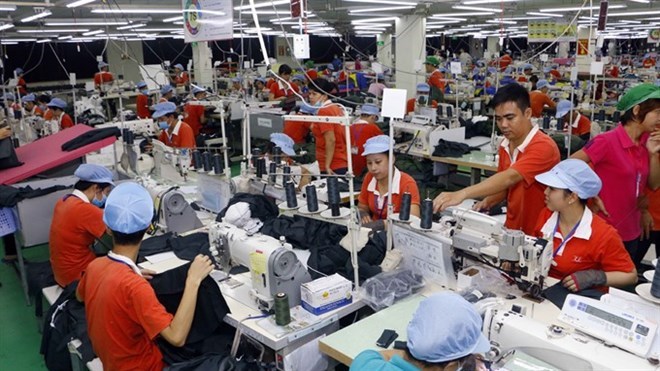 Trade unions should work to ensure workers’ rights and interests amid challenges arising from the implementation of the Comprehensive and Progressive Agreement for Trans-Pacific Partnership (CPTPP), a trade union official stated on August 3. Vice President of the Vietnam General Confederation of Labour (VGCL) Tran Thanh Hai made his statement at a seminar on CPTPP opportunities and challenges facing workers’ jobs and rights, held by the Thua Thien – Hue Labour Confederation in the central province. The seminar received 26 papers by experts, lecturers, and trade union officials. Their contents revolved around a number of issues, including advantages – disadvantages in ensuring workers’ rights when the CPTPP takes effect, as well as suggestions to the revision of the 2012 Labour Code and the Law on Trade Union in order to facilitate and promote the role of trade unions. Le Dinh Quang, deputy head of the VGCL’s Labour Relations Department, said when the deal comes into effect, it will be more likely for workers to lose their jobs, as companies with weak performance will face high risks of bankruptcy. Labour relations will also become more complicated due to the formation of more organisations following different purposes, Quang noted. Speaking from the current operation of the Thua Thien – Hue Labour Confederation, Nguyen Quoc Dat, member of the confederation’s standing board, said for membership development, trade unions should overhaul their establishment method, particularly the election process. The scope of their eligibilities for membership should also be expanded to cover part-time workers, domestic workers, and foreign workers in Vietnam, he added. The original Trans-Pacific Partnership (TPP) was signed by 12 countries in February 2016, but US President Donald Trump pulled his country from the deal upon his inauguration in January 2017. The remaining 11 countries – namely Australia, Brunei, Canada, Chile, Japan, Malaysia, Mexico, New Zealand, Peru, Singapore, and Vietnam – signed the pact and renamed it the CPTPP during their meet-up in March 2018 in Chile. The CPTPP will create one of the world’s largest free trade blocs with a combined market of 499 million people and GDP of around 10.1 trillion USD, accounting for 13.5 percent of the global GDP. Mexico, Japan and Singapore have ratified the pact. Hanoi reports abnormal rise in measles cases 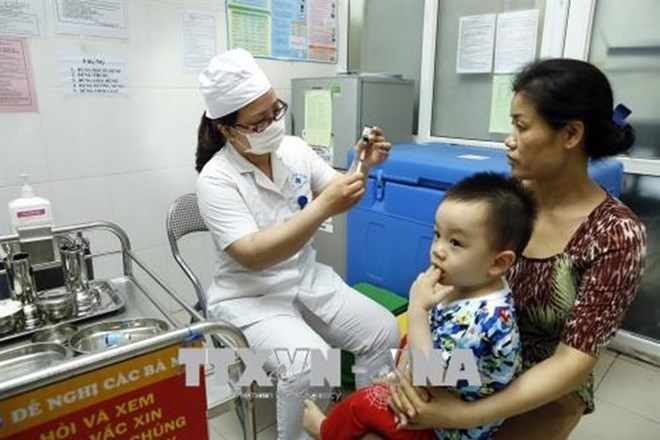 As many as 271 cases of measles have been reported in Hanoi since the beginning of this year, compared to just 60 for all of last year. According to the municipal Department of Health, the number of cases has increased weekly and most measles patients were children under five years old. Most of the infected children have not been vaccinated or did not receive full vaccinations. In some cases, newborns under nine months old who were not old enough to get the measles vaccination caught the disease because they did not receive proper measles antibodies from their mothers. Director of the Hanoi Preventive Medicines Centre Nguyen Nhat Cam said that the measles cases were found across all districts in the city, not localised in one area. He said about 140,000-150,000 babies were born in Hanoi yearly and about 5 percent of the newborns were not vaccinated. Measles can spread easily, Cam said, warning parents to have their children vaccinated properly. Doctor Dang Nhat Quang from Saint Paul Hospital said it was abnormal to see more children get measles during the summer as the peak time for measles outbreaks is usually the transition period between winter and spring. Hospital-infection control work key task of health sector 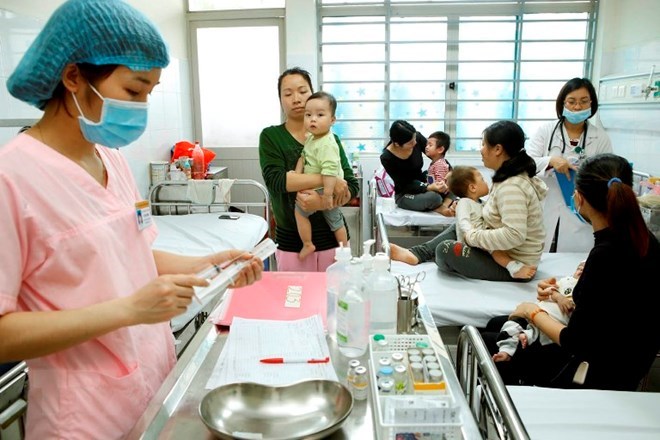 A patient room at the Vietnam National Children's Hospital in Hanoi Hospitals and clinics in Vietnam have started implementing surveillance of nosocomial infections and monitoring the hospital-infection control process, Deputy Minister of Health Nguyen Viet Tien said at a recent meeting. Measures include the monitoring of hand hygiene compliance, hospital microbial surveillance and antibiotic resistance, step by step standardisation of disinfection, hospital hygiene improvement, and disease prevention, Tien said at the meeting organised by the Health Ministry in Hanoi this week that aimed to implement the new Circular on hospital-infection control regulations. The Ministry of Health has just issued Circular No.16/2018 that regulates hospital-infection control, to replace the previous Circular No.18/2009. Director of the Ministry of Health’s Medical Examination and Treatment Department Luong Ngoc Khue said according to the new circular, hospitals with over 150 beds must have a hospital-infection control department, and hospitals with under 150 beds must have an infection control office with full-time staff. “The head of the hospital must be fully responsible for hospital-infection control plans,” Khue said. “Full-time supervisors, disinfectants and sterilisers must have Ministry of Health certificates or degrees in hospital-infection control (with training time of three months).” Khue added the new circular also suggested hospitals seek investment and funding from different sources to develop hospital sanitation measures and waste treatment under the professional control of the hospital-infection control department. “The circular is an important step to determine hospital-infection control work as a key task of the health sector.” However, Deputy Minister of Health Nguyen Viet Tien acknowledged that the work of hospital-infection control in Vietnam still faced many challenges. At some clinics, management has not yet fully understood the role and importance of hospital-infection control work, so investment has not been appropriate or effective, according to Tien. “Human resource management for hospital-infection work is inadequate and weak in contributing to the effective prevention and control of antibiotic resistance, medical complications, and of contagious disease,” Tien said. In particular, with the development of diseases in developing countries, including Vietnam, infectious diseases accounted for a high proportion with many newly-emerging diseases bringing a high risk of death, occurring not only in communities but also in hospitals, such as influenza A (H5N1, H1N1, H7N9), MERS-CoV and Ebola, according to the deputy health minister. This was one of the major challenges facing the health sector’s hospital-infection control work. According to the Ministry of Health, the ratio of patients suffering from hospital-acquired infections in Vietnam ranges from 4-8 percent of total patients being treated at hospitals. In fact, there have been a number of wide-spread cases, including the measles outbreak in 2014 that infected many children being treated at the Hanoi-based National Hospital of Paediatrics. In November, 2017, a hospital-acquired infection case at the Bac Ninh obstetrics and maternity hospital killed four babies, and many others were infected with various levels of severity. In June 2018, many children in Dien Bien Dong district in the northern mountainous province of Dien Bien were also infected with measles after being treated at a district health clinic. There are many risks of infection in hospitals, including from drinking water, toilets and medical equipment. To ensure the hygiene and safety of patients, many hospitals have installed soap, clean bed sheets and toilets to prevent infections. Nguyen Tan Hoa, 54, from southern Dong Nai province, was taking care of his wife, a cancer patient at HCM City Tumour Hospital, saying “There are free water bottles, which is good for patients and their family members. But in a crowded hospital, with all kinds of sickness, bottles should be cleaned thoroughly.”-VNS/VNA Art exhibition promotes understanding among Mekong nations 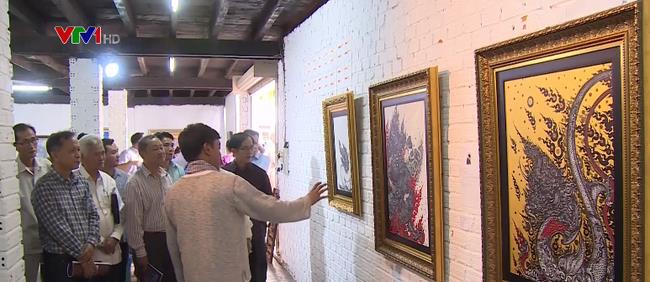 Fifty oil paintings depicting cultural features and social activities of people living along the Mekong River in Vietnam, Laos, and Thailand are on display at an exhibition which opened in the Lao capital city of Vientiane on August 3. The art works were created by ten artists from the three Southeast Asian countries. Oganised by the Lao national art association, the exhibition has been an annual event between Thailand and Laos. This is the first time Vietnam has joined the event, which aims to connect cultures of communities living along the Mekong River, while bolstering mutual understanding among the countries. The event offers opportunities for artists from the three countries to exchange experience, and open up cooperative orientations. The exhibition will run until August 18. HCM City: Over 5,000 walk for AO victims, disabled  A charity walk was held in Ho Chi Minh City on August 5 to raise funds for Agent Orange (AO)/dioxin victims and the disabled. A charity walk was held in Ho Chi Minh City on August 5 with the participation of more than 5,000 people to raise funds for Agent Orange (AO)/dioxin victims and the disabled. Addressing the event, Tran Quoc Hung, Vice President of the Vietnam Red Cross Society (VRC) Central Committee, said about 4.8 million Vietnamese people were exposed to AO/dioxin during the wartime and the number of people affected by the chemical would amount to tens of millions. Over the past years, the association has supported 4.9 million AO victims and their families through various activities with total funding of more than 1.27 trillion VND (54.61 million USD), he said. Hung stressed that the VRC calls on organisations and individuals nationwide to join hands to help AO victims and people with disabilities. In 2017, the programme collected over 1 trillion VND (43 million USD), providing support for more than 3,000 AO victims. Campaign encourages public involvement in sea clean-up  Leaders of Binh Dinh province's People's Committee collect rubbish on beach More than 300 young people in the central coastal province of Binh Thuan joined a campaign to clean up the sea on August 4. The “Let’s clean up the sea” campaign, held from July 12 to August 31, is one of the key events of the Summer Youth Volunteer Campaign 2018. It will go through 28 coastal cities and provinces nationwide to raise public awareness of the ocean’s significant role in human life. It is expected to draw the participation of at least 28,000 people nationwide. Nguyen Hoai Trung, Deputy Secretary of the provincial Ho Chi Minh Communist Youth Union, said that this year, Binh Thuan is selected to be one of the five key localities to host the campaign. The campaign includes a lot of activities, including garbage collection along beaches, and the establishment of volunteer teams to protect the maritime environment. The “Let’s clean up the sea” campaign was also organised in the central province of Binh Dinh on the same day, with crowds of youths and volunteers collecting rubbish at beaches in Quy Nhon city. The campaign, initiated by the Vietnam Television (VTV) 24 news centre and the Vietnam National Volunteer Centre in 2016, has attracted the involvement of both local and international organisations as well as people from all walks of life. Vietnamese beers present at Berlin beer festival for 18 years 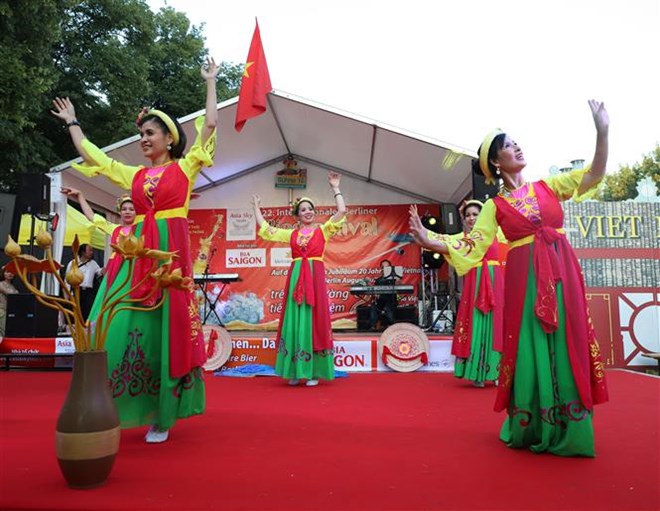 Vietnamese beer have been present at the International Berlin Beer Festival for 18 years. Vietnamese beer and traditional dishes and products have been displayed at the 22nd International Berlin Beer Festival in the German capital on August 3 – 5. It is the 18th year in a row Vietnam has set up a pavilion in the “longest beer garden in the world” recognised by the Guinness World Records. The 2.2-km garden stretches along the Karl Marx Allee, the largest boulevard in Berlin, offering about 2,400 beers from 350 breweries from all over the globe. This year, Vietnam brings to the festival two of the country’s popular brands, Saigon and Truc Bach, alongside the country’s culinary specialties and traditional products like “non la” (Vietnamese conical hat), handheld paper fans and products made from rattan and bamboo. Vietnamese dances and music are also introduced to locals, alongside a show of “ao dai” (Vietnamese traditional gown). Addressing the event’s opening ceremony on August 3, Nguyen Xuan Hung, Director of Asia Sky Tours who runs the Vietnamese pavilion, said he is proud that Vietnam’s beer culture has been present for 18 years at the International Berlin Beer Festival. It is not only a great opportunity to introduce Vietnam’s beer products but also its landscapes, culture and people to foreign visitors, he noted. Eberhard Schollmeier, nicknamed King Gambrinus (the King of Beer), spoke highly of the enthusiasm and continuous presence of Vietnam in the festival. “Vietnam has taken part in the International Berlin Beer Festival for 18 consecutive years during 22 years we hosted the event. It is truly a festive day and Vietnamese have found here a corner of their homeland.” The three-day festival is expected to welcome more than 1 million visitors. Like the world’s largest beer festival Oktoberfest annually held from late September to early October in Munich, Germany, the International Berlin Beer Festival is a big event in the European country to promote the beer industry. Last year, Hanoi and Saigon beers were promoted at the event. Hanoi police prosecute two men for illegal drug trafficking 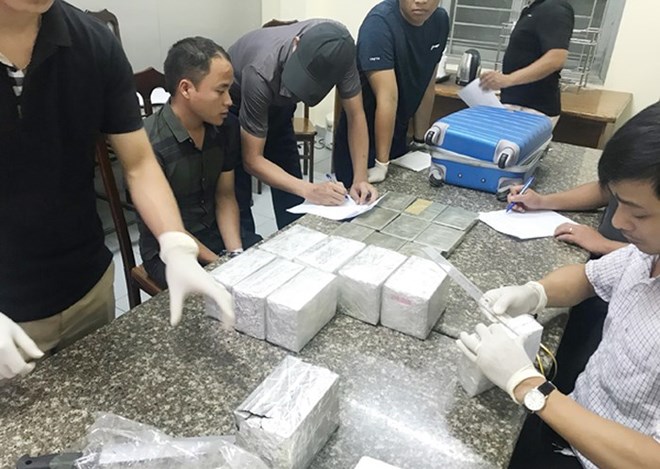 Lau A Chu and Lau A Chia were arrested while attempting to transport 40 bricks of heroin. The Investigation Police Agency of Hanoi’s Dong Da district on August 3 decided to prosecute and issue temporary detention warrants for two men residing in the northern border province of Dien Bien for illegal drug trafficking. Lau A Chu, born in 1995, and Lau A Chia, born in 1999, residing in Dien Bien Dong district were arrested at Ho Tung Mau-Pham Hung crossroad on June 8 while attempting to transport 40 bricks of heroin weighing 14 kilogrammes in total. Initial investigations showed that Chu and Chia are dealers in a drug trafficking ring, which transported the drugs from Dien Bien province to Hanoi, then continue distributing them to Thai Nguyen, Cao Bang and Bac Kan provinces for consumption. Chu said that they would be paid 200 million VND (8,800 USD) if successfully transporting the drugs to Hanoi. On August 3, Hai Phong police busted a large drug trafficking ring, and seized over one kilogrammes of drugs of various kinds. Tran Thi Kim Ung (born in 1987, and residing in An Duong village, An Dong commune, An Duong district), and her husband Hoang Van Kien (born in 1989, residing in Van Tra village, An Dong commune, An Duong district), were arrested for drug possession and trading. The police seized 1.8 kilogrammes of drugs, two mobile phones, 2.2 million VND, and many other exhibits. Earlier, Ung was sentenced to 18 years of imprisonment for her illegal drug possession and trading. However, the execution of the sentence was postponed as her child was under 36 months old. Summer camp for Vietnamese, Lao, and Cambodian kids wraps up  Children from Vietnam, Laos and Cambodia join together in an exchange programme which features traditional culture and arts of the three nations A five-day summer camp in Ho Chi Minh City for children from Vietnam, Laos and Cambodia closed on August 4, spotlighting the solidarity of the three countries’ kids. Suphalak Xayyalath from Lao said he was very impressed with destinations he visited in HCM City, especially the historical site of Cu Chi Tunnels. Meanwhile, Chen Sovansakha from Cambodia said the event offered a good chance for him to know more things, adding that he made many friends during this event. Vietnamese delegate Nguyen Ngoc Hong Giang said she learnt much from Lao and Cambodian friends. The programme, the fifth of its kind, was hosted by the city’s Ho Chi Minh Communist Youth Union. According to head of the organising board Phan Thi Thanh Phuong, the event aimed to promote exchange and deepen solidarity among children of the three countries. The event saw the participation of 57 youths from Cambodian localities, namely Phnom Penh, Battanmbang, Kampot, Svay Rieng, and Kratie; and 54 from the Lao provinces of Vientiane, Champasak, and Attapeu. Meanwhile, 135 Vietnamese delegates from HCM City and border provinces such as Kon Tum, Binh Phuoc, Tay Ninh, Long An, and Kien Giang joined in the programme. During the programme, young delegates offered incense and flowers to President Ho Chi Minh at the municipal Children’s House. They also visited the city’s famous destinations, including the Ho Chi Minh Museum, the Cu Chi Tunnels, the Artinus 3D Art Museum, and the river bus route. In addition, they also joined together in an exchange programme which featured traditional culture and arts of the three nations; and met with leaders of HCM City. Photographers show love for Truong Sa via exhibition  "The Eye of the Sea" by Nguyen My Tra The last time photographer Tran Thi Thu Dong returned home after a trip to Truong Sa (Spratly) archipelago she felt something very different from other assignments, so the vice chairwoman of the Department of Fine Arts, Photography and Exhibitions decided to organise a photo exhibition. With the help of 12 photographers, the exhibition has come to fruition and opened in the capital city of Hanoi on August 3. The 120 photos on show express a love for the Spratly archipelago and respect for the people and soldiers who live and protect the islands as well as the national sovereignty. “I believe that the Spratly archipelago is a holy place that people hold a deep love for in their hearts," she said. “I want to connect and spread the love. Loving the Spratly doesn’t mean that you have to visit the islands.” “When you love the Spratly, you just need help other people understand more about the archipelago and the people and soldiers who protect it day and night,” said Dong. The photographers participating in the exhibition include Vu Quoc Khanh, Chairman of the Vietnam Association for Photographic Artists, photographer Le Nguyen from the southernmost province of Ca Mau, Thach Cong Thinh from the northern mountainous province of Ha Giang, Le Quang Dung from the central province of Nghe An and Nguyen My Tra from Radio the Voice of Vietnam. The exhibition will run until August 7 at the Exhibition House, 93 Dinh Tien Hoang Street, Hanoi. Vietnamese expats stabilise lives after fire in Cambodia  A fire burnt 57 houses of Vietnamese expats to ground. The support from Vietnamese and Cambodian authorities, and international organisations have helped Vietnamese expatriates in Phnom Penh, Cambodia, overcome difficulties after a fire burnt their houses to the ground last month. Attending a ceremony jointly held by the Vietnamese Embassy in Cambodia and Khmer-Vietnamese Association on August 4 to review relief activities for fire victims, Vietnamese Ambassador to Cambodia Vu Quang Minh expressed his gratitude towards Cambodian leaders and authorities for giving timely assistance to the Vietnamese expatriates. This was a successful relief campaign, he said, adding that it set a record in terms of speed, donated money and items, and the number of sponsors. Also, he took the occasion to thank Vietnam’s resident reporters in Cambodia for spreading updated news about the incident. At the event, the organising board handed over assistance from the Vietnam Fatherland Front Central Committee to the victims, with 20 million VND (870 USD) offered to each family. A fire broke out at dawn of July 10 and quickly ripped through 57 Vietnamese households in Ruseykeo district, Phnom Penh. The cause of the fire was identified as an electrical short-circuit in a house owned by Sin Yin, a 63 year-old Vietnamese Cambodian. The fire spread to other houses in the neighbourhood due to their combustible building materials, requiring 32 firefighting vehicles to extinguish the blaze. New look has been given to the devastated area just after four weeks as new houses have been built on the former ground with more stable building materials. However, the impoverished Vietnamese there still have to encounter other tough challenge when the water level of Mekong River is rising as the result of the collapse of the Sepien-Senamnoi hydropower dam in Laos. Photos on Hanoi’s suburban life on display  A photo on display by Truong The Cau (Source: hanoimoi.com.vn) As many as 139 photos depicting the suburban life in Hanoi are being displayed at an exhibition which opened at 45 Trang Tien Street, downtown the capital city on August 3. The exhibited photos are the winning works of the 48th fine art photography contest held to celebrate this year’s August Revolution (August 19), National Day (September 2), the 64th anniversary of Hanoi’s Liberation Day (October 10) and 10th years of the capital’s boundary expansion. According to Dao Quang Minh, Vice President of the Hanoi Association of Photographic Artist and head of the contest’s jury, some 1,750 entries have been sent to the organizers from 293 photographers since the competition was launched 2 months ago. Most of the works captured people’s life in four districts on the outskirts of Hanoi – Dan Phuong, Thanh Tri, Hoai Duc and Dong Anh which has been recognised as new-style rural districts. Speaking at the exhibition’s opening ceremony, Deputy Secretary of the municipal Party Committee Ngo Thi Thanh Hang said a decade after Hanoi’s boundary expansion, the capital has seen remarkable progress with achievements recorded in multiple fields, including politics, economy, society, and culture. The city’s rural areas have also experienced significant changes, helping Hanoi lead the country in the new-style rural area building with 76.2 percent of communes and four districts gaining the status, she noted. The exhibition is expected to help promote efforts by the administration and people of Hanoi over the past decade and motivate the better construction of the city. The event will run through August 7. VNN |
↧
Article 0
Forbes announces top 40 valuable brands in VietnamHanoi -Forbes Vietnam has recently released its third annual list of the 40 most valuable brands in Vietnam in 2018, estimating their total value at 8.1 billion USD, an increase of 30 percent compared to the 2017 list.  Vinamilk continues topping the list of 40 most valuable brands in Vietnam in 2018 (Source: sggpnews.org.vn) Dairy giant Vinamilk maintains its top position in the list, with an estimated brand value of 2.28 billion USD, much higher than the 1.7 billion USD last year. The company is followed by military-run telecom firm Viettel with 1.39 billion USD. State-owned Vietnam Posts and Telecommunications Group (VNPT) takes over third position from Vingroup, Vietnam's largest real estate company. With a value of 416 million USD, VNPT names itself in the list for the first time. The other brands in the top ten are the country’s biggest brewery Sabeco (393 million USD), Vinhomes, the residential property arm of Vingroup (384 million USD), Vinaphone, one of Vietnam’s big three mobile operators and belonging to VNPT (308 million USD), Vingroup (307.2 million USD), food and beverage producer Masan Consumer (238 million USD), Vietcombank (177.9 USD), and tech giant FPT (169 million USD). Vinhomes and Vinaphone are also newcomers in the list. Forbes compiled the list by looking at brands' incomes before and after tax based on their financial reports and data on the stock market. VNA |
↧
Article 2
Government News 7/8 HCM City Party leader urges higher status in economy for agriculture 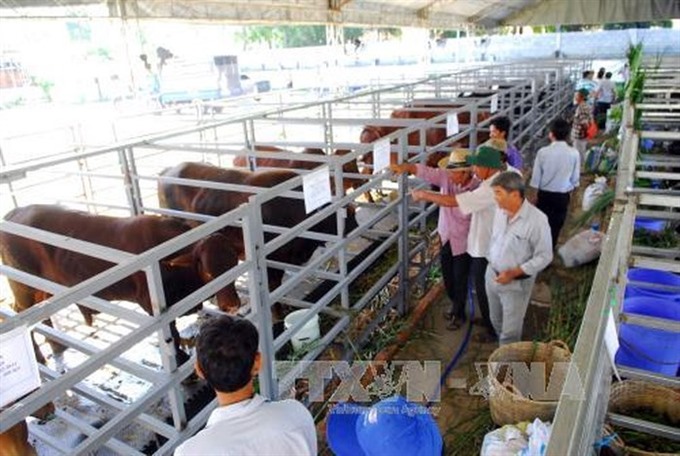 Modern farming co-operatives are needed to achieve a breakthrough in restructuring agriculture in HCM City and raising the incomes of farmers. HCM City Party Committee Secretary Nguyễn Thiện Nhân has called on city authorities to make agriculture one of the city’s seven key economic pillars. Speaking at a conference on developing modern co-operatives to help restructure agriculture and raise farmers’ incomes, he said currently agriculture did not enjoy that status though it was one of the city’s focuses. "Việt Nam is one of the largest agricultural produce exporting countries in the world, but faces problems such as bumper crops and resultant price drops, leading to lower incomes for farmers," he said. According to Nhân, this is because agriculture in the country is often not compatible with the market economy and international integration. Besides, farmers frequently face financial shortages though the Government has many preferential policies for them. Most farmers’ land holdings are small, making agriculture inefficient, especially because 97 per cent of farm workers are untrained. Modern farming co-operatives are needed to achieve a breakthrough in restructuring agriculture and raising the incomes of farmers. Nguyễn Thị Bạch Mai, chairwoman of the city Farmers Association, said the association had encouraged farmers to join co-operatives since 2013. The city has 75 agricultural co-operatives, and the average income of their members is VNĐ40-50 million (US$1,713-2,141) a year. According to a survey by the city Department of Agriculture and Rural Development, nearly 20 per cent of farmers have tied up with enterprises and 15 per cent have joined co-operatives. Farmers joining co-operatives earn 10-35 per cent more than individuals. But Mai said most co-operatives faced difficulties related to land, warehouses, finance, working facilities and leadership. Trần Văn Chánh, director of the Phú Lộc Co-operative in Củ Chi District, suggested that city authorities should allow co-operatives to build warehouses on agricultural lands. Moreover, they should subsidise co-operatives’efforts to indicate the origins of their produce in their packaging, products. According to other delegates at the conference, the co-operatives should develop their services in terms of quality and availability. They should embrace the market, co-operate with each other and with enterprises for creating new strains and breeds and selling to value chains. National conference seeks ways to protect children from violence, abuse 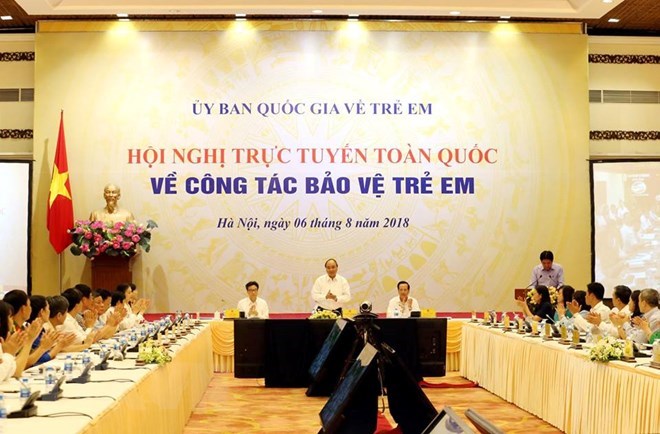 Prime Minister Nguyen Xuan Phuc addresses the conference Prime Minister Nguyen Xuan Phuc chaired a national online conference on August 6 on the protection of children against violence, abuse and risks to their health and life. The conference, connected with 675 districts and communes across the nation, drew about 18,000 delegates. A report by the Ministry of Labour, Invalids and Social Affairs (MOLISA) showed that every year, about 2,000 cases of children falling victims to violence and abuse were reported and handled by functional agencies, with over 60 percent involving sexual abuse. However, the figure is only the tip of the iceberg, as only cases serious enough to be subject to criminal investigation were reported. In the first five months of 2018, 682 violations against children were reported. Particularly, as many as 21.3 percent of sexually abused children were victims of their family members, 59.9 percent were attacked by neighbours and relatives, and only 12.6 percent by strangers. Deputy PM Vu Duc Dam held that the figure reported by the MOLISA does not reflect the reality. He said the unreported cases are much higher, as many harassing behaviours are still thought to be “normal” in society. Participants at the conference gave their evaluation on violence and abuse against children, analysed the reason behind the problem and recommended solutions to it. Many pointed to the need for closer coordination among ministries, sectors, social organisations and local community, as well as the formation of preventive and settlement mechanisms for violation cases. Addressing the event, PM Phuc said that violence, especially sexual abuse against children is unacceptable and intolerable both legally and morally. He also mentioned other threats to children’s health and life, such as drowning and traffic accidents, which claim the life of thousands of children each year. The Government leader stressed that it is a strategic and major task for the sustainable development of the country and the responsibility of the whole political system, localities and each family to care for and protect children as well as creating a healthy and favourable living environment for them. He agreed with orientations and solutions stated in the MOLISA’s report to fight child abuse. In order to mobilise resources of the whole political system for the enforcement of children’s rights, especially the rights to protection and safety, Party organisations, the government, specialised agencies and social organisations, especially at local level, should be fully and thoroughly aware of the significance of child protection, he stated. He stressed the vitality of strict and full implementation of laws and policies related to the protection of children from violence and abuse, thus make sure children are safe. “The training and providing of legal knowledge to the entire society on the caring, protection and support to children is crucial,” said the PM. He asked the heads of People’s Committees at communes to appoint officials in charge of children protection, as so far, only 590 out of the total 11,162 communes, or about 5 percent, have appointed such a position. The PM also required that research be conducted on the organisation and operation of a specialised team for children protection to be led by the Chair of the communal People’s Committee, while localities must pay more attention to enhancing the law enforcement capacity and skills for officials charged with children protection work and allocate sufficient resource for the work. The Ministry of Education and Training was asked to design programmes to train children in protecting themselves, while National Assembly agencies, deputies and People’s Councils should tighten supervision of the enforcement of law and policies related to children protection as well as the allocation of resources for the work. He also called on the whole society, from all-level administrations, socio-political organisations, mass organisations to communities and families to engage in preventing and fighting violence and abuse targeting children, and in creating a safe environment for children. On the occasion, the PM also requested the MOLISA to coordinate with other relevant agencies to promptly submit a proposal on mobilizing social resources for the caring of children from ethnic minority groups and mountainous regions. The PM asked the Vietnam Fatherland Front’s Central Committee to launch a campaign to support this group of children on the occasion of the Day for the Poor of Vietnam on October 17, 2018. Preparations for World Economic Forum on ASEAN quickened 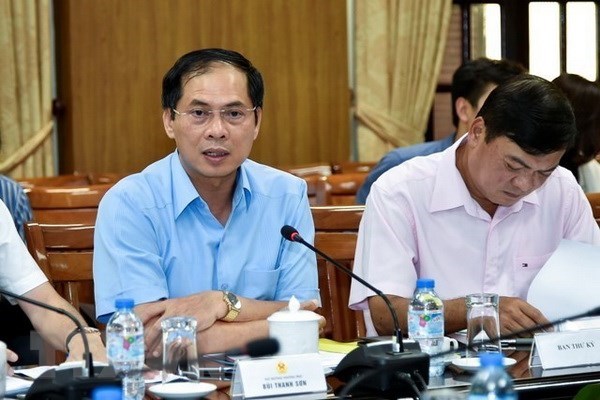 Permanent Deputy Minister of Foreign Affairs Bui Thanh Son The organising committee for the World Economic Forum on ASEAN (WEF ASEAN) convened its fourth meeting in Hanoi on August 6 to review the preparation for the event scheduled for September 11-13. Permanent Deputy Minister of Foreign Affairs Bui Thanh Son, head of the committee, said the forum is one of the country’s important external activities in 2018. So far, leaders of most ASEAN countries and extra-bloc nations as well as representatives from major international organisations and global leading groups have affirmed to participate in the event, he revealed. He urged the sub-committees to double efforts to complete the preparation of the forum in August to ensure its comprehensive success. The official asked members of the organising committee, including representatives from Hanoi, Ho Chi Minh City, Da Nang and Quang Ninh, to obtain this opportunity to promote their localities’ development potential in the fields of its strength while proactively boosting cooperation with countries and leading groups in the world to expand markets and draw investment. The WEF ASEAN 2018 focuses on the theme “ASEAN 4.0: Entrepreneurship and the Fourth Industrial Revolution.” The event will address strategic issues of national and regional significance under three thematic pillars – Entrepreneurship to craft new approaches to regional and global governance; Entrepreneurship to drive economic and business dynamism; and Entrepreneurship to shape social inclusion. It is expected to draw 800 – 1,000 delegates. The forum will covers 60 sessions, including sideline activities such as a forum on innovative start-up, a festival on Vietnamese culture, a business summit, and a fact-finding tour to Ha Long Bay in the northeastern province of Quang Ninh. Vice President presents gifts to disadvantaged families, children 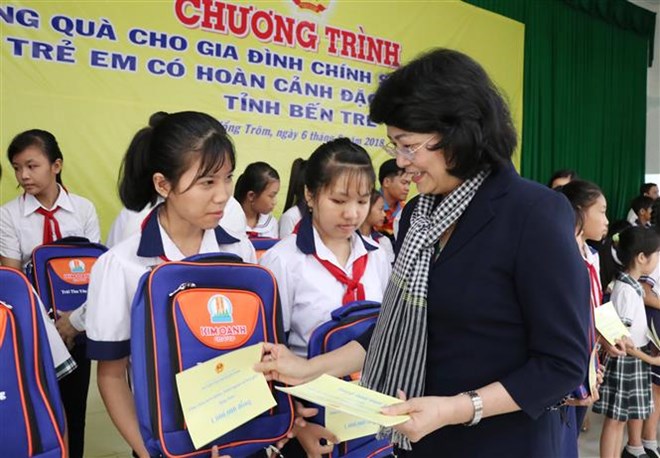 Vice President Dang Thi Ngoc Thinh on August 6 presents gifts of the National Fund for Vietnamese Children to disadvantaged families and children in the Mekong Delta province of Ben Tre. Vice President Dang Thi Ngoc Thinh on August 6 presented gifts of the National Fund for Vietnamese Children (NFVC) to policy beneficiaries, families of Agent Orange/Dioxin victims and poor children in the Mekong Delta province of Ben Tre. A total of 50 gift packages were presented to policy beneficiaries and AO/Dioxin-affected families with difficult background in Giong Trom district while 200 poor children in Ba Tri and Giong Trom districts received gifts and school aids. In addition, Thinh, who is also Chairwoman of the NFVC’s Council, mobilized sponsors to donate 54,000 glasses of milk to local children and 50 million VND to the provincial Association of Victims of AO/Dioxin. The vice president said despite Giong Trom’s efforts in building new-style rural areas and improving social welfare and living standards of local people, the district’s poverty rate remains relatively high with a small proportion of local households given access to clean water. Thinh expected that in the time ahead, Ben Tre province and Giong Trom district in particular will strive harder to foster social-economic development and promote new-style rural building. She also wants the local authorities to pay more attention to the poor and policy beneficiaries to reduce the province’s poverty rate. She looks forwards to Giong Trom soon earning the new-style rural status. The leader also sent her wishes to the district’s children, hoping that they will achieve better academic results and the gifts will motivate them study harder. Giong Trom covers a total area of over 31,000 hectares, more than 80 percent of which is agricultural land. The district has a population of more than 168,700 people and is home to nearly 6,900 martyrs, about 3,500 wounded soldiers, more than 1,480 Heroic Vietnamese Mothers and 313 veterans affected by AO/Dioxin. It has a total number of over 7,400 poor and near-poor households, accounting for 14.35 percent of the population. ASEAN members meet on immigration issues 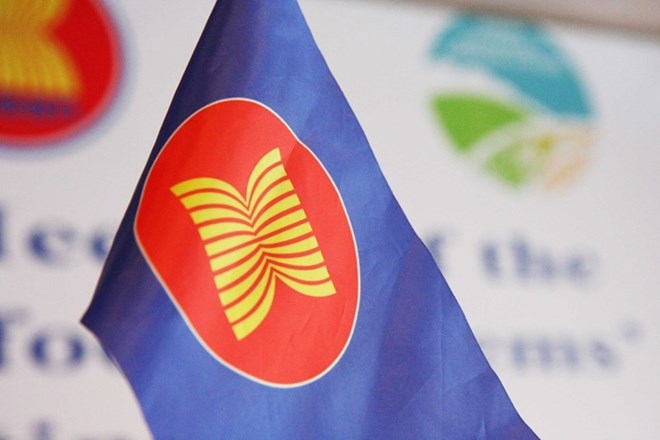 ASEAN Directors-General of Immigration Departments and Heads of Consular Affairs Divisions of the Ministries of Foreign Affairs (DGICM) convened their 22nd meeting in Kuala Lumpur, Malaysia, on August 6. About 100 senior immigration officers from 10 ASEAN member countries are joining the DGICM meeting, themed ‘Sovereignty and Security is Our Mission’. The four-day event aims at discussing solutions to immigration issues in the region and in border management. Ahead of the meeting, Director-General of the Malaysian Immigration Department Mustafar Ali told Bernama news agency that ASEAN member countries can learn from Australia’s experience on addressing immigration issues in the region. He noted that there would be a session for Australia, a strategic partner of ASEAN, to share its experiences on capacity building in the field during the DGICM meeting. He said Australia has advanced technologies in the field as well as in training and capacity building, which he hoped the country would share them with ASEAN. In addition to Australia, countries like Singapore, Indonesia, Thailand, and the Philippines were also welcomed to share views on modern immigration management technology as well as their experiences in addressing human trafficking, the official said. Mustafar said ASEAN member states need more bilateral and multilateral cooperation in tackling immigration issues like the way the existing network of the Association of Southeast Asian Nations Police (ASEANAPOL) is doing in combating trans-border crimes. VNN |
↧
Article 1
Challenges facing Việt Nam in ensuring energy securityHÀ NỘI - Việt Nam needs an enormous amount of energy to feed its development, but relying on coal and hydropower is not the answer, and with new measures still at an early stage, experts are concerned about the future.
Wind turbines of Đầm Nại power project in Ninh Hải and Thuận Bắc districts in the south-central province of Ninh Thuận, slated to enter commercial production in the final quarter of 2018. — VNA/VNS Photo Nguyễn Thành Việt Nam’s demand for energy rises by an average 9.5 per cent year-on-year in the last 15 years, reaching 13 per cent increase in 2006-11 and 11 per cent in 2011-16 period. According to Việt Nam Energy Outlook 2017 report released last September, imported energy could account for 37.5 per cent of its total supplies in 2025 and more than half (58.5 per cent) in 2035. Vietnamese economy has transformed itself from an agrarian economy which relied primarily on traditional biomass fuels, to a modern mixed economy, one of the fastest growing ones in the world, resulting in rapid changes in the energy sector. According to the Electricity and Renewable Energy Department under the Ministry of Industry and Trade (MoIT), oil, coal, natural gas, hydropower and non-commercial biomass (woods, agricultural waste) are the main primary domestic energy sources. In recent years, the total output of these forms of energy doesn’t witness any substantial change, the department said. Nguyễn Văn Thành, deputy head of the department, said after more than 10 years of implementing Việt Nam National Energy Development Strategy 2020, “in general, the energy sector has seen positive results, evidence in the achievement of several targets,” especially ones dealing with electricity access in rural areas or meeting socio-economic energy demands. According to the department’s report, total electricity production and purchase of the State-owned Electricity Việt Nam (EVN) reached 192.45 billion kWh, up 8.6 per cent compared to the previous year; the national power sales achieved 174.05 billion kWh, an increase of 8.92 per cent. Việt Nam scored 78.69/100 points in the Getting Electricity indicator (part of Word Bank’s Doing Business index) and ranked 64th out of 190 nations and economies, moving up 32 places against 2016. Installed generating capacity of Việt Nam in 2015, for example, reached 39,350MW, up 1.8 times compared to five years before, and ranking second in ASEAN countries. However, the energy sector failed to meet set targets on oil refinement and oil reserves, nuclear energy, or connecting its electrical lines and natural gas supply lines with other countries in Southeast Asia. The Government originally aimed to refine 30-35 million tonnes of oil a year by 2020, but going on the current rate, realistically, it will only meet half its goal (16.5 million tonnes) in two years’ time. Việt Nam still doesn’t have its own oil reserves, and can currently only hold 30 days’ worth of oil for commercial purposes while the goal is to maintain stable storage worth 45 days of usage in 2010, and 60 days of usage in 2020, in a bid to offset price volatility. One of the energy sector’s strategic power connectivity plans is to link with regional countries’ power grids on the 500kV transmission lines, but so far, Việt Nam is only capable of purchasing/selling contracts with China or Laos on the 220kV lines. A natural gas linkage with regional countries, similarly, remains a pipe dream. Reliance on imports According to Trần Văn Tùng, deputy minister of science and technology, the country’s energy sector is facing ‘layered challenges.’ On one hand, the sector needs to produce as much energy as possible to meet the demands of socio-economic development, on the other hand, it needs to honour international commitments on sustainable development and reduces reliance on fossil energy, which is already nearing its limits. “In the context of rising demands, near maximum exploitation of hydropower resources, and the venture into nuclear energy halted indefinitely, Việt Nam has been importing primary energy sources to produce electricity,” Tùng said. "The increase of the ratio of imported energy in the total primary energy output will have worrying implications for the country’s energy security," he said. Regarding electricity supply, until 2020, the country would not have much to worry about, said Nguyễn Văn Vy, vice chairman of Việt Nam Energy Association (VEA). However after 2020, the prospect of electricity shortage would become more and more visible, which could be blamed on delayed schedule of several key power projects, such as the Thái Bình II thermopower plant project by the State-owned oil and gas group PetroVietnam and other Build-Operate-Transfer (BOT) projects in the southern region. Renewable energy Experts maintained the only viable way forward for Việt Nam is to focus on renewable energy to secure its future. “What we need right now is mechanisms to stimulate renewable energy projects. Việt Nam won’t have to be concerned about electricity paucity, provided sufficient attention and resources are poured into renewable energy, especially solar energy, given how a project can start from conception to operation within a year if the paperwork is handled quickly,” Vy told Hải Quan Cuối Tuần (Customs, Weekend Edition) newspaper. Deputy minister Tùng also agreed that "this is the time Việt Nam needs to make a breakthrough and master the new energy forms". “It’s entirely possible if the authorities, businesses and scientists all work together, and with the technical expertise support from developed countries and international energy associations,” Tùng added. Dr Nguyễn Thế Mịch, consultant for the German Agency for International Co-operation or (GIZ), is steadfast in his belief that with its abundant renewable energy potentials, Việt Nam can even become a net energy exporter by 2050. However, with the current progress on solar and wind energy development in Việt Nam, Mịch is not convinced the country will be able to achieve 6.5 per cent of renewable energy in the total supplies by 2020. Installed capacity of wind energy is now 200 MW, with several new projects slated to be completed later this year, but even so, the capacity reaches just 360-400MW. To fulfill the Government’s target of 800MW by 2020, another 400MW is needed in two years’ time. “A wind energy project requires several procedures, calculating wind potentials in at least 365 days, data analysis and setting up several databases to see the viability and feasibility of the project. This puts the prospect of attaining 800MW in wind energy by 2020 at risks,” he said. In addition, wind energy technology is much more complicated than solar energy, and Việt Nam is not the producer of equipment, while the Government’s offered feed-in tariffs (Government’s purchase price) for wind energy stayed at an unattractive 7.8 cent/kWh. “GIZ has proposed the feed-in tariff for onshore wind projects be raised to 8.78 cent/kWh, and 9 cent/kWh for offshore wind projects. This would certainly draw in quality investors,” Mịch said. Phạm Phú Uynh, an energy expert, said the priority must be put on developing renewable energy technologies domestically. “Most renewable energy projects use technologies bought overseas, resulting in higher production prices compared to the traditional energy forms of hydropower or thermopower,” Uynh said. In addition, the seas of Việt Nam face frequent turbulences and typhoons, therefore, “any imported wind energy technology should be customised to our natural conditions first,” he added. Steve Sawyer, Secretary General of Global Wind Energy Council, has also expressed interests in co-operation with the Vietnamese Government in settling legal bottlenecks and promoting transparency in bidding process to make “Việt Nam an attractive destination for international investors.” VNS |
↧
↧
Article 0
Social News 7/8 Eureka scientific research awards kick off 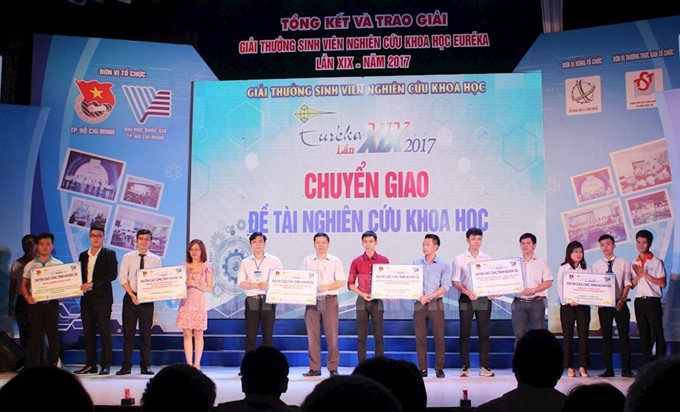 Winners of the 19th annual Eureka Scientific Research Students Awards in 2017. — Photo hcmcpv.org.vn The 20th annual Eureka Scientific Research Students Awards competition is accepting entries from students of universities, colleges and vocational schools nationwide. Contestants can submit entries at the Youth Scientific and Technological Promotion Centre at 1 Phạm Ngọc Thạch Street in District 1, or via email khoahoctre@gmail.com and website www.khoahoctre.com.vn by September 30. The awards will be given in 12 fields, including pharmaceutical chemistry technology, biotechnology and biomedical technology, intelligent technology, food technology, education, economy, engineering, agriculture, forestry and fishery, laws, planning, architecture and construction, natural resources and environment, and social affairs and humanities. The award-winning projects will be announced in November at the HCM City University of Technology and Education. The Eureka Scientific Research Students Awards competition has been organised since 1999 by the HCM City branch of the Communist Youth Union to encourage scientific research among students. To celebrate 20 years of the awards, the organisers plan to host a Eureka Scientific Research Student camp in October in HCM City. The camp is expected to award winners in previous years, along with outstanding students at schools nationwide. Legal framework for child care on the internet 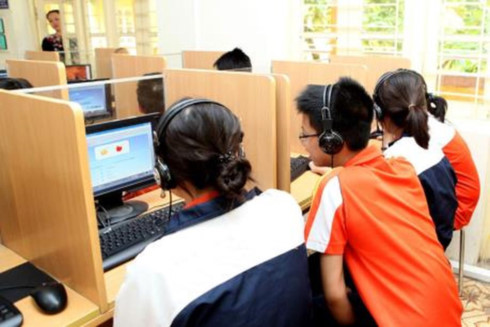 Vietnam, with 64 million Internet users (67% of its population), is among Asian countries having the biggest number of Internet users. A majority of these users are children and teenagers, who are exposed to both benefits and dangers. In addition to close attention from parents and schools, a legal framework is needed to protect children from the risks of the cyber world. While browsing the Internet, children may encounter unexpected information and people. Their personal information can be hacked. More seriously, children can become victims of swindles, exploitation, harassment, and sex abuse. Online game and smartphone addictions can harm children’s mental and physical health. Parents should teach children how to find and use information on the Internet. Dang Hoa Nam, Director of the Department for Children of the Ministry of Labor, Invalids, and Social Affairs, said, “Parents play a very important role. They should be friends to their children and share information with them. We have to admit that parents often lag behind their children in terms of IT. Parents should learn, share, and spend more time with their children.” A legal framework on child protection, particularly personal information, is being finalized. The 2016 Law on Children, and a government decree specifying certain articles in the Law on Children, the Law on Information Safety, and the Law on Cyber Security cover basic regulations of child protection on the Internet. “Circular 9 of the Ministry of Information and Communication issued in 2017 defines duration, time, and warnings on media unsuitable for children. We need to specify administrative punishments and criminal charges for violators of children’s private information on public media and the Internet,” said Mr Nam. The Ministry of Labor, Invalids, and Social Affairs, the Ministry of Information and Communications, and other sectors will work together to build specific laws on child protection. Nghe An: Nearly VND2 billion lost in fishing boat fire 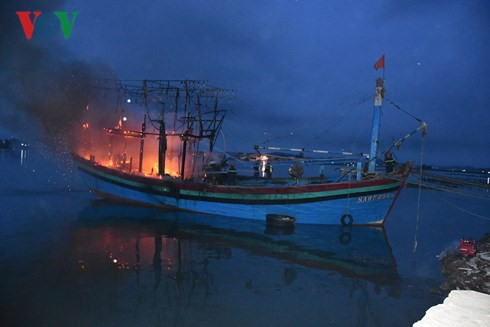 At 10:10 pm on August 5 the fishing boat No. NA 95959 suddenly caught fire while it was anchored in Quynh Lap Commune, Hoang Mai Town, Nghe An Province. When the fire occurred , the boat, owned by Le Van Minh with 7 crew members on board, was preparing to go to sea. The fire sparked from the engine room sent a huge column of thick smoke into the air. A fire engine and 25 firefighters were called in to put out the roaring fire. It took them two hours to get the blaze under control. No casualties were reported. However, the flames suddenly burst forth at 4:30 am on August 6. It took the firefighting force about 40 minutes to stamp out the fire. The loss is estimated at over VND2 billion. HCM City reports 485 work accidents in 7 months 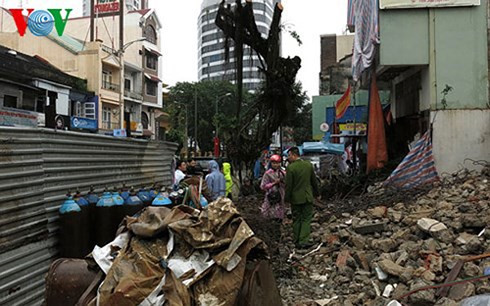 Four hundred and eighty five work accidents took place in Ho Chi Minh City in the first seven months of this year, 223 cases less than the same period last year, according to the municipal Department of Labour, Invalids and Social Affairs. The workplace accidents resulted in 493 casualties (226 cases fewer than in the corresponding period last year), including 30 deaths (down 15 cases compared to the same period last year). Most of the accidents occurred at the industrial production sector such as footwear, apparel and metal processing. Particularly, 21 out of the 30 fatal accidents took place at the construction sector, killing 21 and severely injuring 2 others. The work accidents often happened at civil construction projects, particularly building of private houses by private contractors or small construction companies, who failed to follow the work health and safety regulations. In addition, the workers themselves also violated work regulations and did not use personal protective equipment. Construction of overpass lags behind schedule, causing serious congestion 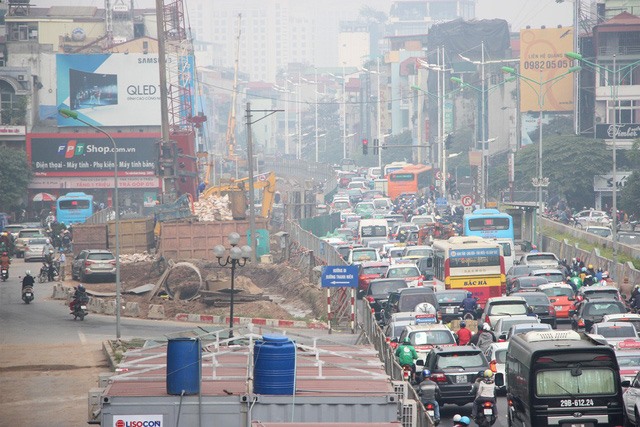 The construction progress of the An Dương-Nghi Tàm overpass is lagged behind schedule, causing serious congestion. — Photo dantri.com.vn The construction of An Dương-Thanh Niên overpass, a key project in Hà Nội, lags behind schedule with many parts incomplete, causing serious traffic congestion for vehicles passing through this route. The construction of the overpass began last October with a total cost of VNĐ311 billion (US$9.3 million). As planned, the overpass will have seven spans that are 30, 45 and 60 metres long depending on the position. It was expected to be complete by July to reduce traffic congestion in Ba Đình and Tây Hồ districts. However, on August 5, many parts of the project remain incomplete, and the first span among the seven is still under construction. Pedestrians have been seen walking on the road as the pavement is full of construction materials. Vehicles have been lining up along Nghi Tàm, moving slowly on the three-metre-wide road. Nguyễn Mạnh Hùng, a resident on Nghi Tàm said that the project has seriously impacted the lives of local residents and the traffic flow along the Yên Phụ - Nghi Tàm route. Trucks were spraying dirt and stones onto homes and polluting the air. The sewage systems were clogged in rainy weather, causing annoyance to residents, he added. Ngô Mạnh Tuấn, deputy director of the city’s Department of Transport told baogiaothong.vn that the department has asked the contractors of the project to speed up the construction progress. It has worked with local police to divide lanes to ensure traffic flow during peak hours. The department would ban all vehicles along Yên Phụ and use other roads to curb traffic congestion. Đặng Hữu Dũng, chief inspector of Tây Hồ District’s Traffic Inspection Team said the team has divided into two groups to guide vehicles to move in different directions to avoid congestion at peak hours. Previously, on July 3, Hà Nội People’s Committee has reprimanded and urged the contractors to complete the overpass, which was one month behind schedule. Chairman of the committee Nguyễn Đức Chung asked the contractors to sign a commitment to complete each part of the project on time. Violations during the construction process will be recorded. Former Russian military experts in Vietnam get together  N. Kolesnik, head of the association of former Russian military experts in Vietnam, speaks at the get-together. Forty-eight Russian military experts, who once worked in Vietnam, gathered at a meeting in Moscow, Russia, on August 5. The gathering, the 48th of its kind, was held by the Vietnam Embassy in Russia in collaboration with the Vietnam military attaché office, the Association of Vietnamese and the Association of Vietnamese War Veterans in Russia. Speaking at the event, Vietnamese Chargé d'Affaires to Russia Nguyen Quynh Mai expressed her delight to join the event and meet the former Russian experts, who helped Vietnamese people during the past struggle against the US. She also read out loud a letter from Vietnamese Ambassador to Russia Ngo Duc Manh to N. Kolesnik, head of the association of former Russian military experts in Vietnam. The letter highlighted the appreciation toward the experts’ support for Vietnamese people in the past and today. It stated the Vietnamese people never forget Russian assistance during the country’s most difficult periods. Vietnamese Military Attaché in Russia Major General Tran Minh Son recalled memories of the fight for national independence and mutual support between Vietnam and the Soviet Union in the past. August 5, 2018 marked the 48th founding anniversary of the association of former Russian military experts in Vietnam. Tens of thousands of Russian experts devoted their youth to help Vietnam regain independence and reunification. In recognition of their great contributions, the Communist Party of Vietnam and the Vietnamese State have conferred many noble orders to the former experts, who continue to work for the Vietnam-Russia friendship at present. Ben Tre’s long-haired army honoured 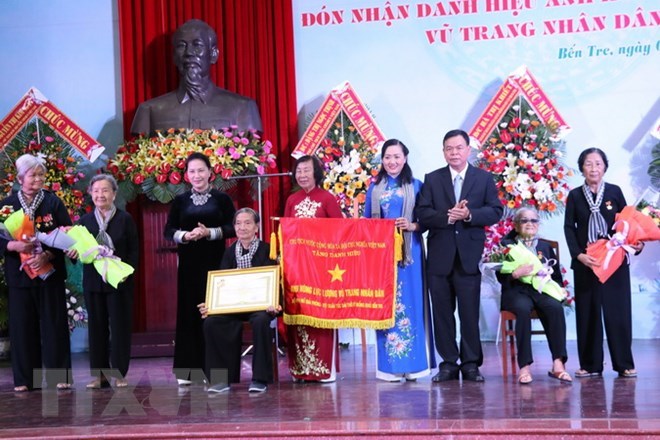 National Assembly Chairwoman Nguyen Thi Kim Ngan (third, left) presents the “Hero of the People’s Armed Forces” title to representatives of the Women’s Liberation Association – Long-Haired Army Southern Ben Tre province on August 6 received the “Hero of the People’s Armed Forces” title for the Women’s Liberation Association – Long-Haired Army, the name of an all-female armed force during the resistance war against the US. The ceremony saw the presence of National Assembly Chairwoman Nguyen Thi Kim Ngan and Vice President Dang Thi Ngoc Thinh. Chairwoman Ngan presented the title to representatives of the Women’s Liberation Association – Long-Haired Army. She also congratulated Ben Tre on 50 years since it was bestowed with the title “Heroic in uprising, winning against the US, defeating the puppet regime.” During the war, Ben Tre was one of the fiercest battlefields, where the US and its puppet regime suppressed and terrorized the revolutionary movement and turned the whole southern region into prisons and concentration camps under the name of “strategic hamlets”. In the face of such an urgent situation, the 15th session of the second Party Central Committee in January 1959 worked out the policy of rising up to seize power for people. The Party organisation and people of Ben Tre realised the session’s resolution in a creative way and waged the resounding General Uprising in 1960. The Long-Haired Army was established and developed in this movement. It was one of the key forces in the guerrilla warfare during the fight against the US. This army initially fought only in the political aspect but then also took part in armed combats. In 1961, the number of female guerrillas in local communes and hamlets surpassed 3,000, accounting for one-ninth of the total female guerrillas across the southern region then. From Ben Tre, the General Uprising spread across the south. The Long-Haired Army also developed in almost all southern provinces, greatly helping to reverse the revolutionary situation from defending and saving forces to attacking the enemy and gaining victories. After the General Uprising, the Party organisation and people of Ben Tre closely coordinated with the revolutionary forces in the southern region to defeat the US’s “Limited War” strategy, with the peak being the victory of the General Offensive and Uprising in the Spring of 1968. With those prominent feats, at the fourth meeting of southern guerrillas, Ben Tre was chosen as one of the three leading provinces in the guerrilla warfare movement. The high command of the liberation army honoured it with the title “Heroic in uprising, winning against the US, defeating the puppet regime.” Hanoi speeds up construction of symbolic flagpole in Ca Mau Cape The Hanoi People’s Committee is speeding up the building of the symbolic capital flagpole in Ca Mau Cape, the southern tip of Vietnam. The authorities expect to complete the construction ahead of the 44th anniversary of the southern liberation and national unification next year (April 30, 1975 - 2019). The flagpole is estimated to cost more than 138 billion VND (5.91 million USD), funded by the capital city of Hanoi and other sources. It mimics the design of the old Hanoi flagpole and is resistant to storms and saltwater intrusion. The multifunctional facility features spaces for exhibition of historical items and for festive performances. To date, the project has seen several sections completed and a number of new sections added to the overall construction. The Ca Mau People’s Committee has asked the main investor to build a 230m road connecting the flagpole with the Ca Mau Cape tourist area and another linking the T1 road and the canoe port. The total cost of the two roads is estimated at over 13.7 billion VND (587,092 USD). The flagpole has a great meaning as it affirms sovereignty and reflects close ties between the capital city and the southernmost province of Ca Mau. Singapore’s experience in building eminent public authorities highlighted 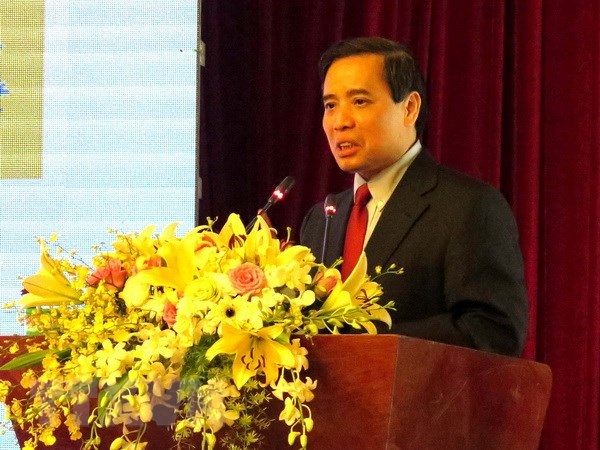 Assoc. Prof. Dr. Vu Minh Khuong Assoc. Prof. Dr. Vu Minh Khuong, a lecturer of Singapore’s Lee Kuan Yew School of Public Policy, spoke of the building of eminent public authorities in Singapore while giving a presentation in Hanoi on August 6, which was broadcast at 73 television sites nationwide. Khuong described the building of eminent public authorities as an urgent and strategic issue to make a country strong and prosperous. Singapore has attracted the best citizens to the Government and seriously looked into issues that need to be addressed, he said, adding that during the process, the country has mobilised external resources and learned from anyone who has knowledge in this field. According to the lecturer, Singapore has clear long-term goals and set targets for each period of time. Leaders play the key role while the Government takes the lead in grasping changes. All citizens take responsibility for national development. Khuong noted that a sound strategy, an eminent Government and public trust and support are decisive factors to national development. During his presentation, Khuong also talked about the building of eminent public authorities in Vietnam. The event was organised by the Organisation Commission of the Party Central Committee and the steering board of Project 165 on overseas training for leaders and managers using State budget. Mai Van Chinh, deputy head of the Organisation Commission and the steering board, said the talk aims to introduce Singapore’s experience in administrative reform and public authority organisation to serve the building of a streamline and effective political system. Separate lanes opened to fix long queue in Lao Bao – Dansavanh border gate 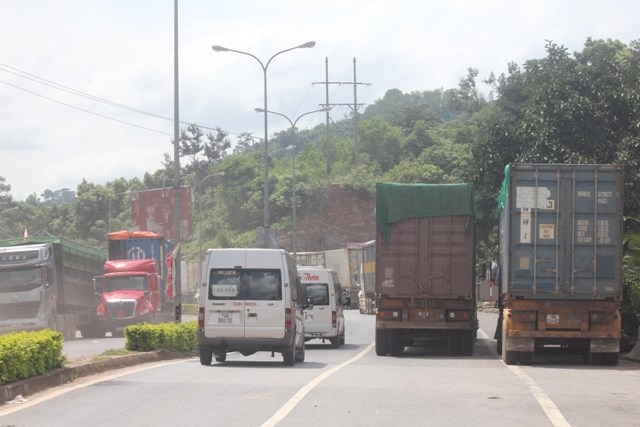 Long queues of vehicles are reported to have wait for customs clearance at the Lao Bao - Dansavanh border crossing in Quang Tri province for days. (Photo: danviet.vn) Separate lanes have been opened for vehicles travelling through Lao Bao – Dansavanh border crossing that connects the central province of Quang Tri and Laos’ Savannakhet province as long queues of vehicles have remained there for days. The border gate management centre under the Quang Tri economic zone management board on August 6 reported the provincial People’s Committee on resolving the long queues of trucks transporting goods from Vietnam to Laos and vice versa. Tropical storm Son Tinh has caused heavy rainfall and flooding in Laos, making the road connecting Vietnam and Laos through Cha Lo (Quang Binh) - Na Phao (Khammouane) border gate submerged. Vehicles had to re-route to reach Laos via the Lao Bao – Dansavanh border gate, resulting in long queues of trucks waiting for customs clearance. Since July 28, the border gate has seen a surge in the number of trucks passing through which were 1.5 – 2 times higher than normal and even reached 300 – 350 vehicles in some days. Most of the vehicles were container trucks carrying fruits, electronic goods and pulp from Laos to Vietnam; and woodchips from Vietnam to Laos. To ease the jam, the authority has decided to open two separate lanes for vehicles from Vietnam to Laos with one exclusively for those transporting woodchips. While for those from Laos to Vietnam, three lanes have been set up with one exclusively for trucks carrying fruits and farm produce. Vehicles which had arrived in the border gate but are not eligible for customs clearance have been directed to park in other areas near the gate. At the same time, competent Vietnamese and Lao forces have coordinated in strengthening surveillance so as to ensure security and traffic safety at the border gate. VFF’s role in fighting corruption, wastefulness discussed  Delegates at the event The Standing Board of the Vietnam Fatherland Front (VFF) Central Committee held a seminar in Ho Chi Minh City on August 6 to discuss its involvement in the fight against corruption and wastefulness. In his opening speech, President of the VFF Central Committee Tran Thanh Man said over the past years, the VFF chapters at all levels have improved the capacity of giving feedback on social issues, contributing to fine-tuning mechanisms and laws on corruption prevention and control. They actively joined supervision schemes, focusing on sensitive issues and urged authorities to deal with complaints and denunciations. The VFF has built a mechanism and launched a process on receiving and handling letters of complaint regarding corruption, wastefulness, political and moral degradation, “self-evolution” and “self-transformation” behaviors among Party members and officials. Secretary of the HCM City Party Committee Nguyen Thien Nhan said corruption and wastefulness acts are found via meetings with constituents, VFF chapters, People’s Councils, the media, letters of complaint and denunciation. In late 2017, the municipal Party Committee issued Regulation 1374 on handling information regarding corruption and degradation, which will be periodically reported to Party committees, he said. In order to improve the efficiency of the fight against corruption and wastefulness, Nhan suggested that VFF chapters of 63 cities and provinces should introduce at least one relevant case which has been successfully dealt with, which will be collected and featured in a printed book, thereby raising public awareness of the VFF’s role in the field. Participants underscored the importance of mass organisations’ supervision role, especially the VFF’s role in representing and protecting legitimate rights and interests of the people, democracy and social feedback. To Thi Bich Chau, Chairwoman of HCM City’s Vietnam Fatherland Front Committee, said local VFF units hold exchanges and dialogues with the people and collect public opinions via mailboxes and social public opinion groups. Later, they work with the municipal Party Committee’s Commission for Internal Affairs and Inspection Commission to deal with information provided by the public regarding corruption, political and moral degradation, and violations of the Party regulations and State laws. Delegates discussed ways to rally public involvement in the fight and suggested ideas to refine anti-corruption policies and laws. Hung Yen province to tighten environmental control 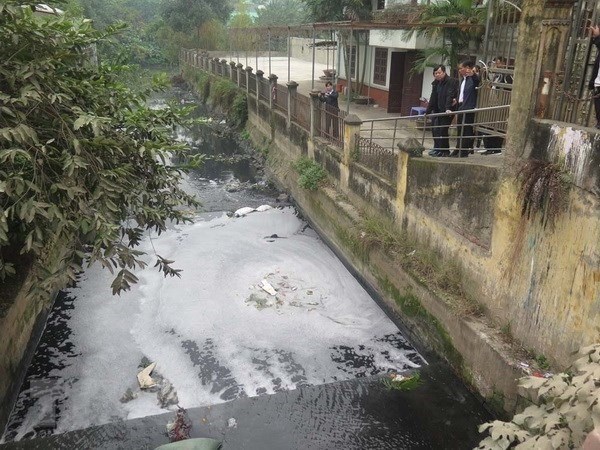 Wastewater from some firms has contaminated Hung Yen’s river and canal systems. The Red River Delta province of Hung Yen has raised the alarm over environmental pollution as many local companies continue to discharge untreated wastewater despite strict punishments by authorities. After 42 investigations conducted in the first seven months of 2018, the provincial Department of Natural Resources and Environment has detected many companies discharging wastewater with residual substances exceeding regulatory standards. Although authorities imposed harsh sentences, those companies deliberately committed and repeated violations several times. According to Tran Dang Anh, Deputy Director of the provincial Department of Natural Resources and Environment, 26 companies have been found violating regulations on environmental protection. AOCC Vietnam Company and Thuan Phat Packaging Company, for example, were fined more than 400 million VND (17,200 USD) each for illegal waste disposal. Wastewater samples collected from the sewage discharged by these companies show excessive levels of pollutants including NH4 , Coliform and BOD5. Phu Sy Nutrition in An Thi district discharged untreated wastewater ten times with levels of Coliform bacteria 80 times higher than regulated. The wastewater contaminates the province’s river and canal systems, especially the Bac Hung Hai irrigation across districts of Van Lam, My Hao, Van Giang and Yen My. Vast areas of agricultural land in those districts have also been abandoned for a long time as no plants or animals can survive the pollution. The provincial People’s Committee has tasked the Department of Natural Resources and Environment to collaborate with related agencies to tighten management on companies violating regulations of environmental protection and suspend the operations of companies which commit violations more than once. The lead recycling village of Dong Mai and plastic recycling village of Minh Khai in Van Lam district are also put under control in an effort to restore the environment. Key housing projects completed to meet growing demands 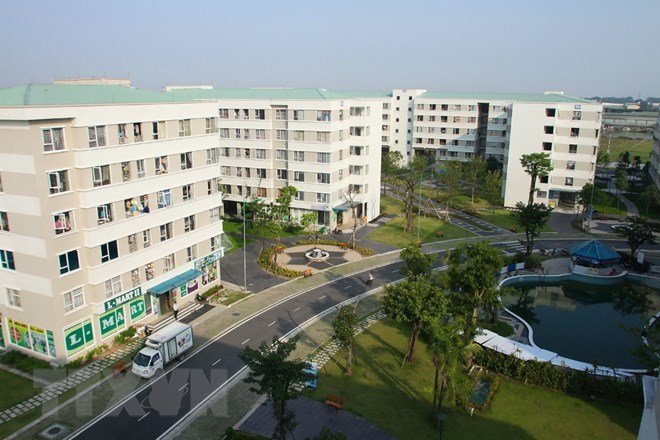 An array of key housing projects have been completed in the first months of 2018 to meet increasing demands of policy beneficiaries, poor households and low-income earners, according to the Ministry of Construction. Some 14,420 households who rendered services to the nation have benefited from the housing support programme. Meanwhile, more than 70,216 families out of 268,000 poor households in rural areas have received housing support, accounting for 26.2 percent of the yearly plan. The Ministry of Construction has joined hands with the Vietnam Fatherland Front Central Committee, and the Central Committee of the Ho Chi Minh Communist Youth Union to accelerate and enhance the efficiency of the programme. Regarding the storm-resistant house scheme in the central region, some 565 billion VND (24.29 million USD) has been splashed out to build shelters for 14,000 out of 23,525 poor families. To date, the coastal provinces of Nghe An, Khanh Hoa, Phu Yen, and Ninh Thuan, and Da Nang city have been accomplished the storm-proof housing programme. The Prime Minister has allowed the programme to be completed in 2021 for Thanh Hoa, Quang Binh, Thua Thien-Hue, Quang Nam, and Quang Ngai provinces, and in 2020 for Ha Tinh, Quang Tri, and Binh Dinh provinces. Notably, under the flood-proof housing programme, 52,220 among 55,939 households have moved in safe houses in the Mekong Delta region, accounting for 93.4 percent. In urban areas, 86 social housing projects have been finished, providing 34,700 apartments for low-income earners nationwide. In addition, 41,000 apartments have been constructed for workers at industrial parks so far. The Ministry of Construction affirmed that it will join hands with relevant agencies to remove bottlenecks, especially in terms of capital and mechanisms, while urging localities nationwide to fully implement the housing programmes. Provinces asked to actively cope with low pressure 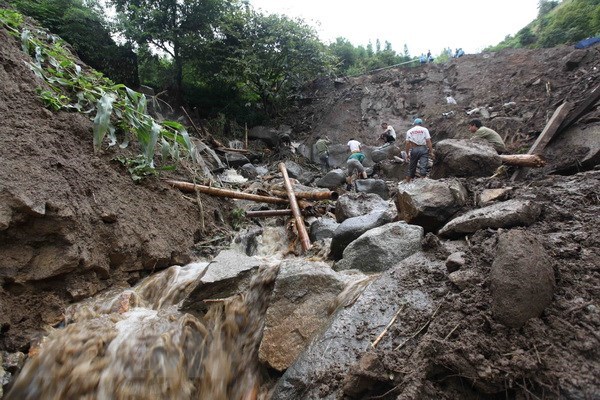 In Vang Ma Chai commune, Lai Chau province Floods and landslides in Phong Tho district of the northern mountainous province of Lai Chau left six dead, six missing and three others injured, according to the Central Steering Committee for Natural Disaster Prevention and Control. From August 4-5, heavy rains inundated five houses, 2ha of aquaculture and 2ha of paddy fields in the northern province of Bac Kan, causing estimated losses of nearly 200 million VND (8,600 USD). Rainfalls also damaged 97 houses, 30.5ha of rice, 0.3ha of vegetables and aquaculture in the northern province of Lao Cai. The total damage is estimated at roughly 2.6 billion VND. A landslide in the northern province of Son La on August 5 also caused traffic congestion. The traffic is expected to be back to normal on August 7. The committee asked northern mountainous provinces to continue checking areas highly prone to floods and landslides, stay ready with plans to ensure safety for local people and property as well as respond to low pressure. They must closely track news warning floods and landslides and promptly report abnormal phenomena to authorities. In Hanoi, it urged operating water pumping stations to ensure drainage in the outlying district of Chuong My, prepare for equipment to prevent epidemic outbreaks in affected areas, and ensure clean water supply to local people. The provinces of Son La, Hoa Binh and Tuyen Quang were requested to ensure safety when reservoirs flush out floodwater. The coastal cities and provinces from Quang Ninh to Khanh Hoa were assigned to closely follow the movement of low pressure in the East Sea to promptly alert captains and owners of vehicles. Nha Trang seeks to ease beachfront traffic 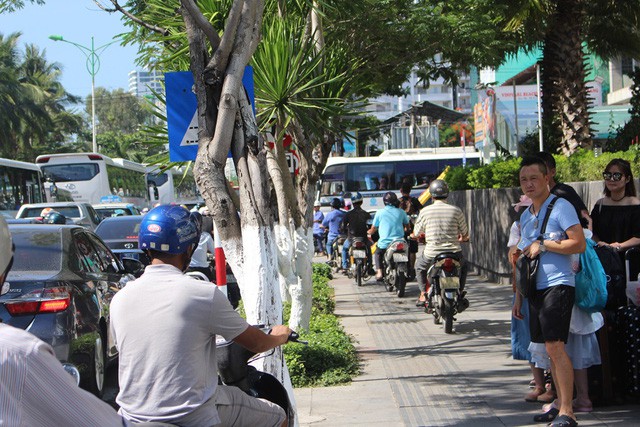 Traffic jam on Tran Phu Street Authorities of the central city of Nha Trang, Khanh Hoa Province, have decided to ban coaches of more than 29 seats from the beachfront road of Tran Phu. The move is aimed to ease traffic jams caused by big coaches for the street during weekends and holidays. Nha Trang has welcomed a large number of foreign tourists, particularly those from China and Russia and the sharp rise in tourist number has caused pressure on the city’s roads, particularly Tran Phu Street where is home to many hotels and services. At weekends, traffic jams for kilometres often happen on Tran Phu, which is mostly attributed to 45-seater coaches. The provincial people’s committee has also urged Nha Trang City to tighten control over car parking on Tran Phu Street, particularly at the section crossing between Yersin and Le Thanh Ton streets. Red Cross launches volunteer quick-reaction team 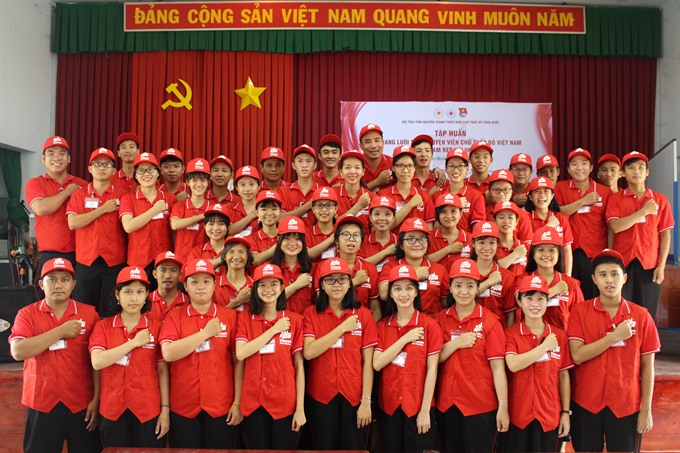 The Việt Nam Red Cross Society’s Central Committee launched a volunteer quick-reaction team for disaster relief and humanitarian activities. Photo Courtesy of VTV Corp The Việt Nam Red Cross Society’s Central Committee has launched a volunteer quick-reaction team for disaster relief and humanitarian activities in the country. The Việt Nam Red Volunteer team includes 50 volunteers trained in first aid and assistance for victims of natural disasters. The Red Cross is encouraging all provinces and cities to set up their own volunteer teams. The launch occurred on the occasion of the Volunteer Campaign even held in the Mekong Delta city of Cần Thơ from August 2-4. The Volunteer Campaign has attracted more than 500 members of the Việt Nam Red Cross Society in Việt Nam and 13 other countries that belong to the International Federation of Red Cross and Red Crescent Societies. Participants attended conferences on healthcare services for the community and climate change, and engaged in competitions on first-aid skills and handling disaster situations, and charity activities for the disadvantaged in Cần Thơ. Health ministry checks anti-dengue efforts around country  The Ministry of Health is inspecting preventive methods against dengue fever in 16 provinces and cities that have seen an upward trend of the disease. The Ministry of Health is inspecting the preventive efforts in place against dengue fever in 16 provinces and cities where the disease is seeing an upward trend. According to Đặng Quang Tấn, deputy head of the ministry’s General Department of Preventive Medicine, the incidence of dengue in these provinces and cities has increased in the last three weeks. In Hà Nội, for instance, the number of cases doubled to 26 on July 23-29 from a week earlier. Bình Phước Province has reported 1,055 cases this year, an increase of 27 per cent. According to Nguyễn Văn Dũng, deputy head of the province’s Preventive Health Centre, the average temperature of 25-30 degrees Celsius there is ideal for mosquitoes, the disease vector, to breed. Moreover, locals have a habit of using clay pots and plastic barrels to store water, but often not covering or cleaning them, leading to mosquitoes laying eggs in them. So far this year nearly 35,000 people in the country have been infected with dengue, with one each dying in HCM City and the eight provinces of Khánh Hòa, Bình Dương, Bình Phước, An Giang, Đồng Nai, Bình Định, Trà Vinh, and Cà Mau. The ministry has provided insecticides and other materials required to combat the disease to all provinces and cities, especially the 16 where its incidence is increasing. It has also called on local administrations to strengthen preventive efforts and encourage people to practise hygiene and destroy mosquito larvae regularly. The preventive medicine department has warned that the only way is to kill mosquitoes and larvae to prevent mosquitoes from biting people since there is no cure for dengue or vaccine. The ministry has instructed local preventive health officials to keep an eye out to detect signs of outbreaks early. Hospitals that admit dengue patients should report to preventive health centres so that they can take the initiative to monitor patients’ communities. Tấn said people with high fever during the day should go to the nearest health facility for timely treatment. Dengue is a viral disease transmitted by female mosquitoes, mainly of the species Aedes aegypti and, to a lesser extent, Ae. albopictus. This mosquito also transmits chikungunya, yellow fever and Zika. Dengue is widespread throughout the tropics, with local variations in risk influenced by rainfall, temperatures and unplanned rapid urbanisation. In Việt Nam, unlike in the past dengue occurs throughout the year, with large outbreaks occurring during the rainy season. Smart city control centre opens on Phú Quốc Island 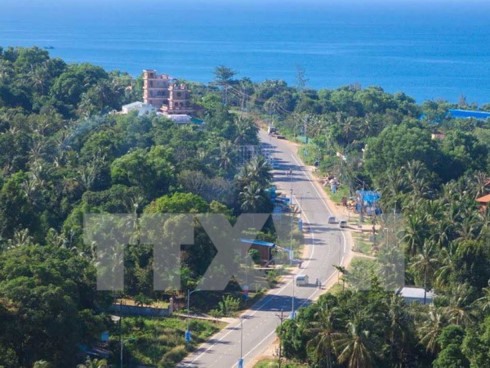 Phú Quốc Island in the Cửu Long (Mekong) Delta province of Kiên Giang aims to become a smart city by 2020. A smart city control centre that opened on Phú Quốc Island on Wednesday will receive residents’complaints and coordinate emergency functions, among other functions. Phạm Văn Nghiệp, deputy chairman of the People’s Committee of Phú Quốc District, said the centre would receive information from citizens, visitors and organisations about theft, security problems and other complaints; improve traffic safety, and co-ordinate emergency responses and other activities. Việt Nam Post and Telecommunications (VNPT) has helped the island build a safe city solution with mobile apps that help people report incidents (accidents, theft, acts that violate urban security) to management agencies and help the latter respond quickly. The residents must install the “Safe City” app on their smartphone. The VNĐ67 billion (US$2.9 million) project, invested in by VNPT under the smart city project for Phú Quốc by 2020, was approved by the Kiên Giang Province People’s Committee in April last year. The project was based on VNPT’s information communications technology infrastructure and the province’s e-governance system. Phú Quốc authorities have also completed a public wi-fi system that provides free access in Dương Đông and An Thới towns. As many as 50 camera monitors also link with the smart city control centre in Phú Quốc Island. For online management of visitors, VNPT has trained over 90 police officers and workers at 200 guesthouses and hotels on the island. Hotels no longer need to take guests’ passports to the local police station for registration. To monitor the environment, VNPT and local authorities have built stations to supervise household wastewater treatment, and air and seawater pollution. The e-government system links administration from the commune to the provincial level, which helps people and enterprises in the district complete procedures online for licences or business registration. Phú Quốc in the Mekong Delta, Bắc Vân Phong in central Khánh Hòa Province, and Vân Đồn in northern Quảng Ninh Province are expected to become special administrative-economic units. Phú Quốc is Việt Nam’s largest island, covering an area of nearly 600 square kilometers with a population of over 100,000. Điện Biên children risk lives fishing for wood 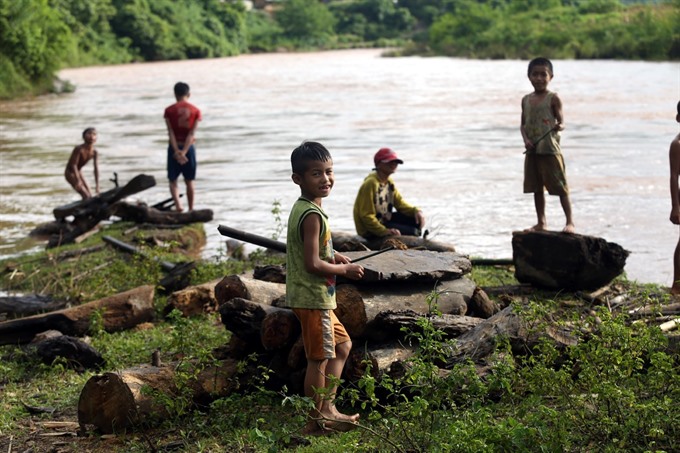 Children risk their lives collecting wood after heavy flooding. Children living near Nậm Mức stream in Búng Giắt Village in the northern mountainous province of Điện Biên are risking their lives collecting wood from the swiftly-flowing floodwaters. A Vietnam News Agency reporter observed a group of ten children (the oldest of about 13) took advantage of high water to jump into the stream and catch wood floating by. Torrential rain over recent weeks has caused landslides and increased water levels in streams and rivers of northern mountainous provinces. One of the children told the reporter that each time it rains heavily, children around the area head to the stream and collect wood to sell. If they are not quick enough to grab the wood, others will take it. So each time they see a promising log or branch, they swim as hard as they can in the flood water to grab hold of it. Lò Văn Dôm, a local from the Mường Mươn Commune of Mường Chà District said that parents have warned children about the risk involved but the children have so far ignored their pleas. In spite of efforts by local authorities to remind residents about the risk of wading into floodwaters, many families are still not aware of protecting themselves and their children. Last year the province recorded several deaths caused by catching wood and fish in dangerous flood water currents. Hai Phong: Modern infrastructure deemed prerequisite for tourism growth 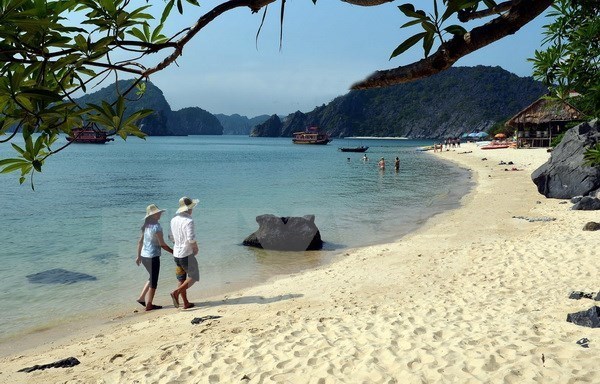 A beach on Khi (Monkey) Island of Cat Ba archipelago in Hai Phong After the sea-crossing bridge of Tan Vu – Lach Huyen opened on September 2, 2017, tourist arrivals in Cat Ba island district of northern Hai Phong city surged by 150 percent year on year from then to May 2018. In the first half of this year, Cat Ba Island welcomed more than 1.5 million visitors. Holidaymakers arrived even in the winter, said Vu Tien Lap – head of the culture, sports and tourism division of Cat Hai district. This sharp rise was partly attributed to the considerable improvement in local infrastructure, which also saw the opening of Cat Bi International Airport and Ha Noi – Hai Phong Expressway in recent years. With tourism considered a key economic sector, the city has been working to attract big investors to develop tourism facilities. At a recent meeting of municipal officials, Secretary of the Hai Phong Party’s Committee Le Van Thanh reiterated the necessity of building infrastructure serving tourism development. He noted that the city hopes to attract 7.5 million tourists by 2020. This figure rose from 5.96 million in 2016 to 6.71 million in 2017. It reached 3.41 million between January and June and is expected to hit 7.79 million this year. Major developers like SunGroup, Vingroup and Flamingo have been building five-star hotels and other tourism facilities in Cat Ba and other places in the city. In 2019, Sungroup plans complete a 5.1km-long cable system from Cat Hai town to Phu Long commune and carry out a tourism project in Cat Ba. The city sees beautiful landscapes, world-class tourism facilities and modern infrastructure as key to luring vacationers. Meanwhile, ensuring security and safety for tourists and service to their satisfaction will persuade them to return to Hai Phong. Local tourism has also benefited from the city’s investment attraction policy, which has resulted in a big number of foreign workers arriving. About 2,000 experts have come to build automobile and mobile phone factories in Cat Hai. Many others from Japan, the Republic of Korea, the US and Europe have also stayed here to work on other investment projects. In its development plans, the tourism sector of Hai Phong hopes to increase coordination with relevant agencies to improve tourism quality. It will also try to attract investors to make the city a key tourism destination of Vietnam. Farmers pleased as Đồng Nai encourages large-scale fields, co-operatives  A large-scale rice field in Đồng Nai Province’s Trảng Bom District. – Photo dnrtv.org.vn The pooling of fields to create large-scale fields and co-operatives for growing clean produce in Đồng Nai Province has benefited farmers and companies. While most pepper farmers in the south-eastern province have suffered losses for the past two years because of the sharp decline in prices, more than 750 households growing pepper in Cẩm Mỹ District have earned profits by pooling their lands. Their Lâm San Agriculture Co-operative in Lâm San Commune exports the spice to the EU. Nguyễn Văn Quang, one of the members, said the co-operative guarantees purchase of the entire pepper output at VNĐ10,000 – 20,000 a kilogramme higher than the market price. Thus, the households do not suffer losses though pepper prices have fallen, he said. Under the large-scale field model, farmers with contiguous lands grow the same crop using the same techniques and schedules and are instructed by a company or, a co-operative (if they are members). Nguyễn Quý Tân, whose land has been part of a large-scale cacao field in Định Quán District’s Gia Canh Commune for three years, said since joining he had not been worried about prices. The Trọng Đức Cacao Products Limited Company, which helped establish the large-scale field, pays him VNĐ1,000 – 2,000 higher than market prices per kilo, he said. In the past cacao prices had been volatile and sometimes fell by VNĐ2,000 a kilogramme, he said. If the company had not overseen the setting up of the large-scale field, he would cut down his cacao trees to plant other crops, he said. “After I tied up with the company, I feel secure.” Huỳnh Thành Vinh, director of the province’s Department of Agriculture and Rural Development, said the establishment of large-scale fields and co-operatives to grow clean crops yielded positive results. However, their number in the province was not large, he said. He attributed this to farmers and companies not achieving benefits, the lack of markets, insufficient support from the authorities, and the small size and scattered nature of farm lands. Đồng Nai has 18 large-scale fields with a total area of nearly 6,000ha pooled by around 5,000 participating households, according to the Department of Agriculture and Rural Development. The area accounts for 2 per cent of the province’s arable lands. To ensure sustainable development of agriculture, the province has called on farmers and companies to strengthen their co-operation and simplified access to preferential credit and land policies. It will also co-operate with other agencies to provide farmers, co-operatives and companies with market information, especially about key local agricultural produce. "When authorities do a good job of forecasting the market, companies and co-operatives know precisely about the market’s demand and strengthen collaboration with farmers to set up large-scale fields to grow the crops that are in demand," Vinh said. The province plans to help managers of co-operatives acquire management skills and participate in trade promotion activities in the country and abroad. Viet Nam speeds up plastic free ocean initiative 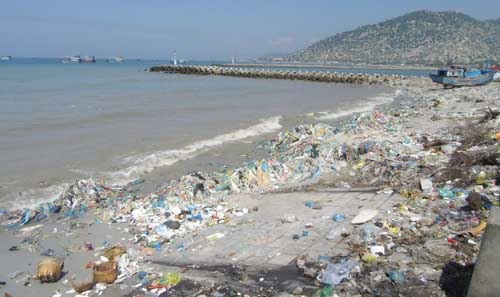 Plastic waste is seen along the coast of Phước Diễm in the central province of Ninh Thuận. Minister of Natural Resources and Environment Trần Hồng Hà has assigned the Việt Nam Administration of Sea and Islands to take responsibility for managing the plastic waste that is blighting the seas. The move is part of Việt Nam’s efforts to build regional partnerships to manage plastic waste in Southeast Asia as well as a global mechanism to promote clearing the world’s seas. The initiative was proposed at the 6th Global Environment Facility (GEF-6) Assembly in Đà Nẵng in June. The initiative aims to promote co-operation and experience sharing among local and international organisations, and calls for changes to economic growth models with a focus on recycling instead of consumption. According to the World Economic Forum, about 8 million tonnes of plastic waste was discharged into the oceans every year, while about 3 billion people rely on the oceans to earn a livelihood. Environment Minister Trần Hồng Hà said that Việt Nam was committed to reducing plastic, and in the long term, working to eliminate the issue all together. Director general of the sea and islands administration, Tạ Đình Thi, said Việt Nam was one of the world’s 20 worst polluters of plastic waste, releasing 500,000 tonnes per year. "We are among six countries in the Southeast Asia region that has yet to build a waste management system,” he said. He added that the country had witnessed the dangers of plastic pollution to the oceans, food chains and marine species. Five sentenced to death in major drug trafficking case 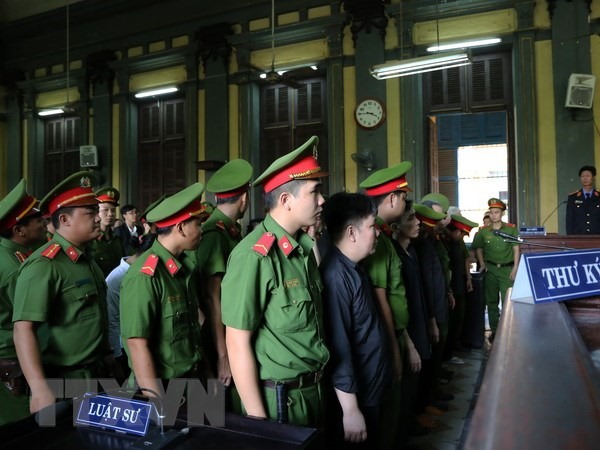 The People’s Court of HCM City has handed down the sentence of capital punishment to five defendants involved in the illegal trade and transportation of drugs. The People’s Court of HCM City has sentenced to death five defendants involved in the illegal trade and transportation of a large amount of drugs at the end of a four-day trial on Thursday. Among the defendants sentenced to death is ring leader Nguyễn Văn Phú, born in 1964. In addition to the five, four others in the ring, which smuggled drugs from Cambodia to Việt Nam and from the north to HCM City for sale, were sentenced to life in prison. Another three received sentences ranging from five to 20 years in prison. The defendants were also ordered to pay fines of VNĐ20-200 million (US$859.39 – 8,593) as an additional punishment, along with paying back the money they got from trafficking. Ring leader Phú must pay back VNĐ340 million ($14,606) from illegal proceeds from drug trafficking. On November 16, 2015, the police caught Trần Thanh Cương red handed as he trafficked 15 bricks of heroin weighing 5.2 kg, along with VNĐ50 million and $5,000 in cash. Cương confessed that he bought the drug from Phú. Phú was arrested later along with two bricks of heroin. During the investigation from January 9-11, 2016, the police arrested more people involved in the drug ring. According to the investigation agency, the traffickers traded over 20 kg of heroin and over 17 kg of synthetic drug. Phú said he bought the heroin at VNĐ210 million per kg and sold it at VNĐ220 million. From August to November 2015, Phú bought a total of 47 bricks of heroin and sold 45 to Cương. A/H5N6 bird flu detected on Hải Phòng farms 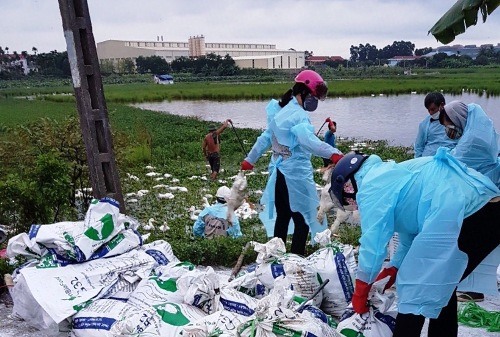 Poultry infected with the bird flu A/H5N6 virus are collected and disposed of in Hải Phòng City’s An Dương District. — Photo vnexpress.net More than 10,000 chickens and ducks on two farms in An Dương District, the northern city of Hải Phòng have been infected with the A/H5N6 bird flu virus, Vice Chairman of the district People’s Committee Lê Văn Cường confirmed on Thursday. The announcement came after samples taken from the dead poultry tested positive for the virus. Cường said local authorised agencies culled all the infected poultry, sprayed chemicals at the two farms and examined surrounding farms to make timely interventions. About two weeks ago, over 5,500 chickens and ducks at a farm in the district’s An Hưng Commune suffered from diarrhea and died, even though they were vaccinated already. On July 27, similar symptoms were found among 4,650 ducks at a farm in An Hồng Commune. After that, Hải Phòng’s Livestock Production and Animal Health Departments took samples for testing. According to World Health Organisation, the A/H5N6 bird flu virus killed people in China, but there is no evidence to prove it could be transmitted from person to person. The Ministry of Health called on localities to strengthen oversight and detect the virus for timely interventions. The localities were also asked to tighten controls to curb poultry smuggling. The Plays Festival to honour late Lưu Quang Vũ playwright The Việt Nam Youth Theatre will perform a series of plays at the Lưu Quang Vũ’s Plays Festival from August 4 to September 1 in Hà Nội. The festival will feature Lời Nói Dối Cuối Cùng (The Last Lying Words), Hoa Cúc Xanh Trên Đầm Lầy (Green Daisy on Marsh), Ai Là Thủ Phạm (Who is the Culprit) and Lời Thề Thứ 9 (The Ninth Oath). The festival commemorates the 30th anniversary of the death of playwright Lưu Quang Vũ, who is regarded as an influential author in the country’s theatrical renewal process. "The Last Lying Words is one of the most successful plays at the Youth Theatre," said Trương Nhuận, the theatre’s former director. "The play is Vũ’s message about the truth against the lie. It awakes people to social evils such as achievement-addiction, corruption and authoritarian behaviour by local officials." The play was written based on Vietnamese folk tales and features a love triangle where deceit and music are the order of the day, with country girl Lụa tricked by deceitful boy Cuội. The play debuted in 1986, directed by People’s Artist Phạm Thị Thành. During her career she staged more than 200 plays, including 25 by Vũ. "Vũ always gave me his new works to read," said Thành. The play was named Cuội, Bờm and Lụa at first. After Thành read the script she suggested changing to The Last Lying Words to give the name a broader meaning. "The plays by Vũ reflect the darker side of society. But he always highlighted human dignity and he always believed in the truth, the fair and the ideal," Thành said. Vũ was born in the northern province of Phú Thọ, although his father, playwright Lưu Quang Thuận, came from the central province of Quảng Nam. Vũ served as a soldier in the anti-American War from 1965-70, when his poems began to gain recognition. But it was in the 1980s that he became a celebrated poet, writing about life in the post-war period and during the process of national renewal in the late 1980s. His dramas, short stories and poems were charactised by their gritty realism and great humanity. He wrote some 50 dramas, most of which criticise the darker side of society, especially corruption and authoritarian behaviour. Many of them earned high literary acclaim. He was married to fellow poet Xuân Quỳnh, whose poem Sóng (Wave) became standard reading material in secondary schools. The couple died in a car crash in 1988 when travelling from Hải Phòng city back to their home in Hà Nội. Their 12-year-old son was also killed in the accident. The country’s highest awards, the Hồ Chí Minh Prize in art and literature, were posthumously given to Vũ in 2000 and Quỳnh in 2017. The festival will be held at the Youth Theatre, 11 Ngô Thì Nhậm Street. Vietnamese rapper Suboi scores another first with 88rising video Rap queen Suboi has become the first Vietnamese artist to release a music video on 88rising's YouTube channel. The 28-year-old Vietnamese female rapper premiered her music video for “N-SAO?” (Why?) on the YouTube channel of 88rising, a famous American mass media company that has gained popularity as a musical platform for Asian artists. This is not the first time that Suboi has appeared on 88rising. She had previously introduced herself to international audiences when she performed “Doi" (Life) live on this channel in November 2016. The music video for “N-SAO?” is directed by German filmmaker Alexa Karolinski and shot in Saigon. The video depicts images of ordinary life in Saigon, from that of lottery ticket sellers to late night workers against the background of street diners to old apartments. Suboi dons many interesting outfits from tank tops with baggy pants, floral suits with flip-flops to “street ninjas” dresses usually worn by Vietnamese women as suncoats on hot summer days. The “N-SAO?” audio had previously premiered on Apple’s Beats 1 radio on July 18, making Suboi the first Vietnamese artist featured on the 24/7 international radio channel. “N-SAO?”, produced by American producers Zach Golden and Pat McCusker is a bouncy, trap infused banger laced with lyrics that give shout outs to Saigon’s traffic, iced coffee, street vendors and Suboi’s native District 3. With this single, Suboi has presented a more mature and fashionable image to her fans. Since being introduced to hip-hop music at the age of 14, Suboi has released two studio albums, one extended play and become a prominent act on Vietnam’s rap music scene. Often referred to as the “Vietnamese rap queen,” she was featured on Forbes Asia’s “30 Under 30” list in 2017, became the first Vietnamese artist to perform at 2015 SXSW Music Festival in the US and famously rapped for former US president Barack Obama when he visited Vietnam in 2016. She also founded her own company, Suboi Entertainment and has acted in two Vietnamese movies. “N-SAO?” is available on several domestic and international music platforms, including Zing, Nhaccuatui, Apple Music, Spotify and Google Play. Vietnam recalls 57 heart drugs with cancer-causing substance Vietnam's health ministry has recalled 57 types of cardiac medications found to contain a carcinogen made by a Chinese firm. The Drug Administration of Vietnam said the recalled drugs contained valsartan, a substance produced by a firm in China which was found to have N-nitrosodimethylamine (NDMA), which can cause cancer if used over a long period. It said 32 of the drugs recalled were processed in Vietnam and 25 were imported. The made-in-Vietnam drugs were produced by 13 companies that imported valsartan from Chinese firm Zhejiang Huahai Pharmaceutical Co., Ltd. The imported drugs originated in Bangladesh, India, Poland, the Republic of Korea and Spain, but producers in these countries also bought valsartan from the same Chinese producer to make the drugs, the administration said. In Vietnam, the cardiac medications that contain valsartan are used to treat high blood pressure, heart failure and deal with the aftermath of heart attack. The administration has issued a list of the 57 drugs that it wants to recall and requested producers and importers across the country to stop selling or using those drugs, and recall them as soon as possible. It has also assured patients that the recall is unlikely to lead to a shortage of cardiac drugs, because there are currently 39 made-in-Vietnam drug types and 54 imported ones that contain valsartan without the cancer causing substance like the one produced in China. Valsartan was initially developed by Swiss firm Novart and was sold on the market under the trade name Diovan. When Novart’s monopoly protection for the drug expired, many brands jumped in to make the drug, including Zhejiang Huahai Pharmaceutical. The European Medicines Agency and several other countries withdrew medications that contain valsartan produced by Zhejiang Huahai Pharmaceutical in July, confirming that it contained N-nitrosodimethylamine. Sustainable development associated with gender equality 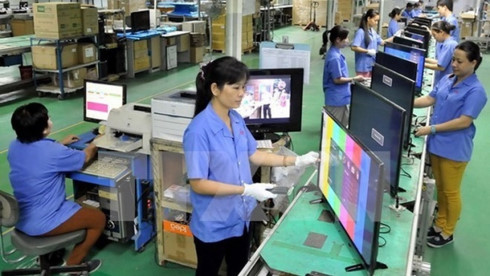 Ensuring gender equality and narrowing inequality are included in the 17 Sustainable Development Goals (SDGs) of the UN 2030 Agenda, agreed upon by leaders of the 193 UN member states in 2015 aiming to deal with the challenges of comprehensive socio-economic development and assure environmental sustainability and good governance. These are considered solid guidelines for the Vietnamese business community to embark on their journey at a national level. According to the UN 2030 Agenda, the Government is responsible for providing guidelines by devising concrete national plans to create a favourable environment for each citizen to learn about the importance of the agenda. Businesses have played an indispensable role in achieving SDGs. The successful implementation of SDGs will help businesses create a more favourable environment for their operations and conquer the global market. The behaviour of enterprises has been key to the success of each goal through responsible business activities, including the responsibility for ensuring gender equality and reducing inequality. Recent research by McKinsey has found that companies which embrace gender diversity can perform their activities 15% better than their competitors. A common report of Intel and Dahlberg has shown that technological companies with at least one female leader have a business value of 13%-16% higher than those with male leaders. Furthermore, a survey conducted by First Round Capital has indicated that their investments in companies whose founders are female have reaped 63% better rewards than their investments in firms whose founders are male. Vietnam has introduced the issue of gender equality in the workplace and consider it as one of the major focuses for the country’s socio-economic progress. Therefore, women have made certain achievements in gender equality, especially in education and health. According to the General Statistics Office (GSO), in 2017 the share of leadership roles occupied by women had risen to 28%, which is higher than the world average of 19% and higher than the average of Organisation for Economic Co-operation and Development (OECD) nations. The rate at which women are participating in the workforce in Vietnam is relatively high, with up to 72% of the country’s total female population working and accounting for 48.1% of the labour force. According to the report ‘World Employment and Social Outlook: Trends for Women 2018’ released by the International Labour Organization (ILO), Vietnam is among the nations with the highest rate of women in the workforce and that this greatly contributes to the country’s economic development. However, female workers face a number of hurdles in their employment and incomes. The report has shown that although female workers make up 48.4% of the total workforce in Vietnam, the rate of employment for women is 9% lower than for men. At present, about 7.8 million of all female workers are working in unofficial sectors with insalubrious working conditions. The rate of female workers operating in the unofficial sector with substandard conditions makes up 59.6% while this rate is only 31.8% for men. In another area of disparity, the monthly income for male workers is 10.7% higher than for women (VND5.3 million compared to VND4.7 million). Director of the ILO Research Department Damian Grimshaw affirmed that challenges and barriers to women’s full and free participation in the workforce will restrict Vietnam’s ability to realise its economic growth roadmap along with social development. The ILO representative said the UN Agenda 2030 with 17 SDGs including gender equality is obviously a call to businesses to sustain their efforts during the journey of advancing toward a global economy of equity, sustainability and integration. The fulfillment of SDGs in the 2015-2030 period is needed for Vietnam to realise its aspiration for a new level of prosperity, innovation, equity and democracy by 2035. The promotion of gender equality in the workplace applies to the use and development of human resources, which will directly impact labour productivity, and the efficiency of enterprises. By boosting the operational productivity of enterprises, the promotion of gender equality is regarded a strategic investment which delivers sustainable growth and development. VNN |
↧
Article 3
Tackling credit shortage for SMEsHÀ NỘI - State authorities, financial institutions and enterprises must sit together to tackle credit shortages for small- and medium-sized enterprises.
Loans provided to SMEs account for just 21 per cent of total outstanding loans. Although the State authorities and banks have been more open to lending to SMEs, up to 60 per cent of these businesses are still unable to access or use bank capital. — Photo dantri.com.vn Chairman of the Việt Nam Chamber of Commerce and Industry (VCCI) Vũ Tiến Lộc made the statement at the forum titled ‘Solutions to improve capital access for SMEs’ held on Tuesday in Hà Nội. Việt Nam’s business climate has improved substantially over 30 years of renovation and development, but capital shortage remains the biggest obstacle hindering the growth of SMEs, Lộc said. Loans provided to SMEs account for only 21 per cent of total outstanding loans. Although the State authorities and banks have been more open to lending to SMEs, up to 60 per cent of these businesses are still unable to access or use bank capital. At the same time, not all enterprises have the capacity to raise capital from other channels such as issuing shares or bonds. Meanwhile, SME development funds do not work effectively, Lộc said. The SME Development Fund, set up in 2014 with total capital of VNĐ2 trillion (US$87 million), has so far lent VNĐ145 billion to 19 businesses, the forum heard. According to Lộc, the credit crunch for SMEs is blamed on three parties. “The first is the State whose representatives are the State Bank of Việt Nam and other relevant ministries and agencies. The second is banks and financial institutions, and the third is the micro, small and medium-sized enterprises,” Lộc emphasised. On the State side, there are still many legal regulations that do not encourage investment and creative businesses, according to Lộc. He said State management has yet to accept risks while regulations on land-use rights do not create favourable conditions for businesses to access bank capital. Meanwhile, banks and other financial institutions are still in favour of State-owned enterprises and enterprises having asset collateral. However, Lộc said the digital economy and startup and agricultural businesses do not have a lot of assets. Thus, he suggested that banks consider accepting mortgages in the form of ideas, business and production plans which will stimulate startups and creativity. On the business side, about 670,000 enterprises are doing business in Việt Nam, of these SMEs make up 98 per cent. If including over five million household businesses, the number of micro, small and medium-sized enterprises is about six million units. Many of them have low transparency and weak governance that make it hard to build trust among banks. “Three parties need to sit together. The parties need to improve relations, not just the ask-give mechanism but the symbiotic relationship between banks and enterprises, and funds and enterprises,” the VCCI’s chairman said. Tailor-made credit According to VCCI, banks should introduce new lending methods including investment-oriented lending packages for startup and agricultural businesses based on ideas and business plans. “The current mode of bank lending should be tailor-made, not ready-made, and encourage value-chain lending,” Lộc said. Nguyễn Quốc Hùng, head of the central bank’s Credit Department, admitted that SMEs still faced difficulties in accessing bank loans, not only because they lack collateral but also many do not attach much importance to updating their business activities and preparing financial statements. Their financial data is often slowly updated, inaccurate and not reviewed by independent audit. According to Hùng, enterprises must prove their business plan to be able to pay debts. As the risk is huge if providing loans without collateral, Hùng suggested building a mechanism to tackle risks associated with loans for SMEs. According to financial expert Cấn Văn Lực, the State authority needs to quickly implement an effective legal framework for supporting SMEs, at the same time strengthening the role of business associations and co-operation among financial institutions and credit guarantee funds. Meanwhile, small businesses should also improve transparency, disclosure and willingness to work with credit institutions to prove their corporate governance and strategic and financial capacity. VNS |
↧
Article 2
Ecommerce on the rise as customers go mobile The popularity of mobile e-commerce in Vietnam has seen its strongest yearly growth with the usage of e-payment systems increasing at an estimated rate of 22% per annum.  Smart phones have been the medium for 72% of the total hits on e-commerce websites, while 53% of online shopping transactions have been conducted via mobile platforms. According to Appota’s report on Vietnam’s mobile application market in the first half of the year, the number of online shoppers in Vietnam is estimated at 35.1 million, generating more than US$2 billion in revenue. That figure is predicted to reach 43.9 million with revenue surpassing US$4 billion by 2022 The statistics show that the number of people goods purchasers through Facebook, accounted for 67% of online shopping in 2016 and that figure rose to 83% in 2017. The report indicates that the millennial generation (18-35 age group) has made up 82% of shares of Vietnam’s e-commerce market. This is the most important segment for retailers and online service providers. HCM city has the biggest online shopping market with 38%, trailed by Hanoi (17%), Can Tho (3%), Da Nang (3%) and Hai Phong (1%) while the remaining localities hold 39%. The findings of another report, by iPrice, also show that mobile platforms have contributed a large number of hits of e-commerce websites. Vietnam has the lowest rate of e-commerce website access in South-East Asia but posted the strongest growth over the past year. Statistics indicate a 26% increase in the number of unique visitors to e-commerce websites using mobile devices. Strong growth after 2016 pointed to a gradual rise in the number of Vietnamese consumers using smart phones for online shopping. This requires retailers and service providers to design e-commerce channels which are smart phone compatible. In addition, the use of work computers for shopping has increased 12% compared to 2016. Up to 53% of online shoppers use smart phone browsers to purchase goods, while 52% of online shoppers use mobile applications to buy goods. According to experts, the use of mobile devices is now a common trend among consumers purchasing goods online and there has been a remarkable increase in consumers’ dependence on smart devices for their shopping habits. At the recent Mobile Ecommerce Day 2018, Sapo Web released the statistics of visits to its system of more than 33,000 customer websites, more than 60% of visitors to e-commerce sites are from mobile phones (up 5% over last year) while the remaining proportion arrive from desktop and tablet. The latest report from iPrice shows that the growth of visitors using smartphones in South East Asia and Vietnam in particular has seen continued growth during the year, accounting for 72% of the total hits on e-commerce websites. However, the iPrice study shows one downside to the positive growth in the number of hits from mobile phones using mobile shopping apps, the percentage of visitors completing the checkout process on mobile is not as high as with PCs. The conversion rate from online shop personal computers is much higher than mobile devices, while the average value of online shopping carts also differs between the two devices. For example, the conversion rate among Vietnam’s online shoppers while using computers is 3.6 and the rate for mobile users is only 1.4. The average value of an online shopping cart on PCs is US$26 and US$23 on mobile devices. The difference in shopping habits between mobile and computer shows that Vietnamese people often search and study products on their phones before completing the purchase of goods on computers. Many e-commerce websites B2C like Lazada, Tiki, and Sendo have consistently had the highest traffic and posted constant growth. A representative from Lazada Vietnam said that since the beginning of the year, the number of online shoppers using Lazada’s mobile applications has increased 60% and the quantity of orders through their mobile apps accounts for 70% of total orders. However, the e-commerce industry faces a stumbling block on the path to sustainable development for a lack of consumer trust in the quality of online products. Up to 44% of consumers report being dissatisfied with the quality of goods purchased online. Low consumer confidence remains the biggest hindrance for buyers completing the checkout process. Feelings of security are the key factor in consumer’s willingness to buy online. In addition, businesses are confused about ensuring the standard of design for mobile platforms which meets customer demands and will increase the rate of conversion for shopping. Mr. Tran Trong Tuyen, CEO of DKT Technology —which has just launched Sapo X, the first multi-channel management and sales platform in Vietnam — said many businesses have lost revenue as they have neglected improvements to their online shopping apps in order to provide customers with new shopping experiences and maximize the mobile conversion. To accomplish this, businesses need to research consumer behaviour and take advantage of applications and features to optimize the efficiency of advertising and selling goods on the now ubiquitous smartphone. VOV |
↧
More Pages to Explore .....


